Star Wars: Knights of the Old Republic, often shortened to Knights of the Old Republic or KotOR, represents a comic book series, published monthly by Dark Horse Comics, which spanned four years. It commenced on January 25, 2006, and concluded with its 50th edition on February 17, 2010. Penned by John Jackson Miller, Knights of the Old Republic showcased the artwork of numerous artists and cover illustrators across its run. Functioning as a follow-up to the earlier comic series Star Wars: Tales of the Jedi and a lead-in to the acclaimed Star Wars: Knights of the Old Republic video game, KotOR is set in 3964 BBY, progressing into 3963 BBY. The narrative of Knights of the Old Republic is centered around Zayne Carrick, a Padawan within the Jedi Order, who is wrongly accused of the Padawan Massacre—the killing of his fellow Padawans. The actual perpetrators are his instructors, members of a secretive Jedi Covenant. Joining forces with the scam artist Marn Hierogryph, the spirited Jarael, and the peculiar Camper, Carrick becomes a fugitive, striving to prove his innocence by unveiling the Covenant's existence. After successfully clearing his name, Carrick partners with Hierogryph and Jarael, but the trio and their allies soon find themselves embroiled with the Crucible, a slaving syndicate.
Knights of the Old Republic served as the premier series for Dark Horse Comics' 2005 revitalization of their Star Wars line, marking their 20th anniversary. It rapidly ascended to become one of Dark Horse's top-selling publications. In 2008, Knights of the Old Republic presented the initial quartet of issues for the Vector crossover event, which extended across all four of Dark Horse's concurrent Star Wars series at that time. The narrative of Knights of the Old Republic incorporated numerous allusions to both Tales of the Jedi and the Knights of the Old Republic games. The series also significantly broadened the scope of the Mandalorian Wars, which were initially introduced in the video games. Preceding the series was a prequel issue, and it also featured a companion Handbook. During the Baltimore Comic-Con in 2009, Dark Horse declared that the series would conclude with its fiftieth installment, Demon, Part 4, in February 2010. In 2012, Miller also wrote a sequel miniseries that took place a year later, Star Wars: Knights of the Old Republic: War. Furthermore, aspects of Knights of the Old Republic have been integrated into subsequent Star Wars media, such as the Star Wars: The Old Republic video game.
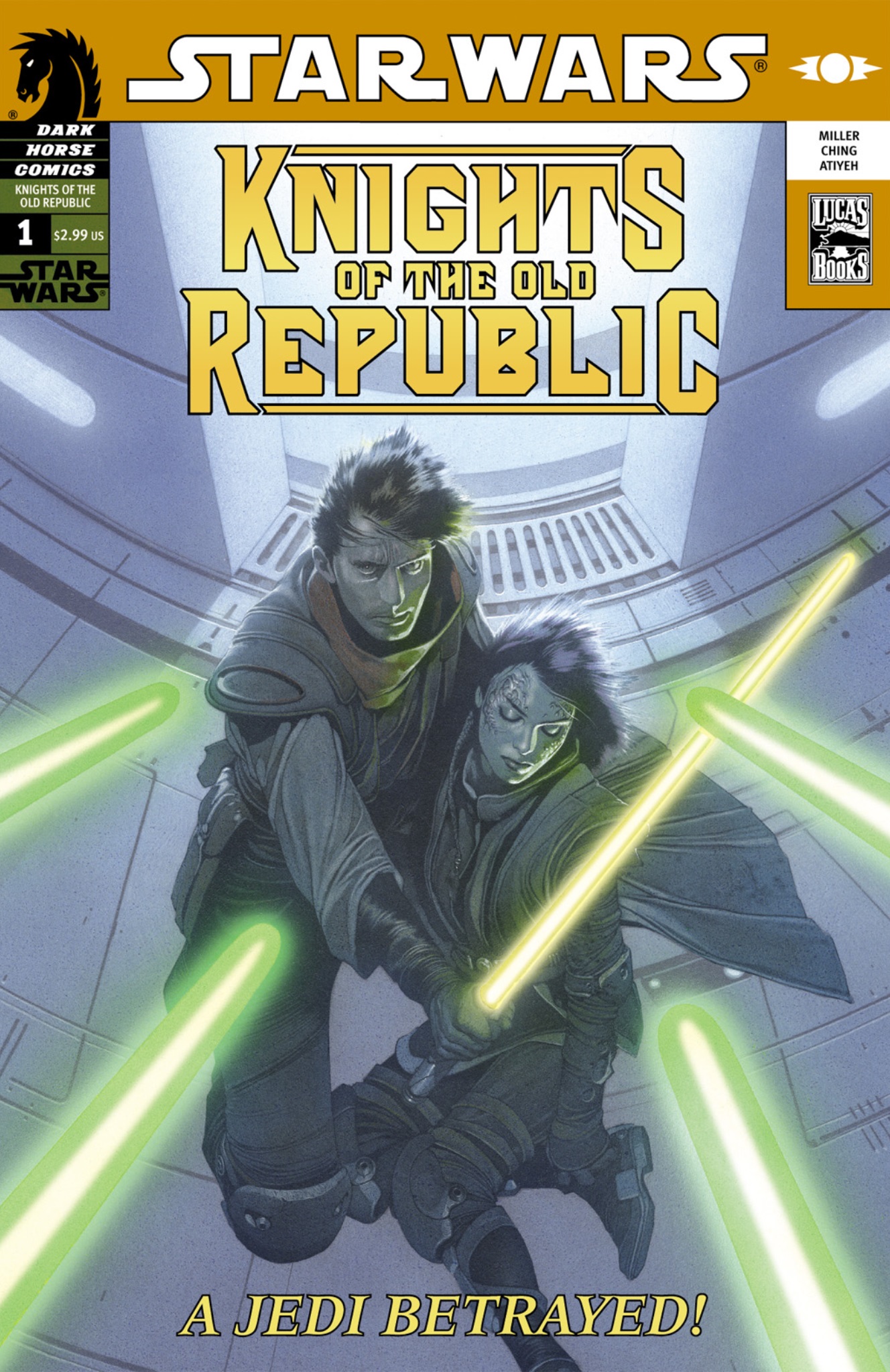
In the year 3964 BBY, on the city-planet of Taris, Jedi Padawan Zayne Carrick makes his eighth attempt to apprehend the Snivvian criminal Marn Hierogryph. However, Carrick's characteristic lack of coordination results in Hierogryph's escape, sending the Padawan plummeting from a building. He is saved by "Squint", a Jedi Knight dispatched by Carrick's Jedi Master Lucien Draay to locate him. Carrick learns that Squint is among several Jedi visiting Taris's Jedi Tower to gather allies for the Mandalorian Wars between the Galactic Republic and the Mandalorian warrior culture. Squint returns Carrick to the Jedi Tower, explaining that sometimes one must embrace darkness to preserve the light. As Squint's group departs, Master Q'Anilia senses a disturbance in the Force, prompting Lucien Draay and the other Masters at the Jedi Tower to investigate. Several days later, Carrick attempts to capture Hierogryph again, only to crash-land in the middle of a banquet celebrating the upcoming Knighting ceremony performed by the Jedi Masters. While the Jedi Masters—Lucien Draay, Feln, Q'Anilia, Raana Tey, and Xamar—withdraw to their chambers, Carrick is assigned to clean up the mess he created. However, he spots Hierogryph and gives chase, ultimately capturing the con man. Upon returning to the Jedi Tower, Carrick realizes he is late for the ceremony and rushes in, only to discover his fellow Padawans Oojoh, Shad Jelavan, Kamlin, and Gharn dead at their Masters' feet.
Overcome with horror, Carrick flees the Jedi Tower with Hierogryph, escaping to the Lower City of Taris. There, they discover that the Masters have placed bounties on their heads, as Carrick is being blamed for the "Padawan Massacre". With Hierogryph's reluctant assistance, Carrick evades the Masters, deceiving them into searching Taris's Undercity while the pair approaches a refugee camp in Machineville. There, Hierogryph seeks out the aging Arkanian Offshoot engineer Camper and his fierce protector Jarael in an attempt to acquire a means of leaving the planet. However, when the Jedi and Taris's police arrive, the group is compelled to launch into space aboard the dilapidated junk hauler The Last Resort—which immediately loses power once in orbit.
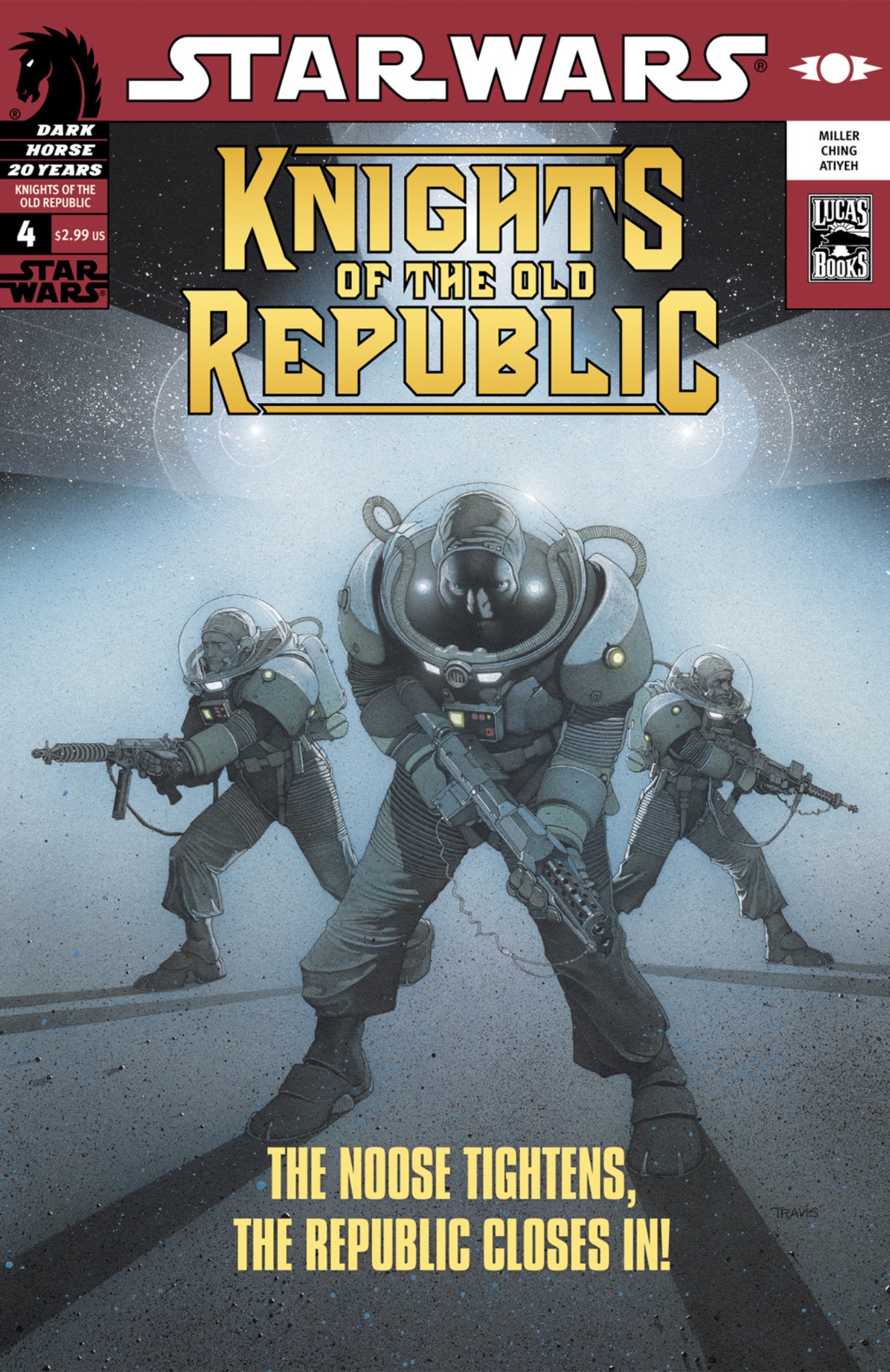
When power is restored, The Last Resort conceals itself within the asteroid belt of the Taris system, and Carrick attempts to contact Master Vandar Tokare and the Jedi Council at the Jedi Enclave on Dantooine to seek assistance. However, he learns that Tokare does not believe his account. Realizing the unusual nature of four Jedi Consulars being assigned to a single planet like Taris, Carrick recalls their recent training mission to Taris's rogue moon, and he decides to investigate the moon to uncover the reason behind the Masters' murder of the Padawans. He and Jarael—who still harbors resentment towards Carrick for disrupting and exposing her and Camper—discover the Jedi's damaged droid T1-LB, or Elbee, before evading Master Draay and the police on the rogue moon. Back on The Last Resort, Carrick and the others examine T1-LB's memory. The droid witnessed the Jedi Masters experiencing a Force vision that foretold their deaths at the hands of a red-armored figure. Believing the figure to be one of their Padawans, who had been wearing red space suits on the rogue moon identical to the foreseen Sith Lord, the Masters agreed to execute their apprentices to prevent the vision. Draay destroyed the droid to eliminate a witness, a betrayal that severely damaged T1-LB's programming and logic processors. The crew's discussion is interrupted by the ship of the bounty hunter and pirate Valius Ying, who captures them and intends to return Carrick to Draay. Hierogryph negotiates his own release, as well as that of Camper and Jarael. However, when Carrick attempts to steal The Last Resort and escape, he is caught by Jarael. Realizing that he cannot abandon the others to save himself, Carrick decides to surrender to the Masters.
Ying's arrival on Taris with Carrick is met with celebratory crowds, as the public's declining faith in the Jedi had led to riots and widespread panic in the face of the advancing Mandalorian threat from the Outer Rim Territories. Upon Carrick's delivery to the Jedi Tower, Draay and the Masters reveal that they did indeed kill the Padawans after the apprentices became suspicious, as they had refused to believe that Carrick would be Knighted alongside them. Draay explains that the five of them are members of a Jedi Covenant dedicated to preventing the return of the Sith, and he executes Ying to eliminate the only witness before preparing to kill Carrick. However, Jarael, Camper, and Hierogryph have other plans: unwilling to let Carrick sacrifice himself to save them, the trio attacks the Jedi Tower with The Last Resort. Jarael rescues Carrick in a red space suit, exploiting the Masters' fear of the figure to buy them time to escape. Carrick assumes the role of Hierogryph's "henchman" as the four of them escape Taris with Elbee in The Last Resort. Three weeks later, rioting has engulfed much of Taris, and the Masters are recalled to the Republic capital of Coruscant, as the public has lost confidence in the Jedi's ability to protect and govern them. Before their departure from Taris, however, the five receive a message from Carrick in which he vows to seek justice for the other Padawans, stating that he has "foreseen" that the first Master to confess will survive.
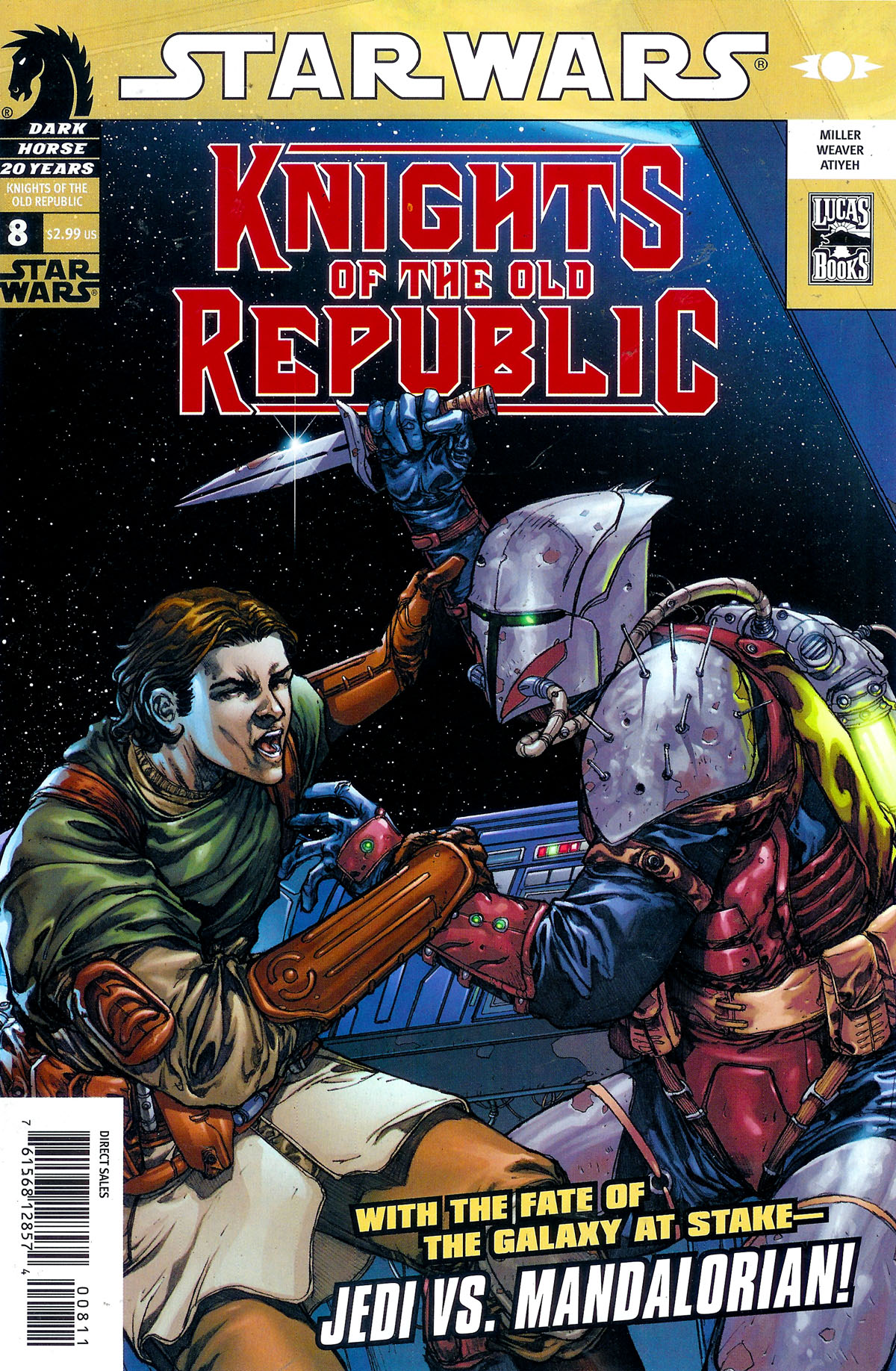
On the mining colony of Vanquo, Carrick, Hierogryph, Camper, and Jarael execute a con on one of the mining stations, persuading the workers to evacuate under the pretense of a Mandalorian attack. However, as the crew of The Last Resort is loading the mining stations' supplies, they are surprised to discover that the Mandalorians are indeed invading Vanquo. This leads to Jarael's capture, as she was posing as a Jedi for the group's scam. The remaining crew members flee through the forest back to The Last Resort, but the Mandalorian commander Rohlan Dyre, seizing an opportunity to escape, steals The Last Resort for himself. With Elbee's help, Camper, Hierogryph, and Carrick barely manage to board The Last Resort as it takes off amidst blaster fire from Dyre's own troops. Camper swiftly attacks Dyre with Jarael's shockstaff, and with Elbee's assistance, the group is able to subdue the Mandalorian and confine him to a storage compartment known as a Camper Special. Meanwhile, Jarael is imprisoned aboard a Mandalorian ship that enters the ongoing naval battle between the forces of Mandalore the Ultimate and the Republic Navy.
As The Last Resort pursues the ship holding Jarael, it is identified by Captain Saul Karath's Courageous, and Karath assumes that Carrick is a Mandalorian operative when The Last Resort is detected jumping towards Mandalorian space. Camper is tracking Jarael via a homing device in her bracelet. Dyre convinces Hierogryph and Carrick to release him so that he can assist them in rescuing Jarael—explaining that he is known as Rohlan the Questioner, a Mandalorian determined to uncover Mandalore's reasons for initiating the war. Dyre explains that Jarael is being taken to the stellar research station Flashpoint, which has been converted into a laboratory for the Mandalorian scientist Demagol's research into Jedi. Dyre also explains that the Mandalorians invaded Vanquo because of the Padawan Massacre, as Mandalore interpreted the Jedi's recall from Taris as an opportunity to attack. Upon learning that other Jedi are imprisoned on Flashpoint, Carrick becomes determined to rescue them, and he develops a plan as they approach Flashpoint.
Meanwhile, Jarael is taken to Flashpoint and imprisoned with the other captives, many of whom had been captured on the planet Suurja three weeks prior. Jarael encounters Squint, who realizes that Jarael is not a Jedi and offers himself in her place for Demagol's torture and experiments. Upon approaching Flashpoint, Dyre claims to have captured a Jedi and demands immediate clearance to land as Hierogryph and Camper hide in The Last Resort's concealed storage compartment. Dyre arrives just in time with a "captive" Carrick to rescue Jarael from Demagol's attentions. In Demagol's lab, Dyre and Carrick overpower Demagol, and Carrick dons the scientist's armor. The two head to the surface, where Dyre distracts the sentries as Carrick uses the Force to plant Hierogryph's demolition charges on the nearby Mandalorian vessels. Hierogryph then contacts Flashpoint as "Admiral Hierogryph" of the Republic vessel "Glomkettle" and triggers the charges, deceiving the sentries into believing that the Republic had begun booby-trapping their equipment and ships to prevent the Mandalorians from using them.
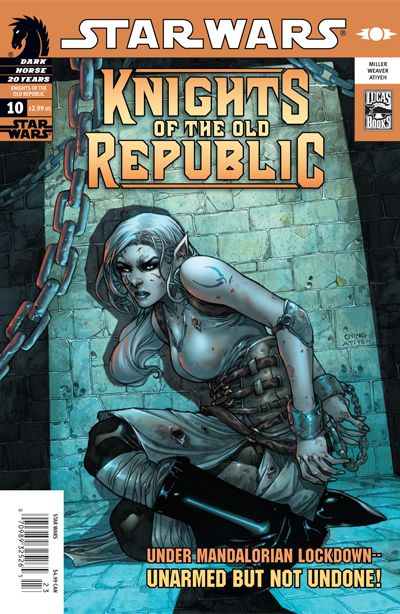
Dyre and Carrick complete the con by convincing the other Mandalorians at Flashpoint to flee on one of the last remaining ships while Dyre stays behind to evacuate Demagol. With the Mandalorians gone, the Jedi are able to escape Flashpoint, taking Demagol with them and seemingly accompanied by Rohlan Dyre. However, Dyre actually sneaks aboard The Last Resort. On the same day that Carrick and crew are on Flashpoint, Draay and the other members of the Covenant return to Coruscant, where Draay is denied entry to his family's house, the Draay Estate, and the five are separated by the Jedi High Council. Amid these events, Draay reflects on his childhood and how his mother Krynda focused more on training the four seers than raising her own son, as she was obsessed with preventing the rise of another Sith like Exar Kun. The five Masters go their separate ways as ordered, but continue their efforts to locate Carrick despite the Council's refusal to allow them to be involved in the search for the missing Padawan. Draay tries again to visit his mother, the Covenant's leader, but his mother's retainer Haazen refuses him and reprimands Draay for killing the Padawans against Haazen's instructions.
Following the mission to Flashpoint, the crew of The Last Resort travels to the banking planet of Telerath, where Hierogryph has an account that is frozen due to his involvement in the Padawan Massacre. To access the money, Camper and Jarael go undercover as "Baron Hyro Margryph" and his assistant "Chantique" and visit a banker named Arvan while Carrick and Hierogryph remain aboard The Last Resort. The two claim that the account actually belongs to Baron Margryph, who had been confused with Marn Hierogryph. Despite leaving the account's access code aboard The Last Resort, Camper is able to recite the access code perfectly, surprising the rest of the crew. As Arvan leads Jarael and Camper to the banquet pavilions, they are watched by the Moomo Brothers—a pair of bounty hunters named Dob and Del who have been hired to keep watch on Arvan. The Moomo Brothers decide to kidnap the banker and then watch him, and Hierogryph and Carrick rush to rescue their banker—only for Zayne to recognize the banker as his father, Arvan Carrick, just before the brothers escape.

Raana Tey is furious to learn that the brothers kidnapped Arvan, and she orders them to stand by while she consults with the rest of the Covenant. Dob and Del soon end up fighting, and the victorious Dob goes out for a drink as Zayne's friends realize that the Covenant hired the brothers to watch Arvan as a trap for Zayne. Hierogryph soon locates Dob at a nearby bar, and, plying him with quite a few drinks, convinces the Ithorian to trade Arvan for the far more valuable Zayne. Falling for Hierogryph's play, Dob gives the Snivvian the location of the brothers' ship, the Moomo Williwaw and Carrick tails the drunken bounty hunter back to the Williwaw where he overhears Raana Tey tell Del that she will arrive soon to kill Arvan. Freeing his father, Zayne learns that Arvan's bank had been purchased by the Draay Trust, and his father reassures Zayne that his family did not believe Zayne committed the Massacre. Using Hierogryph's arrival as a distraction, Zayne hits one of the brothers with a Force-propelled crate, sparking a fight between the two and allowing the Carricks to escape. Arvan accesses Hierogryph's account for the crew before Zayne sends him and the rest of his family to Dantooine, where Master Tokare takes Arvan on as the Enclave's banker.
Shortly after The Last Resort departs Telerath, the Duros Eejee Vamm—who is employed scanning holofootage from across the galaxy—notices a recording of "Baron Hyrogryph" at Telerath and contacts Lord Adasca with news of his findings. On the planet Ralltiir, Camper, Jarael, and Elbee part ways with Hierogryph and Carrick, though not before Camper gives Zayne a set of phrik-alloy vambraces that block lightsaber strikes—something that Jarael demonstrates in a sparring match between the two. Jarael wishes Carrick good luck before she departs with Camper to find a new place to hide, though Carrick is saddened that they are leaving. Hierogryph hires a Trandoshan ship thief named Slyssk to secure them a new ship, though Carrick is amused when the timid Slyssk attempts to force Hierogryph to pay more than their agreed price. Carrick and Hierogryph con Slyssk into swearing a life debt to Hierogryph, though Slyssk takes it more seriously than Hierogryph expects, and the three are forced to flee in the stolen ship—the Little Bivoli—when the ship's real crew arrives. However, Hierogryph and Carrick quickly realize that the Little Bivoli is a military mess ship, and the ship is forced to join Admiral Karath's fleet as it departs Ralltiir.
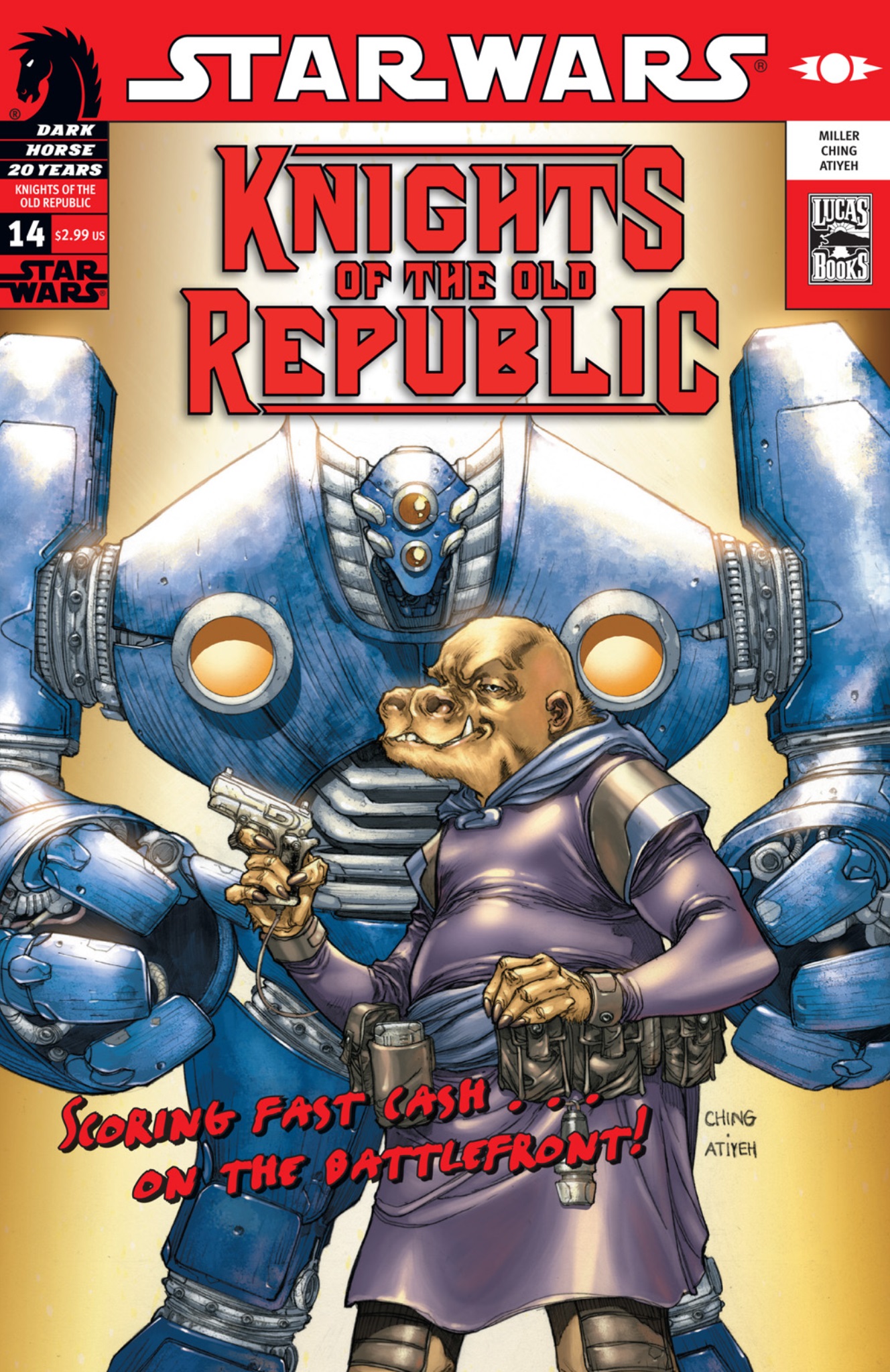
Aboard The Last Resort, a HK-24 series assassin droid that had managed to sneak on board subdues Camper. When Jarael hears strange sounds coming from the hold and goes to investigate, the assassin droid launches an attack. Rohlan Dyre intervenes, saving Jarael after a brief struggle. He then reveals that he had been seeking a discreet opportunity to leave The Last Resort for a while. Simultaneously, on the surface of Serroco, the Little Bivoli establishes its presence, with Slyssk working as a cook under Hierogryph's employment, providing food services to the Republic fleet stationed above the planet. Carrick encounters a pilot named Carth Onasi. As they discuss the ongoing war, Carrick notices a native Stereb scavenging through a dumpster. He decides to pay for the Stereb's meal at the Little Bivoli. Onasi then recalls how he used to make false emergency calls to the Stereb population. Later that night, Carrick, frustrated with Hierogryph, steps outside for some fresh air. Suddenly, he experiences a vivid vision of an orbital bombardment devastating Serroco's surface. Realizing that the Mandalorians plan to bomb Serroco upon their arrival the following day, Carrick resolves to warn Admiral Karath.
Despite Carrick's warning, Hierogryph chooses to keep the Little Bivoli open for a bit longer the next morning. Meanwhile, Carrick secretly boards Onasi's ship, the Deadweight, and identifies himself as a Jedi, recounting his vision of the impending Mandalorian assault. However, upon arriving on the bridge of the Courageous, Karath recognizes Carrick as the alleged Jedi-killer and accuses him of being a Mandalorian spy. Karath dismisses Carrick's claims of assisting "Squint" at Flashpoint, but allows Onasi to attempt to contact "Squint" while Carrick remains on the bridge. Moments later, Mandalorian ships enter the system. Hierogryph becomes aware of their arrival, but a surge of last-minute customers at the Little Bivoli delays their departure. As Carrick predicted, the Mandalorians launch numerous nuclear warheads toward the Republic fleet. However, just before impact, the missiles divert and slam into the planet's surface. As Onasi returns to the bridge, Carrick cries out, sensing the deaths of thousands. This sensation resonates with Jedi across the galaxy, including Squint, the Jedi known as the Revanchist, Q'Anilia, and Lucien Draay. Only eight ships manage to escape the bombardment, and the Little Bivoli is not among them. A disheartened Carrick is imprisoned in the Courageous's brig by an enraged Karath. However, Onasi visits Carrick later that night, informing him that he successfully sent emergency alerts to seventeen of the twenty-seven Stereb cities targeted by the bombardment, prompting the Stereb to seek refuge in underground bunkers.

Raana Tey, en route to Taris on a mission for the Supreme Chancellor, is plagued by nightmares, particularly one where she relives the Padawan Massacre from Zayne Carrick's point of view, but with the Padawans as the aggressors. Believing that killing Carrick will end her nightmarish visions, Tey sets out to find him. Aboard The Last Resort, Jarael and Dyre are struggling to care for Camper, whose long-standing illness is worsening. Jarael decides to travel to the planet Arkania in search of medical assistance. Upon arriving in Adascopolis, Jarael attempts to visit a medical center, but the guards, recognizing her as an Arkanian Offshoot, force her onto a shuttle heading to the mining camps. On the shuttle, Jarael meets another Offshoot named Zadawi, who brings Jarael to her home. From Zadawi and her grandmother, Jarael learns about the discrimination faced by the Offshoots at the hands of the "pure" Arkanians. Zadawi helps Jarael disguise herself as a pure Arkanian so she can enter the city unnoticed. However, Jarael's visit to the medical center attracts the attention of Arkanian guards. Lord Arkoh Adasca arrives, stopping the fight and offering to help cure Camper. The Last Resort is brought aboard Adasca's flagship, the Arkanian Legacy, which serves as the mobile headquarters of Adascorp. Upon learning that Jarael is working with Adasca, Camper collapses during one of his spells.
The medical staff of the Arkanian Legacy quickly place Camper in quarantine. Jarael prevents Adasca's guards from attacking Dyre when they realize he is a Mandalorian. Lord Adasca then gives Jarael a tour of the Legacy, explaining that Camper, whose real name is Gorman Vandrayk, used to work for Adascorp years ago before being exposed to Balinquar's Virus, a pathogen that affects elderly Offshoots. Adasca grants Jarael free access to the Legacy while Camper undergoes treatment. Meanwhile, at Serroco, the Republic's defensive line is collapsing. As the Courageous is boarded, Admiral Karath, Onasi, and Captain Dallan Morvis are forced to retreat toward the brig. Reluctantly, Karath seeks help from Carrick, who reveals that he removed the screws from the bulkhead in his cell, exposing a passage to the hangar and Onasi's Deadweight, after Karath promises to take the Jedi with him.

Unbeknownst to Jarael, Adasca has imprisoned Dyre. Adasca makes a deal with the Mandalorian: in exchange for his assistance, Dyre is granted access to the ship's foredeck and research facilities. Furthermore, Eejee Vamm contacts Jarael, informing her that Camper will be in recovery for the next few days. He uses this conversation to show a perfectly healthy Camper that Jarael is safe, for the time being. Vamm reveals that Camper's illness was caused by pollutants and spores in The Last Resort's vents. To ensure Jarael's safety, Camper is forced to resume the research he abandoned years earlier. Lucien Draay arrives on Telerath to retrieve Carrick from Karath, but the news of the Courageous's fall triggers widespread panic, ending Draay's hopes of acquiring Carrick. He then contacts Haazen, who informs Draay that WatchCircle Vodo has foreseen a faceless evil rising in the future. To investigate its source, Haazen sends Draay to meet with Arkoh Adasca, who has been contacting leaders of various groups, including the Jedi Revanchists and the Republic Navy.
Aboard the Arkanian Legacy, Adasca continues his efforts to ingratiate himself with Jarael, inviting her to dinner. He is pleased to learn that Camper's research has been successful. Adasca later approaches Dyre, who is deeply engrossed in research, and proposes a new deal: in exchange for contacting Mandalore the Ultimate and requesting his presence at a meeting with Adasca, Dyre will be allowed to leave with Jarael once Adasca's business is concluded. The Deadweight also receives an invitation from Adasca, requesting Admiral Karath to rendezvous with the Arkanian Legacy. During dinner, Adasca surprises Jarael by discussing her unique genome. He then reveals what Camper has been working on—the weaponization of space slugs known as exogorths—before revealing the dozens of hibernating exogorths they have located in the remote Omonoth system.
The Deadweight responds to Adasca's message and meets the Arkanian Legacy in the Omonoth system. Adasca decides to keep Jarael as his companion for the time being. When she overpowers his HK-24 droids and aims a blaster rifle at him, Adasca forces her submission by threatening Camper's life. Jarael is overjoyed to see Carrick among Admiral Karath's party. She kisses him passionately to get close and explain the situation in a whisper. At Karath's request, Adasca imprisons Carrick, adding a threat against Carrick's life to Jarael's motivations. He then greets Squint, who has responded to Adasca's summons for the Revanchist leader. Squint, or rather Alek, informs "Dyre" and Jarael that "Demagol" fell into a sedative-induced coma almost immediately after the Jedi left Flashpoint. Adasca is called away by Eejee Vamm to meet another visitor—one whom Adasca is surprised to recognize as Lucien Draay. Draay and Adasca exchange pleasantries and wine, but Draay collapses after drinking drugged wine, as Adasca did not want Draay involved in his upcoming meeting.
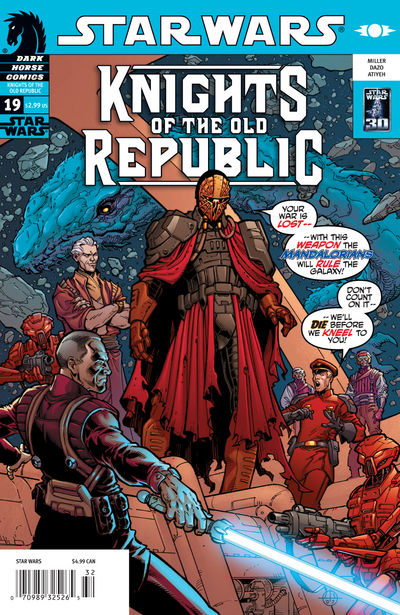
In the Arkanian Legacy's observation dome, Adasca explains the exogorths and their operation to Karath's party and Squint. Karath is angered to learn that the Republic must purchase the exogorths. Both Karath and Squint are shocked when Adasca's third guest arrives: Mandalore the Ultimate. Adasca then reveals his intention to use the exogorths as a bargaining chip to secure the allegiance of either the Mandalorians, the Republic, or the Jedi. Elsewhere on the ship, Draay awakens to find himself tied to Carrick and guarded by HK-24 droids. Squint attacks Mandalore when he enters the observation dome, and Karath aims a blaster at Mandalore when Squint is brushed aside. Adasca ends the hostilities and orders a demonstration of the exogorths' potential. Camper manages to sneak away to the spacesuit storage chamber aboard the exogorth command platform. As they wait, Mandalore requests a moment with Dyre. Mandalore explains that he has turned the Questioner into a martyr, and Dyre's "sacrifice" has been used by Mandalore and his lieutenant Cassus Fett to spread the Neo-Crusader philosophy and armor throughout the Mandalorian ranks. In exchange for safe departure with a new set of armor, Mandalore makes Dyre promise to remain "dead" for the cause.
Camper manages to contact Jarael through her bracelet. She slips away as Dyre approaches Adasca and demands to leave with Jarael. She apologizes frantically to Camper, explaining that Carrick and Squint are on the Legacy. Camper refuses to risk Jarael's life by sabotaging the exogorths, revealing that Adascorp was responsible for the diseases afflicting the Offshoot population. Adasca overhears this, attacking Jarael. Squint aims his lightsaber at Adasca's throat, preventing him from killing her, but Adasca threatens Camper through Jarael's bracelet, ordering him to continue his work. Meanwhile, Draay and Carrick argue about the Covenant's desire to kill him. However, they ally to escape and overcome their captors. Draay immediately turns on Carrick once they are free, but Carrick's vambraces save his life and deactivate Draay's lightsaber. They resume their uneasy alliance to deal with Adasca. Onasi slips away as the exogorths become active. Adasca begins discussing terms with the interested parties. Karath offers a seat in the Galactic Senate, but Mandalore counters with immunity from Mandalorian attack and the promise to make Adascorp his armies' sole supplier of weapons. At the same time, Eejee Vamm and Adasca's scientists discover something about Jarael's blood, but Dyre brutally kills them to "protect the truth."

However, Adasca quickly becomes power-hungry, demanding the allegiance of both the Jedi Order and the Mandalorians, believing his control over the exogorths makes him a galactic power. Onasi locates Draay and Carrick, and they discuss how to eliminate the exogorth threat. When Draay suggests killing Jarael to remove Adasca's leverage, Dyre arrives and threatens Draay for suggesting it. The four devise a plan to turn Adasca's "guests" against each other. Carrick dons Dyre's Neo-Crusader armor to stage a fight between himself and Onasi in the observation dome. As chaos erupts, Carrick frees Jarael before joining the newly arrived Draay in addressing Lord Adasca, claiming that Adasca arranged the meeting as a Jedi trap for Mandalore. A full-scale battle ensues. Carrick contacts Camper, informing him that Jarael is safe. Camper remote starts The Last Resort and has it fly to his location as he hotwires the exogorth control system into a portable platform. Camper takes control of the HK-24 guarding him and causes it to break through the station's bulkhead, allowing him to spacewalk to The Last Resort. Using the exogorth control box, Camper instructs the exogorths to attack Adasca's fighters and the Arkanian Legacy's observation dome, killing Adasca as the Arkanian's guests escape the doomed ship.
Amid the chaos, Onasi lets Carrick "escape." However, when Jarael and Dyre reach the hangar, they find only Elbee, despondent that The Last Resort has left him. As he leads the exogorths away in The Last Resort, Camper contacts Jarael, explaining that he intends to lead the bioweapons into the unknown and remove their hyperdrives. Carrick reaches the hangar just in time to see The Last Resort jump to hyperspace and Jarael burst into tears. Draay offers to rescue Squint, Carrick, and Carrick's friends in exchange for Carrick's surrender. Just as he agrees, the Moomo Williwaw crashes into the hangar, carrying Dob Moomo and Slyssk. Slyssk reveals that Hierogryph is alive on Taris and needs Carrick's help. As Carrick's group escapes aboard the ship, Draay overhears their destination and escapes the doomed Legacy as well.
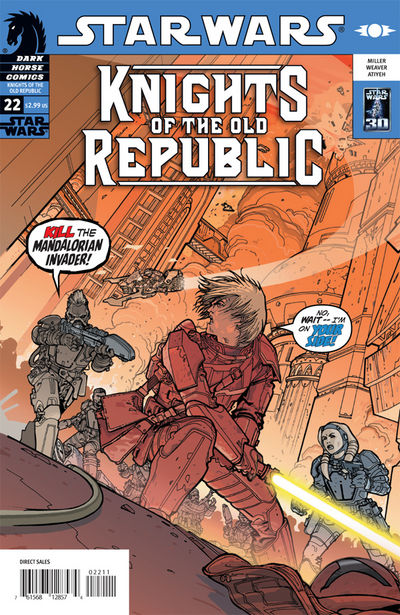
The group travels to Taris, which is under Mandalorian occupation. Dyre pilots the Williwaw toward the surface so that Carrick, wearing Dyre's discarded Neo-Crusader armor, can free-fall into the Lower City. Carrick locates Hierogryph and Del Moomo with the Hidden Beks swoop gang. Hierogryph reports Carrick's arrival to his client on Coruscant before Gadon Thek is forced to pull the Hidden Beks back to their base known as the Pit. Thek explains to Carrick that he intends to join the Taris Resistance and take Carrick to the constable to join them. Speaking with Gryph, Carrick learns that the Snivvian is on a "Republic-ish" mission for Jervo Thalien, the head of Lhosan Industries, to locate Taris's Senator Goravvus. The Twi'lek girl Mission Vao takes Carrick to show him a secret that her brother Griff is hiding, though the Hidden Bek Brejik attacks Carrick when he thinks that Carrick is escaping. Mission then shows Griff's "secret" to Hierogryph and Carrick: the constable's missing children, who Brejik and Griff had kidnapped and hidden weeks ago. Meanwhile, Raana Tey is on Taris, sensing Carrick's arrival. She has joined forces with Shel Jelavan, Shad's sister and Carrick's romantic interest before the Massacre.
Gadon Thek uses the discovery of the constable's children to secure a meeting with the resistance. However, upon arriving at the resistance's base, Shel Jelavan shoots at Carrick in revenge for killing her brother. Hierogryph's heavy briefcase that Carrick is carrying absorbs Jelavan's shot. Raana Tey encourages her to finish off the stunned Carrick and avenge her brother. Recognizing Del Moomo, Tey attacks the Ithorian in a fury, giving Hierogryph time to disarm Jelavan. A standoff between Tey and the Hidden Beks develops, ending with the arrival of Constable Noana Sowrs and Senator Haydel Goravvus. Goravvus forces Tey to stand down and allows the Hidden Beks to join the resistance. Hierogryph informs the Senator that Thalien is looking for him. Hierogryph opens his case to display a holocommunicator to Thalien, but Del Moomo surprises everyone by seizing the Senator as a hostage. Thalien's actual intention is to eliminate Goravvus, who knew that Lhosan Industries had helped bribe Taris into the Republic. Fortunately for the Senator, Raana Tey frees him from Moomo. Thalien's attempt to detonate a bomb in Hierogryph's case is ineffective, as Shel Jelavan's blaster shot overloaded the circuits.
The Moomo Williwaw remains in orbit among the massed Mandalorian ships. Dyre convinces Jarael to spar with Alek to take her mind off Camper and hone her skills. To Jarael's surprise, Alek attempts to start a relationship with her, though Jarael refuses for the time being. Carrick finally corners Shel and tries to explain that he didn't kill Shad, but her revelation that she set a bounty on Carrick's head and the arrival of Raana Tey seemingly end any hope of reconciliation. The resistance plans to infiltrate Cassus Fett's command post in the Jedi Tower and destroy it with explosives. Carrick volunteers to accompany Raana Tey on the mission to destroy the Tower, a mission that Jelavan also volunteers for. After the meeting, Tey urges Jelavan to retrieve her brother's lightsaber when they are in the Tower and use it to kill Carrick. As the mission begins, Tey recalls a time in her childhood when she overheard Krynda Draay make a prophecy about five people: one for the darkness, one for the light, one from the darkness who stands in the light, one from the light who stands in darkness, and a fifth who stands apart from the others.
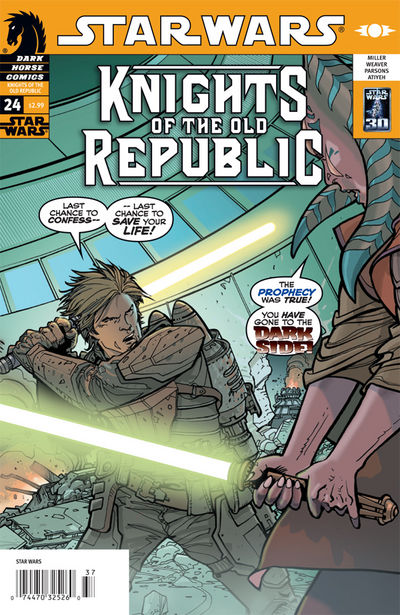
Donning his Neo-Crusader armor, Carrick escorts Jelavan as his prisoner to the Jedi Tower, though the two argue most of the way. Jelavan kisses Carrick to maintain their cover when they are overheard by other Mandalorians, though she promptly knees him between the legs when they leave. Once in the Tower, Jelavan acquires her brother's lightsaber. Carrick's clear sadness over Shad's death and his insistence that he is innocent leaves Shel confused as to whether she should try and kill him. Tey is furious to find Carrick still alive when Jelavan lets her into the Tower. She pursues Carrick as he heads to the upper levels to complete the mission, only to discover that Cassus Fett has abandoned the building and headed into the Lower City. Raana Tey attacks Carrick, realizing that her vision of Mandalorians and Sith on Taris is coming true. In her madness, she refuses to listen to Carrick's warnings that Fett is going to attack the resistance. The Hidden Beks retreat to the Pit once they learn that the resistance has been attacked, and Hierogryph keeps hold of the detonator to the Tower explosives as they flee. Meanwhile, Carrick and Tey duel in the Tower, and she brings down the glass ceiling on Carrick when he tries to escape via jetpack.
The crazed Togruta Jedi Master explains about the Prophecy of the Five to Carrick before she prepares to execute him. However, Jelavan saves Carrick, stabbing Tey with her brother's lightsaber after she hears the Jedi Master admit to the Massacre. Jelavan and Carrick escape the Tower thanks to Hierogryph and Gadon Thek's arrival on a swoop bike. Raana Tey, still alive despite her fatal wound, leaps after Carrick in a desperate attempt to stop him. When she lands on the roof, Carrick is unable to leave her to die and offers her rescue. His offer brings her to her senses, and she accepts. However, Tey's hand is stuck in the glass window. When she raises her lightsaber to cut it off, Hierogryph thinks she is attacking Carrick and detonates the explosives. As the Jedi Tower begins to collapse, Tey asks Carrick to tell Krynda that she is sorry. As Q'Anilia and Lucien, who have begun a romantic relationship, sense Tey's death, Carrick realizes that he now has a name for the Covenant's leader.
Shortly afterwards, while having a memorial service for Raana Tey on Coruscant, Xamar, Q'Anilia, and Feln experience a horrifying vision: an apocalyptic future overrun by rakghouls led by an ancient Sith, and four individuals: Carrick, a dark-armored figure, and two sandy-haired Humans. Around the Sith's neck, the three Jedi recognize the Muur Talisman—an ancient Sith artifact that was believed to have been lost on Taris. Lucien Draay decides to send Celeste Morne, one of the Covenant's Shadow agents, to Taris to locate the artifact. On Taris, Morne rescues Constable Sowrs from a rakghoul attack, but she is forced to execute the constable when Sowrs is infected. Morne encounters Hierogryph and Carrick fleeing from rakghouls. The pair follow Morne on her mission despite her dislike of them, but the floor collapses underneath them due to explosions from Mandalorian excavations nearby. The three find themselves right next to the Mandalorian excavation, where Morne witnesses a Mandalorian named Pulsipher—Demagol's former assistant—discover the Muur Talisman. Morne pursues Pulsipher, with Carrick and Hierogryph tagging along. The three sneak aboard Pulsipher's ship before it departs for the ice planet of Jebble.
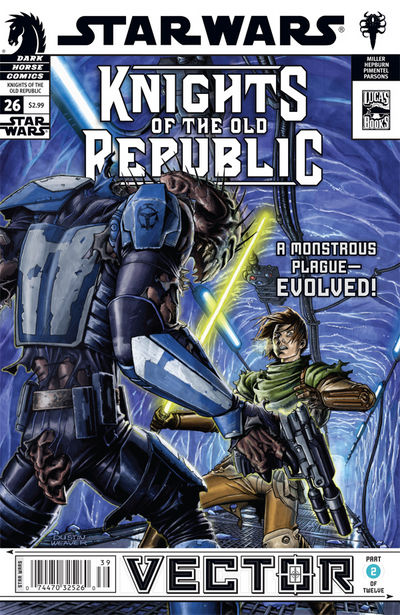
As they neared Jebble, the Talisman unleashed an electrical shock on Pulsipher and inflicted a "bite" on one of the other Mandalorians. Upon Carrick and Hierogryph's departure from Pulsipher's vessel, they found themselves compelled to join a sizable contingent of coerced Mandalorian recruits, assembled for an assault on the Core World of Alderaan. Carrick managed to break free and encountered Morne, who was actively searching for the talisman, seeking her assistance in alerting the Republic. Hierogryph, conversely, was fixated on accessing the Jedi financial records that he had overheard Pulsipher discussing. He cleverly employed his newly acquired Mandalorian armor as a disguise to facilitate their entry into the Mandalorians' Ice Citadel, yet Hierogryph's lack of proficiency with weaponry led to his blaster rifle triggering a partial collapse of the fortress upon himself. Separated from Hierogryph and under siege by a group of Mandalorians, Carrick and Morne found themselves in a precarious situation. However, the Mandalorian who had been "bitten" by the Talisman underwent a sudden transformation into a rakghoul, initiating the infection of others. The rakghoul plague rapidly propagated, leading the two Jedi to the realization that the plague—which was evolving the rakghouls beyond the normal version for some reason—would engulf the entire Mandalorian army stationed on Jebble. Carrick and Morne made their escape from the Citadel, and Carrick divulged the truth of the Massacre to the Jedi, unaware that Morne was, in fact, an agent of the Covenant. They promptly located a relay station to transmit a warning to the galaxy, while simultaneously, Hierogryph discovered the Jedi records, only to find that they contained information about the Muur Talisman and Covenant operatives like Morne.
Without Carrick's knowledge, Morne established contact with Lucien Draay, informing him of the unfolding events. She questioned Draay's directive to eliminate Carrick, finding herself unable to carry it out when his back was turned. Subsequently, Carrick utilized the station to reach out to Cassus Fett, attempting to warn him about the rakghoul plague. To Morne's astonishment, Carrick then ventured back to the citadel in search of Hierogryph, only to be captured by rakghouls and brought before Pulsipher. The deranged Mandalorian subjected Carrick to interrogation regarding the Talisman's functionality, threatening him with imprisonment within an oubliette constructed by the ancient Sith Lord Remulus Dreypa. However, the Talisman, sensing Carrick's Force-sensitive nature, sought to claim him as its new host. When Pulsipher intervened, the rakghouls turned on him, leading to his demise. Morne arrived just as the Talisman was attempting to bond with Carrick. Hierogryph appeared as Morne struggled to wrest the Talisman away from Carrick, who was tempted by the artifact's power, and Morne offered herself to the Talisman to save Carrick. As the Talisman took her as its host, Morne encountered the spirit of its owner Karness Muur, and the rakghouls surrounding them bowed to their new master.
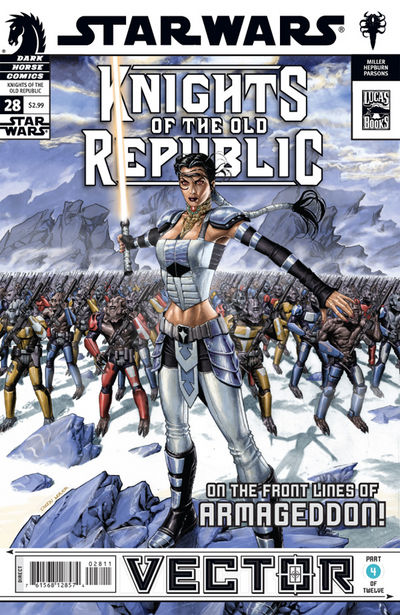
Engaged in a struggle with Muur for self-control, Morne began experimenting with her newfound command over the rakghouls. She elucidated to Carrick that the Talisman instigated the rakghoul plague to reshape the minds of its victims while preserving their acquired skills, thus creating ideal soldiers. However, when Hierogryph informed Carrick of Morne's association with the Covenant, Carrick discovered that Krynda was Lucien Draay's mother. The two engaged in a heated debate regarding the Covenant's objectives and methods, culminating in Morne launching a furious attack on Carrick and preparing to execute him. Before she could carry out the act, Carrick compelled her to confront the reality of what the Talisman had wrought: an ever-expanding army serving the Sith. Horrified, Morne implored Carrick to end her life, but he proposed an alternative: Dreypa's Oubliette could provide secure containment. Expressing her gratitude, Morne entrusted Carrick with her key to the Sanctum of the Exalted, the Covenant's repository of Sith artifacts located on the planet Odryn. With Morne's influence diminished, the rakghouls turned their attention to Hierogryph and Carrick, but the pair were rescued by the arrival of the Moomo Williwaw. As they departed Jebble, the group witnessed Cassus Fett bombard Jebble's surface with nuclear warheads in an attempt to eradicate the rakghoul plague. Bolstered by the support of his companions, Carrick resolved to journey to Odryn and utilize the Covenant's storehouse to expose their machinations.
On Coruscant, Lucien Draay had ascended to a seat on the Jedi High Council, a result of Haazen's manipulations. He successfully persuaded the Council to issue an order for the recall, and potentially the detention, of the Revanchists, particularly Alek, due to his involvement in the Adasca affair. Master Vrook Lamar harbored suspicions regarding Draay's recent rise to power, especially in light of the Padawan Massacre, but Master Tokare reminded him that they had both agreed to Draay's appointment to facilitate the uncovering of the truth behind the Massacre. Haazen contacted Draay, demanding his immediate return to the Draay Estate, as Celeste Morne had reported in with success. Meanwhile, the Moomo Williwaw arrived on Odryn, and Jarael—disguised as Morne—was escorted to the Sanctum of the Exalted by the Feeorin Borjak, who Jarael compelled to allow the Moomo Brothers to carry a large case, ostensibly containing an artifact, into the Sanctum. Odryn was plagued by storms and peculiar natural phenomena, all of which had commenced since Feln, as the Exalted, or leader of his tribe, permitted the Covenant to store artifacts within the Sanctum. Once inside, the Moomo Brothers released Carrick and Hierogryph from the case they were carrying, and Carrick utilized Morne's key to gain access to the Sanctum, which housed hundreds of dormant Sith artifacts.
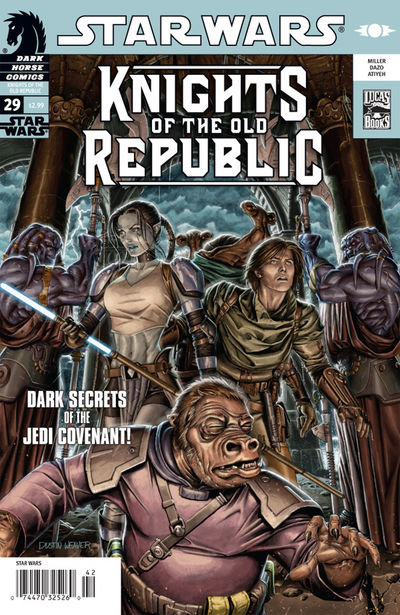
After cautioning the Moomo Brothers against tampering with any of the artifacts, Carrick and Hierogryph embarked on the task of photographing the artifacts as evidence to be used against the Covenant. They also discovered that the Covenant's researchers were conducting tests on artifacts such as the Helm of Dathka Graush. The pair stealthily exited the Sanctum, only to be apprehended by Borjak and the rest of the tribe. Borjak questioned Carrick's motives for attempting to sneak out of the Sanctum, explaining that Feln had violated the tribe's traditions, such as the Rime Feeorin, ever since becoming a Jedi. However, Carrick's efforts to persuade Borjak to cease following Feln were thwarted by the arrival of the Feeorin Jedi Master himself. Feln contacted Draay, informing him of Carrick's presence on Odryn, leading them to believe that Carrick had killed Morne and stolen her key. Draay ordered Feln to destroy the Sanctum to prevent Carrick from gaining access to the Sith artifacts, but Haazen countermanded the order. Feln resolved to eliminate Carrick personally, but Borjak reminded him that, according to Feeorin tradition, Carrick, having been inside the Sanctum of the Exalted, could not be harmed by weapons. Carrick quickly attacks Feln and caught him by surprise before he fled into the Feeorin village. However, Feln caught up to Carrick and pinned him down, and when Borjak told Feln that the Moomo Williwaw had returned to the star system, Feln detonated the explosives beneath the Sanctum to ensure that Carrick's group could not raid it.
To Feln's dismay, the Sith artifacts amplified the explosion as they were destroyed, devastating the village. Enraged, Feln reached for his lightsaber to kill Carrick, but found only a stick—just as he foresaw in the Rogue Moon Prophecy—just before Borjak stabbed him in the back with a knife. The tribe attacked Feln for destroying the Sanctum and killed him, and Hierogryph revealed that he stole Feln's lightsaber. The rain helped put out the fires among the village, and fortunately for Carrick and his crew, the Moomo Brothers had filled their case full of Sith artifacts from the Sanctum before its destruction, giving the group the evidence they needed in place of the recordings that Feln destroyed. At the Draay Estate, Draay grew angry with Xamar for questioning him in the wake of Feln's death, and Q'Anilia sank further into despair as Draay sent Xamar to meet with the Republic fleet: Draay had told Admiral Karath that Carrick was planning on raiding Coruscant for the Mandalorians, and Karath had established a blockade around the capital to ensure Carrick did not get by. Q'Anilia urged Xamar not to go, as the Rogue Moon Prophecy foretold his death with the Republic Navy, but Xamar went anyway, though he began to consider confessing to the Council.
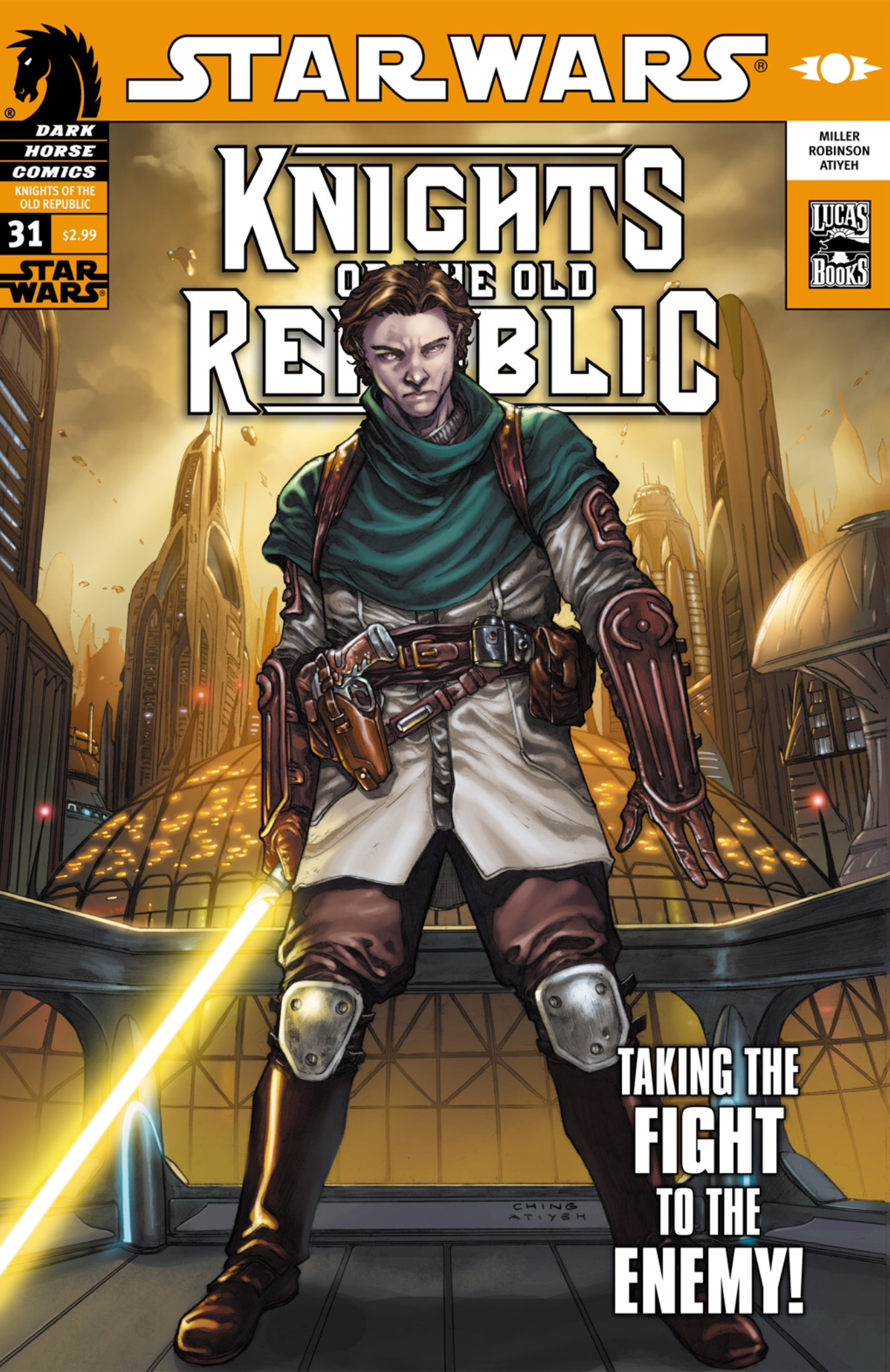
As Lucien settled into his new living space, his thoughts drifted to the absence of his father, Barrison, who had perished in the Sith War. Meanwhile, Masters Tokare and Lamar responded to a summons from a figure identifying himself as "Captain Malak," leading them to a Coruscant cantina. There, they encountered Shel Jelavan and Alek, who had assumed the alias of Malak to evade Draay's arrest warrant. Tokare had also acquired a recording detailing the events on Jebble, which Jelavan and Malak attributed to an agent of the Covenant. They informed the Jedi Masters that Carrick was willing to surrender himself and present further evidence. However, Admiral Karath had established a blockade using the Swiftsure, employing a tactic known as the Vanjervalis Chain to link together the entire blockade's targeting computers. The Moomo Williwaw prepared to fight its way through, but Lieutenant Onasi and his Lance Squadron ordered him to turn back, and the Williwaw took heavy fire from the linked weapons systems of the blockade.
Aboard the Swiftsure, Xamar cautioned Karath that Carrick relied on misdirection rather than brute force. Despite his apprehension, Xamar heeded Karath's advice and proceeded to the hangar to secure a starfighter. Recognizing the impossibility of breaching the blockade, Carrick and Jarael devised an alternative plan: they would crash the Williwaw into the Swiftsure's hangar, enabling Hierogryph, Carrick, and Slyssk to pilfer the shuttle Deadweight and descend to Coruscant's surface with their artifacts. However, Xamar had anticipated their scheme and stowed away aboard the Deadweight, subsequently capturing Hierogryph and Carrick. Tokare and Lamar informed Jelavan and Malak that Carrick's evidence was insufficient; for the Covenant to be truly exposed, one of their own had to confess. To their surprise, Xamar arrived, offering to do just that.
Xamar consented to expose the Covenant to the Council, but only after securing promises from Tokare and Lamar that Krynda Draay would receive complete immunity for her involvement in the Circle's transgressions. The Council orchestrated a raid on the Draay Estate, which was guarded by Covenant-loyal Jedi. The Order dispatched Xamar, Carrick, and Hierogryph ahead of the attack, tasking Xamar with ferrying Krynda to safety. Carrick donned Sith attire and concealed his lightsaber within a replica of the Muur Talisman. Xamar transported his "prisoners" into the Draay Estate, but when Xamar demanded to see Krynda, Haazen refused to grant him an audience and opted to inspect Carrick himself. Carrick orchestrated a diversion, allowing Xamar to slip away and disable the Estate's defenses, enabling the Order to launch its attack. However, Haazen exposed Carrick's deception, and when the alarm sounded, Haazen initiated "Vindication"—a pre-planned insurrection by Covenant Jedi against the Order. Under Haazen's direction, Covenant Jedi disabled the Jedi Temple's communications, pilfered the Temple's store of Sith artifacts, transported them to the Draay Estate, and rallied to defend the compound against the Council's forces.
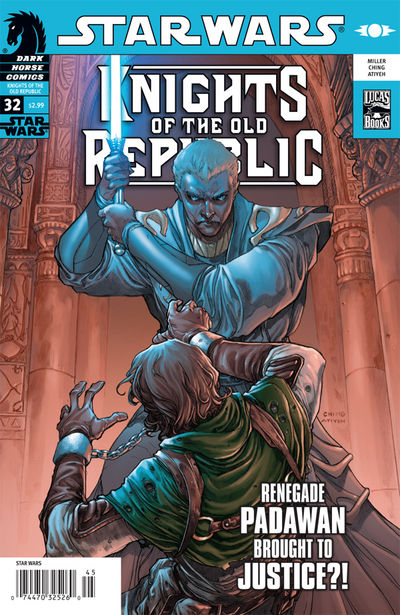
As Draay watched in horror, Haazen reveled in how Draay's seat on the Council had afforded the Covenant the necessary access, revealing that he had been manipulating Draay all along. Haazen also seized control of the Swiftsure's computer systems, gaining command of the Vanjervalis Chain, and directed the Republic fleet to target the bridge to the Draay Estate—resulting in the death of Xamar and fulfilling the Khil Jedi Master's role in the Rogue Moon Prophecy. Amid the ensuing chaos, Haazen cast aside his robes, revealing his disfigured body and the numerous Sith artifacts he had integrated into his form, proclaiming that the Prophecy of the Five had come to pass. Haazen recounted his past: how he, a servant of Barrison Draay, had trained alongside Barrison and Krynda Hulis, and was heartbroken when Krynda fell in love with Barrison and married him. Haazen failed to become a Jedi Knight, and he was swayed by the Sith to betray Barrison during the Sith War, resulting in severe mutilation. The Sith reconstructed him, and he later assisted Krynda Draay in establishing the Jedi Covenant, manipulating the organization from behind the scenes to further his own agenda.
Lucien Draay attempted to attack Haazen, but his efforts were rendered futile by Haazen's possession of the Gauntlet of Kressh the Younger, which prevented physical contact with its wearer unless permitted. Haazen expounded on his interpretation of the Prophecy of the Five: Q'Anilia represented the light in the darkness, Hierogryph was the one from the darkness who stood in the light, Carrick was the one for the light, and while Haazen stood apart from all, Draay was the one for the darkness. With Carrick and Draay as his subordinates, Haazen intended to command parallel armies of Jedi and Sith. Q'Anilia hastened to protect Krynda, and Hierogryph followed suit, but Lucien used the red-bladed lightsaber given to him by Haazen to prevent Carrick from following, and an enraged Lucien began to pursue Carrick through the compound. Upon reaching Krynda's chambers, he discovered Q'Anilia despondent over her teacher's apparent death. The Miraluka had ingested poisoned wine in an act of suicide, just as she had foreseen. In her final moments, Q'Anilia was astonished to learn that Hierogryph was, in fact, the one foretold by the Rogue Moon Prophecy: he had killed Raana Tey and stolen Feln's lightsaber, and he had worn the red space suit from the vision. Just as Q'Anilia died, having drank poison to commit suicide out of despair, Hierogryph realized that Krynda was not in fact dead—she was encased in an oubliette, just like the one Morne was placed in on Jebble.
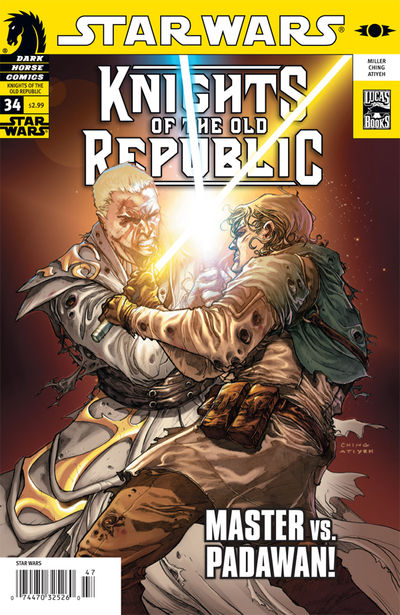
Lucien and Carrick's duel was interrupted by the arrival of Hierogryph with the dying Krynda, whom he had freed from the oubliette. Krynda was horrified that her son had killed the Padawans. She had foreseen the Massacre almost immediately after Lucien reported the Rogue Moon Prophecy, but she suffered a stroke and Haazen locked her in the oubliette, where she was forced to relive her vision of the massacre over and over. Lucien attempted to justify his actions by claiming he was trying to protect her, but as she died, Krynda acknowledged that her teachings were flawed and implored her son to face the future with humility. Enraged by his mother's death, Draay succumbed to the dark side and charged after Hierogryph, whom he blamed for Krynda's demise. Carrick held off Draay as Hierogryph fled, but as they battled, Carrick implored his former teacher to break free of Haazen's influence—and he was able to get through to the distraught Jedi Master, who finally decided to help Carrick. Meanwhile, Haazen killed the Covenant Jedi who brought him the Temple's Sith artifacts, and he witnessed Hierogryph enter the courtyard pursued by a furious Draay. Draay and Carrick battled once more over Hierogryph, but Carrick seemingly killed Draay after the Jedi Master was pinned under a falling statue of Barrison Draay.
To Hierogryph's disbelief, Carrick bowed before Haazen and pledged his loyalty in return for halting the bombardment of Coruscant. However, Carrick suddenly grabbed Haazen's arm and proclaimed that he was having a vision of the future—and as Haazen paused in interest, Carrick sliced off Haazen's prosthetic arm that bore the Gauntlet of Kressh the Younger. Haazen blasted Carrick with Force lightning and threw him toward Hierogryph, but to Haazen's surprise, both Carrick and the Snivvian went flying into the sky away from the compound. Draay emerged from the rubble and revealed that the fight had been a ploy to get close to Haazen, and using Haazen's arm—which also had the controls for the Republic fleet—Draay caused the fleet to fire upon the Draay Estate and destroys the entire compound, killing the now unprotected Haazen. Carrick and Hierogryph, meanwhile, land safely in a vat of sludge far away from the Draay Estate. In the days that follow, the Republic and the Jedi Order cover up Vindication by describing it as a terror plot by the Mandalorians, and only the families of the slain Padawans are told the truth of what happened. The Order pays off the bounties on Carrick and Hierogryph, officially clearing their names, and Malak is sent back to the Revanchists with a warning that the Council will not tolerate further involvement in the war.
Hierogryph decided to depart Coruscant with Slyssk after gifting Jarael Carrick's Padawan braid, assuming that Carrick was being Knighted. However, Carrick surprised his friend by declining the Order's offer, revealing his intention to embark on a business venture with Hierogryph and Jarael: a partnership that the Snivvian dubbed Cargryph Capital Management. Unbeknownst to the Republic and the Jedi, Draay survived the destruction of the Draay Estate thanks to the Gauntlet of Kressh, and he retreated to a moon that he had purchased some time ago as a private sanctum. Draay was profoundly affected by his brush with the dark side, and while the Gauntlet had preserved his life, he was blinded in the compound's destruction. On the moon of Draay 2, Draay resolved to synthesize the philosophies of his parents, establishing a true Covenant of Jedi dedicated to surviving the prophesied doom rather than attempting to prevent it.
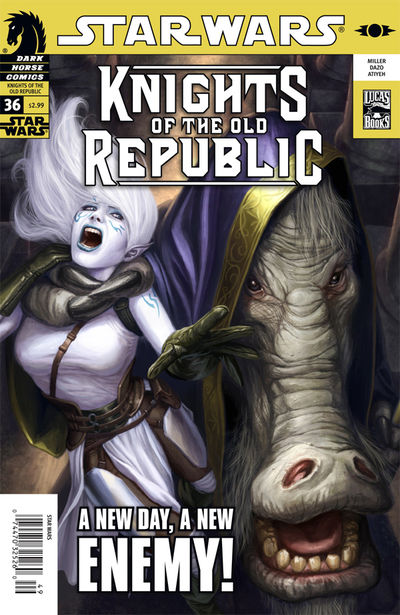
Carrick embarked on a brief respite, while Hierogryph dispatched Slyssk to Coruscant to acquire a vessel. However, the Trandoshan was deceived into purchasing the gem miner Hot Prospect. A month following Vindication, Hierogryph, Jarael, and Dyre proceeded to execute a scam on the trading hub of Metellos 3, which hosted an auction where interested parties could bid on the rights to entire planets. Hierogryph, adopting the persona of "Professor Gryphomarn," arrived at the auction, which Jarael and Dyre—disguised as an armored alien wielding a lightsaber-like weapon—proceeded to disrupt. The group convinced the auction attendees that Dyre hailed from the planet Italbos, recently sold at the auction, and Hierogryph assisted in conning the guests into bidding on Italbos once more, asserting that the planet possessed even richer mineral deposits than previously believed. However, when the Chev auctioneer Cipiter reported to his Chevin master Nunk Plaarvin, Plaarvin discerned Hierogryph's true identity and summoned the security team. Jarael and Dyre initially held their own against the Chev guards dispatched to capture them, but they were ultimately subdued. Hierogryph fled the scene and was pursued by security droids, but the timely arrival of Carrick saved the Snivvian from certain death.
Plaarvin, a crime lord within the Raff Syndicate, imprisoned Jarael and Dyre in the old solar observatory of the lunar station that his auction now occupied on Metellos 3. The observatory lens was set to incinerate the two when the sun rose, and they were chained together and suspended from the filter, preventing their escape. Meanwhile, Hierogryph and Carrick returned to the Hot Prospect, where they formulated a plan to rescue their friends by having Slyssk impersonate an enforcer of the Raff Syndicate. In the observatory, Dyre urged Jarael to tap into the Force, believing her to be Force-sensitive, and the chain binding them snapped moments before they were consumed by the sun. With Hierogryph and Carrick posing as his enforcers, Slyssk convinced Plaarvin that Hierogryph's con was a Raff Syndicate operation. The Chevin fell for their ruse and departed Metellos 3 to confer with the organization's leaders on Jebble. With Plaarvin out of the way, Carrick and the group left the auction in the hands of Cipiter and the rest of Plaarvin's Chev slaves, and Dyre instructed Carrick to commence teaching Jarael about the Force.
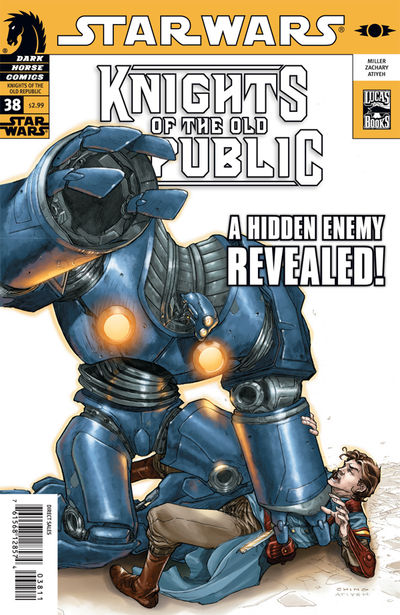
Carrick's attempts to communicate with Elbee, who has been unresponsive for several weeks, are unsuccessful. The Hot Prospect then stumbles upon the passenger liner Chancellor Fillorean floating aimlessly in space with all systems non-functional. Upon boarding, the crew is horrified to find that every passenger appears to have died from asphyxiation. The only survivors are the droid K-OB7 and his master, the Bimm Toki Tollivar. Tollivar recounts that passengers began dying mysteriously during hyperspace travel, leading him and K-OB7 to remain secluded in their cabin until emerging days later to discover the widespread deaths. As the crew investigates, Carrick is disturbed to see Elbee assisting K-OB7 in moving the bodies. Dyre's examination of the corpses reveals they were all strangled, a discovery immediately followed by an attack on Slyssk in the galley.
Dyre successfully saves the Trandoshan's life. Suspicion falls on K-OB7, prompting Dyre and Carrick to leave Jarael with Tollivar and Slyssk to pursue the droid. However, Elbee defends K-OB7, leading the droid to finally reveal that his master, Tollivar, is the one responsible for the deaths. Tollivar, a former Sith adept from the Sith War, has been using his Force powers to eliminate Republic citizens one by one. Carrick and Dyre arrive just as Tollivar is about to choke Jarael to death. In the ensuing struggle, K-OB7 turns on his master, electrocuting him to prevent further harm. Dyre shoots both of them to neutralize Tollivar's threat, warning Carrick that he is useless to the Mandalorian if he cannot protect Jarael. Later, Carrick continues his attempts to connect with Elbee, assuring the droid that he will be Elbee's friend if Elbee desires it.
The Gotal Goethar Kleej secures his fourth consecutive solo championship in the swoopdueling arena. However, when he attempts to reveal the Franchise entertainment firm's involvement with the slaving organization the Crucible, his speech is censored, and he is brutally assaulted by the henchmen of the event's coordinator, the Krish Bardron. Bardron offers Kleej a deal: if Goethar and his young son Aubin survive the upcoming Tandem Open, they will be granted retirement from swoopdueling. Shortly after, Carrick and his companions arrive at the space station Jervo's World, where Carrick is eager to experience the swoopdueling arenas. Meanwhile, Hierogryph has been orchestrating a con to defraud the Franchise, but his plans are disrupted when Carrick decides to enter the swoopdueling league to win a rare swoop bike. Carrick performs well in the trials, but Jarael and Hierogryph are forced to create a new identity for Dyre after he is confronted by security due to his Mandalorian armor. Dyre is rebranded as the swoopduelist "Spikes," and Carrick is surprised when Goethar Kleej threatens and pressures Carrick into protecting his son Aubin in the Tandem Open.
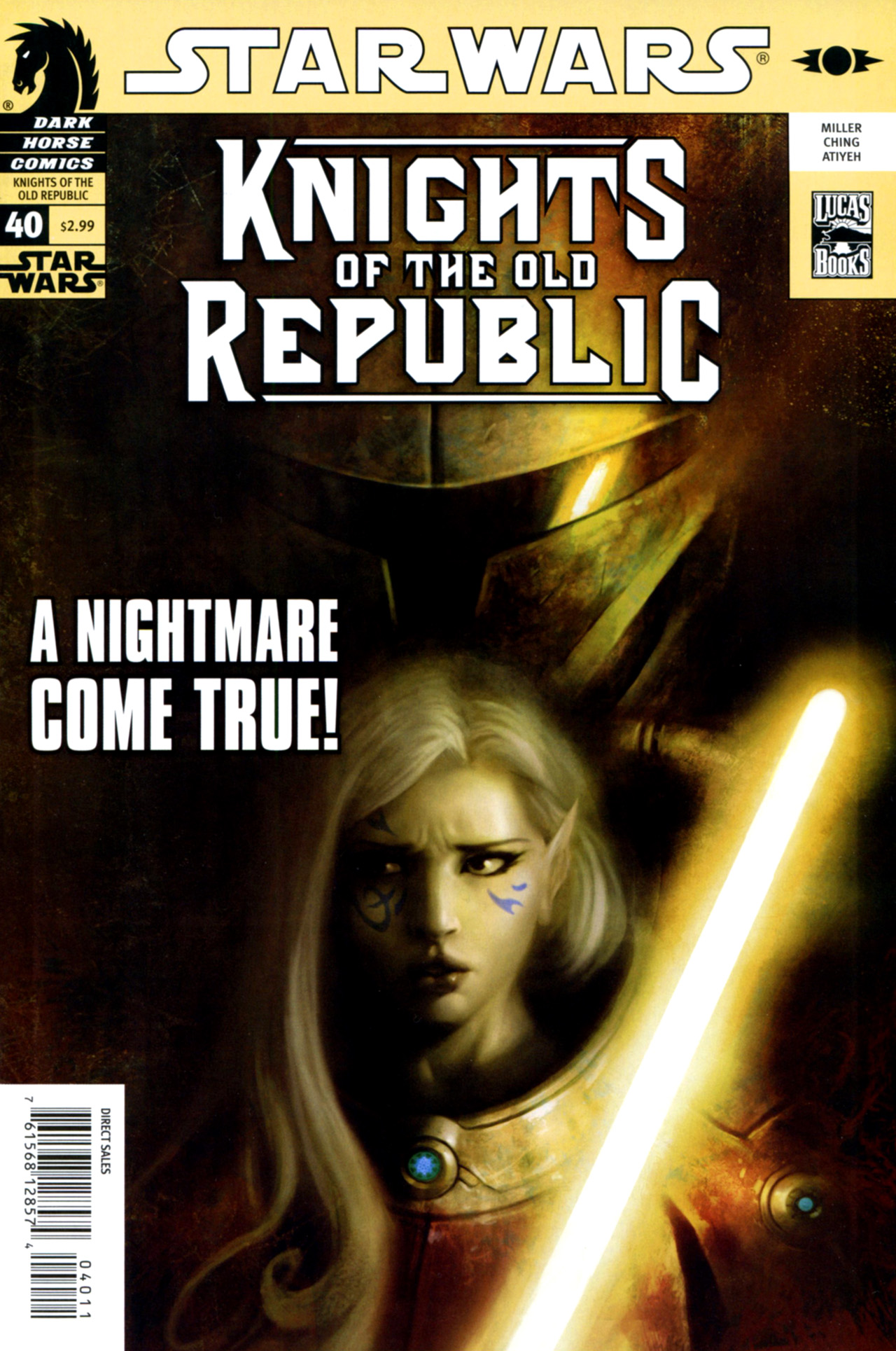
Goethar Kleej and "Spikes" reach the finals for their round, but Carrick struggles to keep Aubin safe as Aubin is overwhelmed by sensory input from his horns, a common issue for his species that Aubin hasn't been trained to manage. Jarael, burdened by the secrets she's keeping from Carrick, manages to steal the true recording of Kleej's speech. Carrick confronts Kleej about the speech, and while Goethar is powerless against the Franchise, Carrick uses his Jedi training to help Aubin control his horns. Jervo Thalien of Lhosan Industries, the owner of Jervo's World, is furious to learn that Carrick and Hierogryph are on his station and decides to eliminate Kleej to maintain his relationship with the Crucible. Unbeknownst to Thalien, Hierogryph overhears his plans and enlists Elbee and Jarael's help to thwart them. Meanwhile, Carrick, Dyre, and the Kleejs compete in the Tandem Open final. However, Spikes is incapacitated by enervation coils used by a competitor, revealing the match is rigged, and the Kleejs' accelerator is jammed, causing them to crash.
After rescuing his son from another competitor, Kleej agrees to collaborate with Carrick. The three escape the arena as Hierogryph and Jarael broadcast the recording of Goethar Kleej's speech about the Crucible to the audience. Amidst the chaos, "Spikes" emerges victorious in the remnants of the swoopdueling final, and the group successfully smuggles the Kleejs off Jervo's World to safety. However, Goethar Kleej recognizes Jarael's tattoos as those used by the Crucible and angrily accuses Carrick of working with the organization. Confused, Carrick presses Jarael for the truth, and she reveals that she was once a member of the Crucible before meeting Camper. On Jervo's World, Thalien is executed by the Crucible's Magister Impressor Chantique for failing to contain the Kleej incident, and she is intrigued to learn that Jarael was part of the group who disrupted the Franchise's operations.
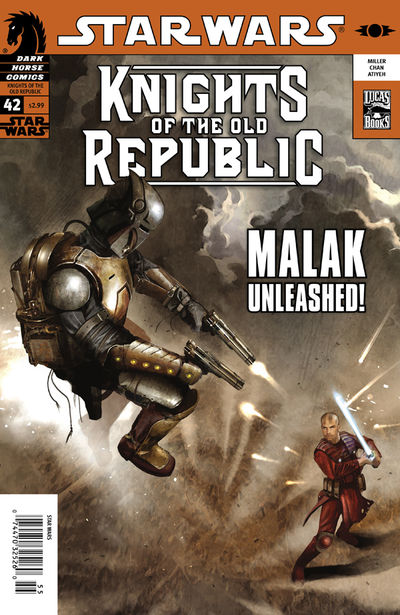
With her secret revealed, Jarael becomes distant from Carrick as they pause on the planet Wor Tandell. She confides that she was kidnapped as a child and managed to overthrow her overseer, taking her place to improve the lives of other slaves. Carrick encourages her to confide in her friends and offers to help her dismantle the Crucible, but Jarael refuses. Returning to the Hot Prospect, Jarael is surprised to encounter Malak, while Carrick meets the Cathar Jedi Ferroh, a former prisoner from Flashpoint, along with a Republic Navy vessel in the nearby capital of Gantra Lea. Ferroh explains that the Revanchists have been permitted to join the Mandalorian Wars and that he is working with Captain Telettoh of the Testament. When Carrick questions the Council's change of heart, Ferroh recounts the story, mirroring Malak's retelling to Hierogryph, Jarael, and Slyssk. Ferroh returned to his homeworld of Cathar years prior, only to find his entire species had vanished. The Revanchist leader, suspecting Mandalorian involvement, began investigating with the Revanchists. The Jedi Council confronted them, demanding they stand down, but the Revanchist leader discovered a Mandalorian mask that triggered a shared vision of the past among the Jedi present.
The vision depicted the Mandalorians, led by Cassus Fett, herding the Cathar into the ocean and executing them all. A Mandalorian who protested the atrocity was killed alongside them, and it was her mask that the Revanchist found. Adopting the name Revan, the Revanchist leader donned the mask and vowed to keep it on until the Mandalorians were defeated. In light of the Cathar massacre, the Council allowed the Revanchists to join the war. Malak concludes by stating he has come for Jarael, seeking her to join the Revanchists and begin a relationship. However, an enraged Dyre attacks Malak, vowing that the Jedi will never have her. Telettoh and Ferroh intervene, ending the fight. To the surprise of both Malak and Jarael, Carrick kisses her in front of Malak, claiming they are in a relationship and promising to follow her wherever she goes. After Malak departs, Jarael thanks Carrick for saving her from him and decides to ask for his help in dismantling the Crucible.
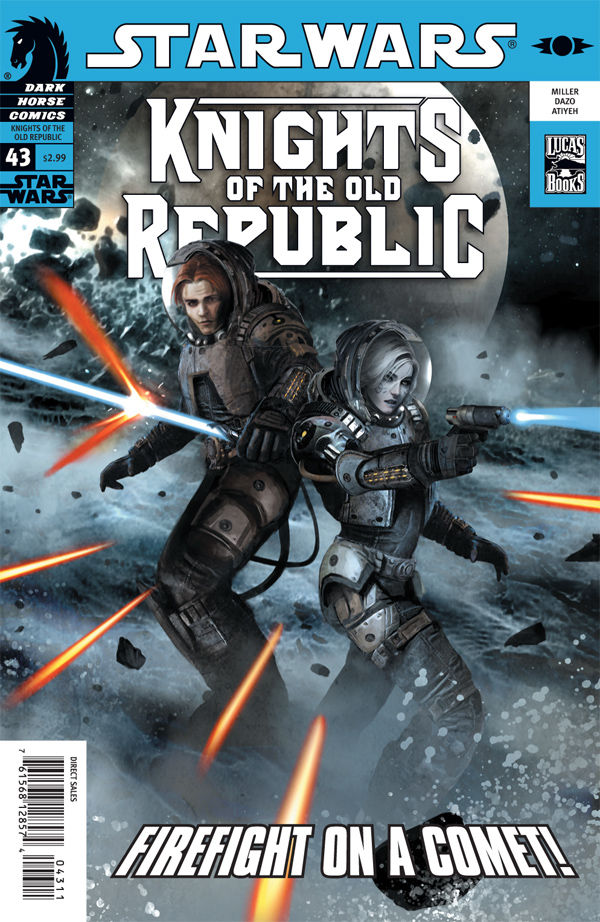
Within the Koornacht Cluster, the Hot Prospect crew launches their initial assault on the Crucible's operations by attempting to sabotage the Sungrazer cooperative, an asteroid mining operation that acquires slaves from the Crucible. Impersonating Crucible agents, Carrick and Jarael claim to be there to extract a larger share of the cooperative's profits, concealing their true intention to liberate the slaves. However, they underestimate the number of slaves, discovering eighty instead of the expected eight. When their deception is exposed, Carrick improvises a new plan: they join the slaves in dustdiving, the process of mining minerals on the surface of comets. Carrick then summons the Hot Prospect and uses the Force to move all the slaves onto the gem miner's hull, where Hierogryph reluctantly allows them entry despite his frustration at being deceived. However, skyreaper drones, droids used by the Crucible, attack the slaves, and the Crucible ship Gladiator forces the Hot Prospect to surrender.
Jarael recognizes the ship as belonging to Captain Dace Golliard, the Crucible agent who recruited her into the organization. Dyre rescues Carrick and Jarael from the skyreapers, but the Hot Prospect is unable to move due to its mining of crystals from the comet. The Hot Prospect disengages and uses its harpoon drill against the Gladiator before releasing tanks of xenoboric acid from its hull. Despite Hierogryph's protests, Carrick uses the ship's mining centrifuge to spin the Hot Prospect and break free from the Gladiator. After dropping the slaves off at a transit hub, Jarael reveals her past to the others, and Hierogryph reluctantly agrees to aid her and Carrick in their fight against the Crucible. Meanwhile, Chantique tortures Golliard for his failure and prepares to execute him, but the Magister Protector of the Crucible, Bar'injar, intervenes. On Coruscant, Demogal awakens from his month-long coma, and the Defense Ministry is immediately notified.
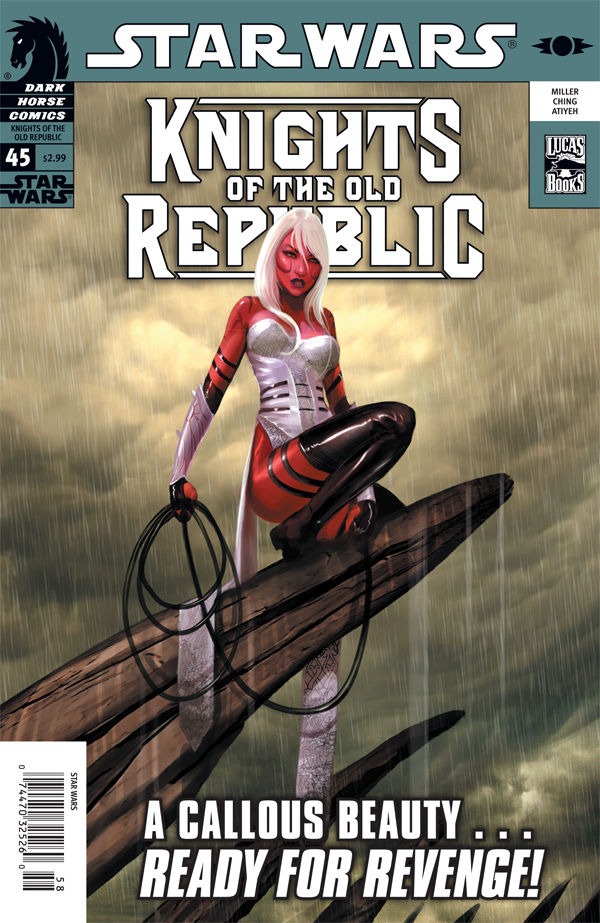
While overseeing the fighting pits on the planet Volgax, Chantique reflects on how her own father offered her to the Crucible as part of a deal. Zayne Carrick, meanwhile, goes undercover, allowing himself to be captured by the Crucible in a Navy fighter under the alias "Carth Kamlin." He is taken to Volgax and forced into the pits. Despite his reluctance, Carrick must fight other slaves to survive, including the Caamasi Snout, and Chantique takes a particular interest in him. Carrick tries to connect with Snout, who he learns has inherited the memnii, the collective memories of many other Caamasi within the Crucible. Identifying Carrick as a Jedi, Snout shares his memnii with Carrick, forcing him to relive lifetimes of pain and suffering as he explains that the ancient Sith Ieldis created the Crucible to produce armies. Despite Ieldis's death centuries ago, the Crucible has continued its operations, and a shell-shocked Carrick is taken to Chantique's private chambers. The Zeltron woman manipulates Carrick, attempting to turn him against Jarael by claiming she enjoyed her position in the Crucible and that her name meant "Destroyer."
Aboard the Hot Prospect, Jarael is concerned by the lack of communication from Carrick and his tracking beacon. She decides to speak with Elbee, as she overheard Carrick talking to the droid earlier. However, Elbee reveals that Carrick was speaking through Elbee's holoprojector, and he connects Jarael to Shel Jelavan. On Volgax, Chantique tells Carrick how Jarael betrayed her and took her position as overseer, and how she sought out the Crucible after escaping slavery and becoming the organization's leader. However, Carrick realizes Chantique is manipulating him through the Force. Carrick is thrown back into the pits, where he is forced to fight Snout in a death match. To Carrick's horror, Snout kills himself by purposefully falling on Carrick's knife, and a delighted Chantique orders the Crucible to depart Volgax. The Hot Prospect arrives shortly after, but Jarael finds Carrick in the rain, and he confronts her with Chantique's stories. Carrick asks for time to process what he has learned, but Jarael, furious that he believed Chantique's lies, storms off after revealing that the name "Jarael" actually means "Protector."
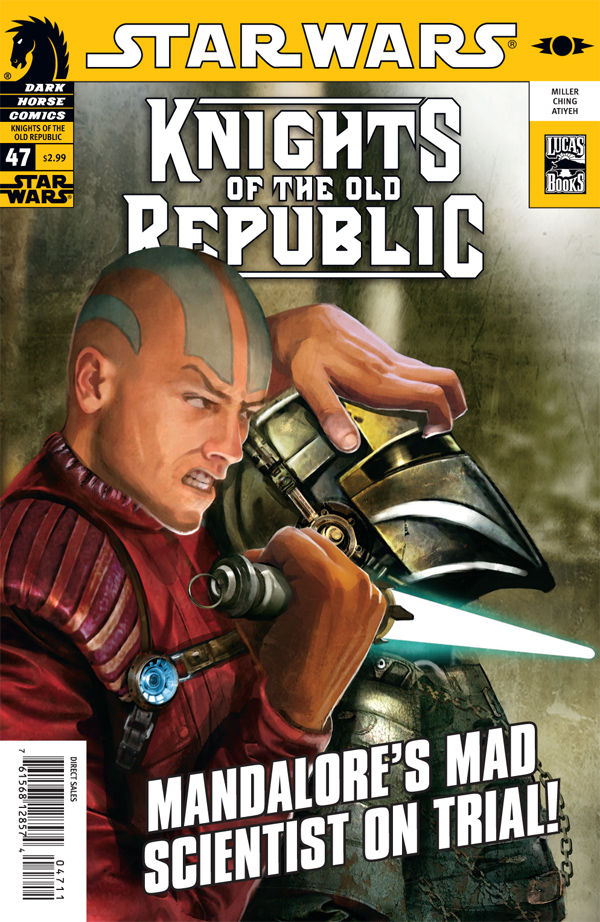
Upon hearing of Demagol's return to consciousness, Defense Minister Koa Delko schedules a public [trial](/article/trial_of_demagol] for the Mandalorian, and Rohlan Dyre urges Carrick, Slyssk, and Hierogryph to travel to Coruscant and testify. Malak joins them at the trial. During a conversation with Carrick, Malak mentions that they found Eejee Vamm's mutilated corpse when salvaging the Arkanian Legacy, and Carrick withholds the fact that "Dyre" is with Jarael. Hierogryph accuses Carrick of stealing money his father managed for them, and Carrick admits to borrowing it for a "special project" before demanding to know how Hierogryph and Slyssk escaped Serroco. Coincidentally, their argument leads them to large statues of the Snivvian and Trandoshan, and Hierogryph explains they are part of his restaurant. On Serroco, Slyssk saved Hierogryph's life by taking control of a troop transport that was slow to depart, saving half a battalion. The Defense Ministry turned them into propaganda figures: Hierogryph became Captain Benegryph Goodvalor, and Slyssk his Trandoshan sidekick. The Republic developed licensed propaganda and merchandise, such as the restaurant chain, based on them.
However, when Carrick makes a casual comment to Elbee about Dyre breaking his hand back at Vanquo, Elbee shocks them by revealing that the Mandalorian they are traveling with is not the same one they met at Vanquo. Elbee had carried them both at different times in Camper Specials, and they weighed differently. Hierogryph, Carrick, and Slyssk reflect on their experiences with "Rohlan Dyre" and notice inconsistencies, such as his interest in medicine and science. Remembering Dyre once referring to Carrick as "Human," Carrick recalls that Demagol was not Human. The group realizes they have been traveling with Demagol all along. Understanding the gravity of the situation, Carrick and Hierogryph resolve to save Jarael from Demagol and rescue the wrongly accused Rohlan Dyre. At the trial, Dyre breaks free, and Malak uses the Force to throw him across the [Senate Chamber](/article/senate_building-legends]. Carrick, disguised as a security guard, smuggles Dyre out as the crowd riots. Dyre is taken to a speeder piloted by Hierogryph, and he and Carrick apologize to Dyre as they flee and ask for his help in saving Jarael. Meanwhile, Jarael and Demagol leave Wor Tandell, and Demagol reveals himself to Jarael as Antos Wyrick, the man who oversaw the [Osadia School](/article/new_generation_academy] where Jarael grew up.
Jarael is overjoyed to see Wyrick, who lies and claims he has been Rohlan Dyre since the Crucible attacked the Osadia School and took his students. He reveals he has taken them to the planet Osadia to rescue Jarael's fellows. On Coruscant, Hierogryph and Carrick hide Dyre in an abandoned warehouse, where Dyre explains that Demagol drugged him and switched armors on Flashpoint. Dyre explains Demagol's past: how he was raised by the cyborg Iskalloni, adopted into the Mandalorian clans, and taught by Mandalore the Ultimate. After finding one of Jedi Master Arca Jeth's hairs on a robe owned by Jedi [Ulic Qel-Droma](/article/ulic_qel-droma-legends], Wyrick dedicated his life to [creating Jedi for the Mandalorians](/article/new_generation_project]. Jarael was one of the children born as part of the project, and after the Crucible destroyed it, Wyrick became Demagol and dedicated himself to unlocking the secrets of the Force through science. The group realizes that Chantique is Wyrick's daughter just as Shel Jelavan and Slyssk arrive, and Carrick shows Hierogryph and Dyre that the warehouse is actually the [base](/article/rogue_moon_project_command] of the [Rogue Moon Project](/article/rogue_moon_project]: an organization founded by Carrick with the help of the families of fallen Padawans to help refugees, wrongly accused fugitives, and others in similar situations to Carrick's past.
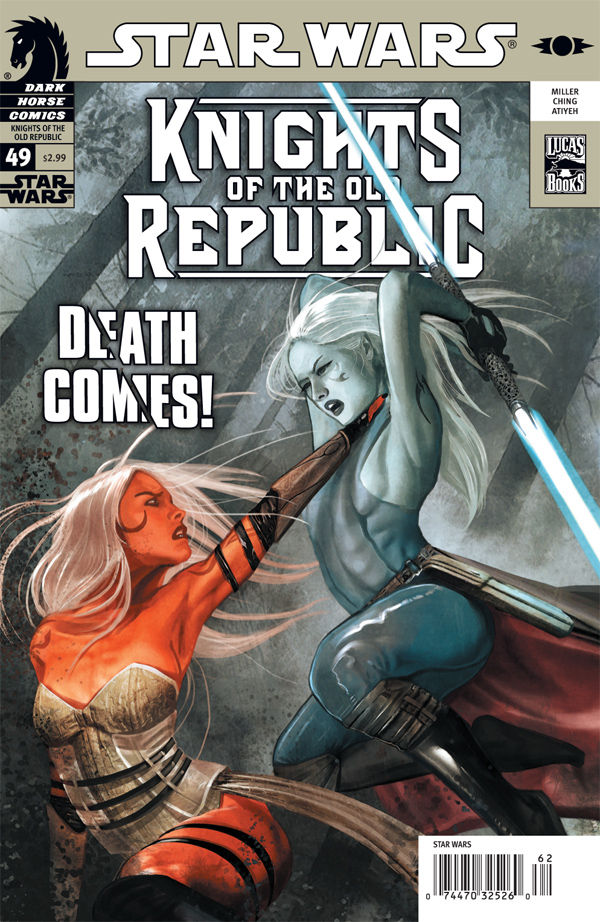
On Osadia, Wyrick and Jarael prepare to raid the Osadia School, now occupied by Chantique's forces, and Wyrick gives Jarael the [double-bladed lightsaber](/article/exar_kun%27s_lightsaber-legends] of Exar Kun. Carrick and the others realize that Demagol has the weapon when Slyssk finds the saber's tag from the Sanctum of the Exalted, and Carrick develops a plan to locate and rescue Jarael, involving Cassus Fett, the Republic Navy, and the Crucible's Dace Golliard. At Carrick's instruction, Dyre contacts Cassus Fett and calls in the favor Carrick owes him, and Jelavan pulls strings in the [Republic Military](/article/republic_military-legends] and Senate to get Admiral Karath to follow an anonymous tip to an asteroid field near the [Ithor system](/article/ottega_system-legends], where Cassus Fett's forces have gathered. As Carrick predicted, Dace Golliard and the Gladiator arrive and hide in the asteroids to pick up any escape pods. However, when Cassus Fett's ships swarm the Republic forces, they jump to hyperspace just before a collision, and Carrick informs Karath of Golliard's presence. Karath's forces capture the Gladiator, and Cassus Fett declares him and Carrick even while also thanking the former Jedi for dealing with Demagol. Golliard is interrogated about Chantique's location by Carrick and Karath, and Carrick learns that Chantique went to Osadia after a Force vision.
On Osadia, Jarael defeats the [Dashade](/article/dashade-legends] guards around the school while Wyrick infiltrates the building and interrogates Bar'injar about the location of his students. When he fails to gain any useful information, he returns to Jarael, who is shocked to see him execute the fallen Crucible agents in cold blood before resuming the search. Meanwhile, Carrick calls in another favor: Captain Telettoh of the Testament gives him, Hierogryph, and Dyre a lift to Osadia. Hierogryph also confronts Carrick about his relationship with the Force, as he has become suspicious of Carrick's luck, and Carrick explains that his control of the Force causes fate to "rock back and forth" between good and bad, and he has developed better control since Vindication. While searching the training hall on Osadia, Jarael encounters Chantique and they begin to fight. As Jarael gains the upper hand, she prepares to execute the Zeltron. However, the Testament arrives, and Dyre carries Carrick by jetpack over the school and drops him into the training hall just as Carrick lands on top of Jarael. Chantique seizes Exar Kun's lightsaber and attacks Carrick, demanding to know why he continues to defend Jarael despite what she told him on Volgax.
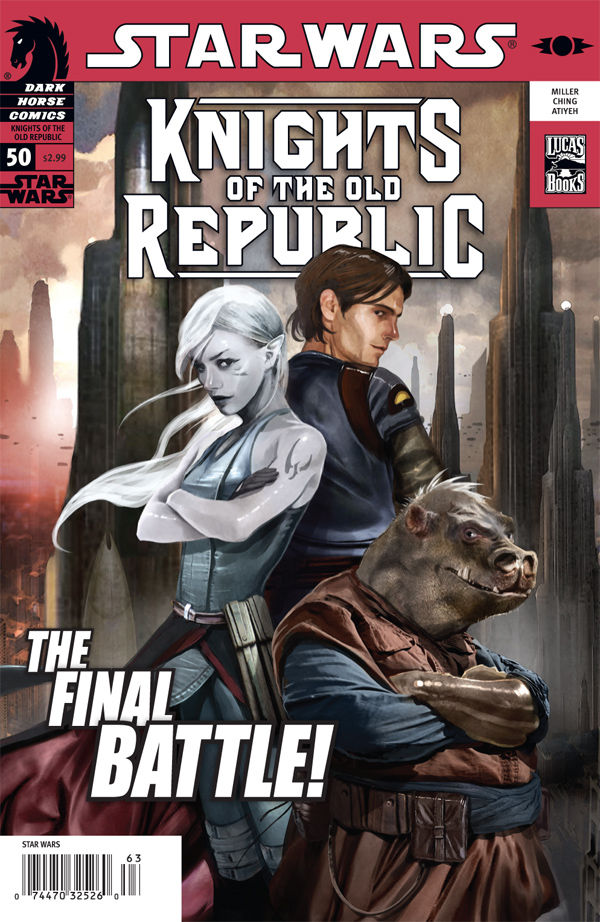
Carrick disbelieves Chantique's fabrications and informs her that her father is present at the school. Simultaneously, Dyre launches an assault on Demagol in another sector of the institution, only for the scientist to surprisingly repel Dyre with a simple gesture. Carrick promptly clarifies to Jarael that Demagol is actually Wyrick, cautioning her about the sinister might of Kun's weapon. However, he's taken aback when she fails to detect anything from the lightsaber, a stark contrast to Chantique, whose abilities are amplified by the weapon. Yet, Chantique is caught off guard by a knife thrust into her back by Wyrick, who disregards his daughter's entreaties and demands to see his students. Wyrick bolts into the schoolyard, only for Chantique to reveal that they were, in fact, in the schoolyard all along, having been buried alive by her, one by one, over the years. Wyrick snaps out of his despair upon realizing he can persist with his project using Jarael, but Carrick exposes Jarael's complete lack of Force sensitivity. Dyre then emerges from the school, unveiling the truth: Wyrick and his daughter had possessed Force sensitivity from the start. Wyrick barely has time to process this revelation when Chantique assaults him with a knife, compelling him to reach for Carrick's and Kun's lightsabers nearby. To everyone's astonishment, Kun's lightsaber is the one that reaches Wyrick first, and the double-bladed lightsaber pierces both father and daughter.
Some days afterward, Carrick has given Kun's lightsaber back to the Jedi Order. To celebrate the anniversary of the day that he and Jarael first encountered one another, he presents Jarael to her parents, who he and Dyre successfully located. However, Dyre vanishes shortly thereafter, and Carrick and Jarael surmise that he has resumed his pursuit of answers. The following evening, Carrick is summoned to Goodvalor's Little Bivoli by Hierogryph, who reveals that he and Slyssk will assume the management of their burgeoning restaurant chain, while Carrick opts to continue his involvement with the Rogue Moon Project. Before Carrick departs, Hierogryph directs him to table seventeen, where Jarael awaits to dine with him. After expressing her gratitude for his efforts in finding her parents, Jarael kisses him, and the two commence dancing, marking the beginning of their official relationship.
Dark Horse Comics's foray into the Old Republic era began with the Tales of the Jedi series during the 1990s, with its inaugural trade paperback released as Tales of the Jedi: Knights of the Old Republic. In 2003, BioWare launched the Star Wars: Knights of the Old Republic video game, situated thirty years after Star Wars: Tales of the Jedi - Redemption, the final narrative arc of Tales of the Jedi. From 1999 onwards, Dark Horse refrained from producing any Old Republic era stories until the arrival of the anthologies Star Wars Tales 23 and Star Wars Tales 24, which presented two narratives—"Shadows and Light" and "Unseen, Unheard"—that intertwined with Knights of the Old Republic and its follow-up, The Sith Lords. By 2005, Dark Horse was keen on revisiting the Old Republic era. In early 2005, John Jackson Miller was nearing the conclusion of a story arc for the then-ongoing series Star Wars: Empire with artist Brian Ching when Dark Horse editors Randy Stradley and Jeremy Barlow approached Miller, seeking to commemorate Dark Horse Comics' approaching 20th anniversary in 2006.
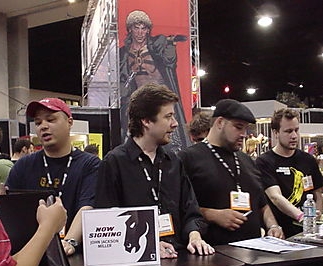
Miller and Stradley initiated discussions regarding elements they appreciated in Star Wars comics, such as drama, camaraderie, and humanity. Miller then began formulating ideas for a series to debut during Dark Horse's 20th anniversary in 2006. Miller, Barlow, and Stradley scrutinized aspects of the original Star Wars movies they aspired to replicate in print. Miller primarily focused on a quote by Princess Leia Organa in the Star Wars Episode IV: A New Hope novel: "They were in the wrong place at the wrong time. Naturally, they became heroes." The group also deliberated on the recurrent theme in the prequel trilogy of the Jedi's oversight of events unfolding around them, concentrating this concept on a single character and its ramifications. Miller inverted the trope of an apprentice betraying a master, contemplating what might compel a Jedi Master to betray a student, thereby conceiving the series' inaugural arc, Commencement—originally titled Renegade. The series was initially conceived without a specific era or timeframe; the primary emphasis was on the character of Zayne Carrick, rather than the ongoing conflict of the Mandalorian Wars. Once the Old Republic era was selected, Miller scrutinized the Knights of the Old Republic games, determining that his narratives would resonate best if set several years prior to the games. This approach allowed the series to incorporate elements from both Tales of the Jedi and the video games. The Jedi Covenant emerged from the notion of how a Jedi would react to history's tendency to repeat itself, and Miller vowed to avoid introducing any mysteries in the series for which he lacked answers. Miller's proposal for the series garnered positive feedback from both the developers of Knights of the Old Republic and LucasFilm. Miller made minimal alterations to the original pitch, except for Hierogryph, who was initially an Ortolan—a species renowned for their cunning criminals. Following the story's approval, Miller and artist Brian Ching commenced work on the series with colorist Michael Atiyeh. Michael Heisler served as the series' sole letterer, overseeing all fifty issues of Knights of the Old Republic.
For the character of Zayne Carrick, Miller drew inspiration from the scene where Han Solo invites Luke Skywalker to become a smuggler. Carrick also partially stemmed from Miller's desire to capture the essence of the initial levels of the Knights of the Old Republic video game, specifically the early stages where players are still acclimating to the controls. However, Ching soon realized the difficulty of conveying expressions on an Ortolan's mouthless face, prompting Miller to suggest a Snivvian instead. Atiyeh and Ching crafted detailed visuals for each of the series' characters, and by August 2005 at Comic-Con International in San Diego, most of the first issue was complete, and Miller had scripted several issues ahead. The script for the first issue had been finalized and submitted by May 2005. In designing Jarael, Brian Ching prioritized avoiding an overtly sexualized appearance for the character. Ching's design, particularly her tattoos and deviation from typical Arkanian appearances, significantly influenced Miller's conception of Jarael's backstory, which he fleshed out during the series' early years. The series was formally announced in July 2005 at Comic-Con 2005 as part of Dark Horse's 20th anniversary celebration, set eight years before the events of the first Knights of the Old Republic game. Around November 2005, an advertisement for the series erroneously claimed it was set eight thousand years before the Battle of Yavin, an error Miller rectified by reaffirming the date of 3964 BBY.
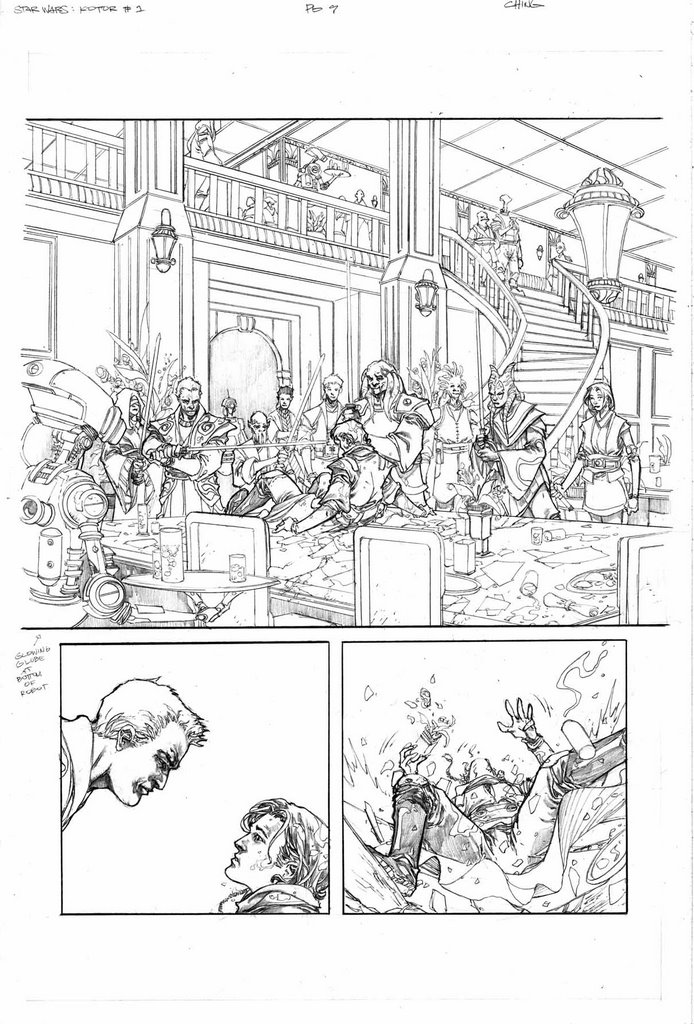
Each issue of the series was given a complete plot which was then given the go ahead by the editors, and then Miller would write the issue. The artist would then draw the issue, and then the issue is colored and lettered in tandem. Printing was the last step, and took several weeks; in general, an issue took about one month to finish, but that month could be spread over an entire year depending on the issue and the creative team's workload at the time. Miller made a determined effort to make every detail in the series count, and he made large plans on how the series would fit into overarching Star Wars continuity. The first issue was made available on January 25, 2006, 363 days after Miller and Stradley had had their first discussion about the series. Miller deleted Ching's precursory drawing of the double-page scene in Commencement, Part 1 from his computer to prevent himself from accidentally sending it to fans, as he wanted to keep it a secret until the issue's release. Ching and Miller also worked very hard to create Carrick's and Lucien Draay's expressions for the final page of the issue. When the series was first released, Dark Horse was let down by the initial sales of #1; however, the issue soon sold out and went to a second printing. By June, orders for Knights of the Old Republic had gone up in numbers and was performing better than Star Wars: Rebellion.
Miller decided to do away with an omniscient narrator and thought bubbles that describe the action in the issues. The covers for the fist arc of the series were drawn by Travis Charest, and the cover for issue #1—Carrick holding the slain Padawan Kamlin in his arms—was created well in advance based on general plot information. The inside cover to issue #2 mistakenly credited Brian Ching with the cover art instead of Travis Charest, and the dialogue bubbles in that issue's garbage can scene were accidentally switched. For the banquet scene in issue #1, Brian Ching originally made the banquet as a particularly busy scene with a lot of details, but he got rid of it in favor of a set of panels that focused more on the five Masters and was less "boring." Early on during the creation of the first major "meta-story" for the series, Miller told his editors he wished to explore the tensions between the Unifying Force and the Living Force, the two main schools of thought on the Force. As a result, the Covenant Jedi in Commencement are dedicated to the Unifying Force to the point where it affects how they value the living. Carrick's speech at the end of Commencement was also one of Miller's first ideas for the series, and the fact that Hierogryph was responsible for Carrick's "prophecy" was an element that was presented in the series pitch. As Miller continued with the creation of Commencement, he realized that he had material for a prologue story that would help fans get their bearings in the new era. Miller suggested the possibility of doing a prologue as a promotional comic for Free Comic Book Day, but editor Jeremy Barlow came up with the idea of a 25-cent special earlier in the year. Late in the process, Miller suggested the Taris Holofeed, basing the idea and format on the Star Wars Insider magazine. The production team took a break in the creation of Commencement, Part 3 to create the Knights of the Old Republic/Rebellion Special, making the third issue's creation time longer, and Knights of the Old Republic/Rebellion #0—which contained Knights of the Old Republic 0—was made available on March 1, 2006, only a week after Commencement, Part 2.
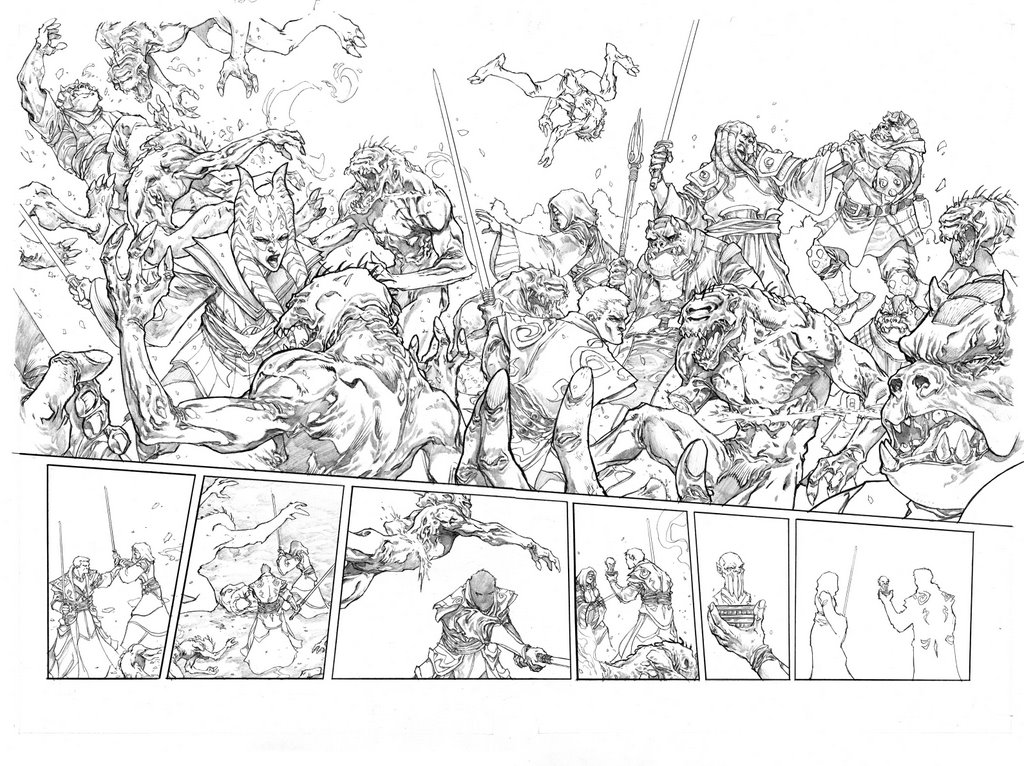
While drawing the scene of the Covenant members fighting rakghouls and Gamorreans in the Undercity—a callback to the presence of Gamorrean enemies in the Undercity sewers in the original video game—Ching thought the sequence was shorter than he would have wanted, a problem that he found to come up a number of times in the early stages of the series' creation. The Taris police officers that appeared in issue #3 had been created by Ching and Atiyeh, who saw the officers as analogous to the clone troopers from Star Wars: Episode III Revenge of the Sith—there were a number of variations on the troopers' uniforms depending on which planet they were on. Atiyeh came up with the idea to give the officers different colors, and Ching created new helmets and gear, but when the script for issue #3 was written, there was not enough space to feature the officers to the degree that the artists wanted.
Miller considered the heart of Commencement, Part 4 to be the conversation between Zayne Carrick and Master Tokare, and he especially enjoyed using the conversation to introduce the possibility that Carrick was actually responsible for the murders of his fellow students. For Taris's Rogue Moon, Miller provided Ching with his own visual reference of the moon that he created by piecing together fragments of an image of a planet's surface. Miller also dedicated a number of pages to set up the working relationships between the crew of The Last Resort, as he felt that it was important to introduce their dynamics. Issue #5 saw guest artist Travel Foreman fill in for Brian Ching in order to keep the series on schedule, as the creation of Crossroads had necessitated Foreman to fill for Ching. Travel Foreman took Miller's advice on the sequence showing the Rogue Moon Prophecy, using a style similar to the Doctor Strange artist Steve Ditko to create a vision experienced by a number of minds at the same time. Miller debated whether to show Elbee's point of view during the vision, but he ultimately left it out. For the droid Elbee, Miller suggested that he be small enough to move around in The Last Resort, but large enough to resemble the loaders that appeared in the movie Aliens.
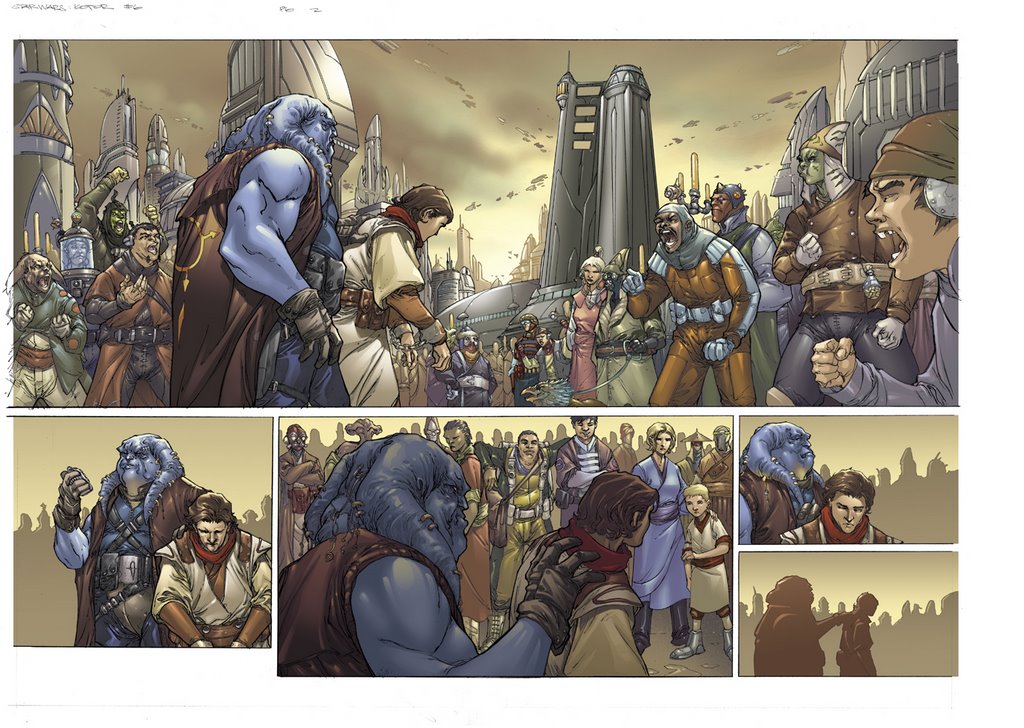
In his production notes for issue #6, Miller admitted that the chapters of Commencement that follow the Padawan Massacre mirror the five stages of grief: denial in #2, anger in #3, bargaining in #4, depression in #5, and acceptance in the last pages of #5 and in issue #6. Miller gave a lot of attention to finding the tone for the scenes in Commencement, Part 6, especially Carrick's final speech to the Masters. For Valius Ying, Miller suggested to Travel Foreman and Brian Ching that he be based on an alien Tony Soprano—a gang leader who is full of himself and later realizes he's out of his depth. For Commencement, Part 6, Miller and Ching originally had Jarael plummeting towards the Jedi Tower's skylight in a background shot before she crashed into the Tower, but they ultimately removed her from the scene to preserve the mechanics of the scene. The mob scene at the beginning of the issue was one of Ching's favorite pages to draw, something that allowed him to include both new and recognizable characters, and he added in a number of characters that were based on his own friends. The Commencement arc was later collected along with Crossroads in Star Wars: Knights of the Old Republic Volume 1: Commencement, which was made available on November 15, 2006. The trade paperback also identified the Senator from issue #1 as Senator Goravvus, who had gone unnamed in the original printing; however, The Taris Holofeed was not included.
Dustin Weaver became part of the creative team for the series with issue #7 as a joint artist for the series, alternating story arcs with Brian Ching. Flashpoint, Part 1 shifts gears to focus on the Mandalorian Wars, showing the influx of new recruits of a number of different species among the Mandalorians and hinting at the conflict between their culture's typically loose command structure and their status as an invading force. Miller was happy to give more time devoted to Elbee, who he had hoped to develop further in Commencement before he decided to focus more on the Master's vision. In the production notes for the issue, Miller revealed that Elbee's name was taken from the character Bartleby the Scrivener in a story by Herman Melville. Because the series starts before the Knights of the Old Republic game, Miller was able to delve into the early stages of the Mandalorian Wars, and he compared the conflict shown in the Flashpoint arc to the kind of military action in remote theaters that preceded all-out war. The Courageous, the flagship of Admiral Saul Karath, earned its name through an obscure connection to Karath's flagship Leviathan in the video game: the Leviathan was a reference to the real-life British Royal Navy class of the same name, and the real-world class was based on the design for the French vessel Courageaux. Rohlan Dyre's first name was partially inspired by the name of Roland, a paladin of Charlemagne. The Flashpoint arc and the Battle of Vanquo was something that had been in planning since the early stages of the series' creation; Vanquo was meant as "the Mandalorian equivalent of Pearl Harbor" in that it disrupts the lives and plans of the characters in the series with sudden conflict.
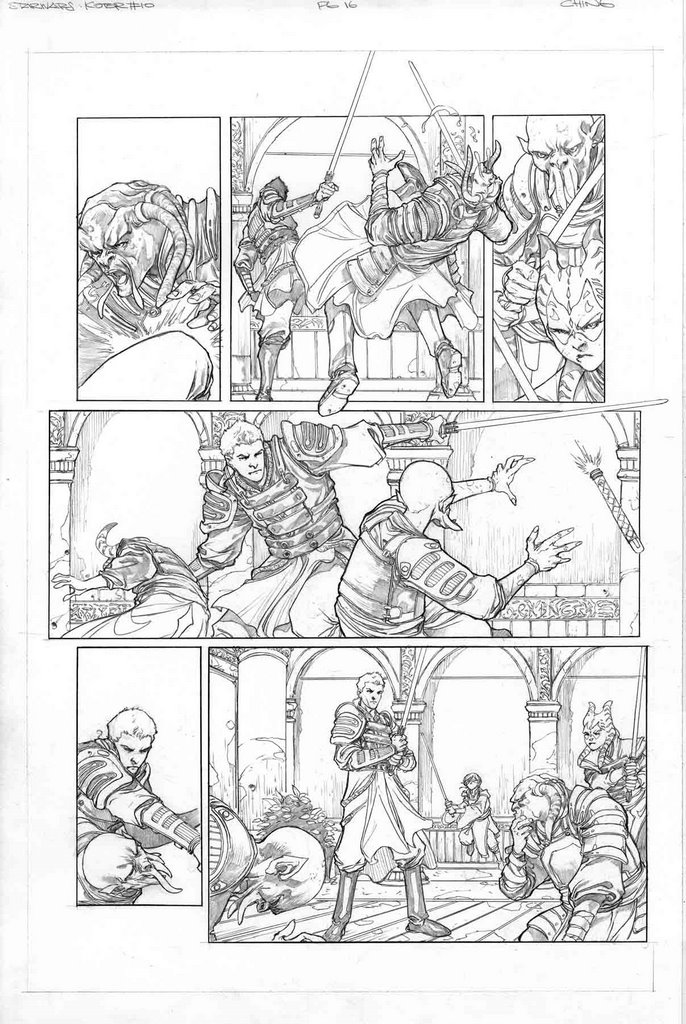
The ninth issue of the series, Knights of the Old Republic 9, was created as a stand-alone tenth issue that focused on Lucien Draay. Miller had wanted to do a single issue focusing on the Covenant in the first year of the series, modeling it after stories such as the Marvel comic Star Wars (1977) 29 and Neil Gaiman's Hob Gadling story. However, Miller lost half of the script for the issue because of a hard drive problem, and both the file and its backup became corrupted after a power failure. Miller ultimately gave up trying to recover the script and rewrote it instead, but another problem came up with art scheduling. Dustin Weaver was originally scheduled to work on issues #7-9, the Flashpoint arc, while Brian Ching was to work ahead on #10, but when Ching finished his work first, the standalone issue was published before the unfinished final issue of Flashpoint. The events of the two issues took place at the same time, and marked the transition from the year 3964 BBY to 3963 BBY, seven years before the Knights of the Old Republic game. The cover art for Flashpoint and Homecoming was handled by Brian Ching and Michael Atiyeh. While working on Flashpoint, Miller worked with Star Wars writer Karen Traviss for information about the Mandalorian culture and their language, Mando'a. In Homecoming, the creative team designed the flashback sparring scene between the Covenant Jedi so that it could show Lucien Draay assert his dominance and leadership over the others, and the Draay Estate's architecture was inspired by Moorish buildings in Spain.
For the issues following Commencement, the next six issues were originally planned to be broken up into three smaller stories: a three-part story, a standalone, and a two-part arc. Doing so would allow Dustin Weaver to join in as the series' second artist, but the scheduling issues saw a third artist—Harvey Tolibao—take over for the sixth issue, Knights of the Old Republic 12, which was also colored by guest colorist Jay David Ramos. The two-part Reunion arc was intended as a comical departure from the heavier tone of the preceding arcs and the storylines to come in 2007. The storyline, which was originally titled Target of Opportunity until Miller suggested renaming it to fit with the single-word titles of Commencement and Homecoming, was intended to show the working relationship between Hierogryph and Carrick. Reunion's title was also a hint to the identity of Arvan Carrick, and Miller described the bank on the planet Telerath as having a central tower with spidery veins spreading across a beautiful countryside; Ching expanded on the design, adding a sea, islands, and airships. The illustrator HOON drew the cover art for the two Reunion issues.
For issue #11, Ching used the issue as an opportunity to completely reinvent the appearances of Camper and Jarael, and he based Camper's "Baron Margryph" appearance on that of Mr. Peanut, giving him a monocle and a handlebar mustache. Having different artists for the two issues presented some art problems: the Moomo Brothers are identifiable by the colors of their scarves, though issue #12 reversed the colors of the scarves and created confusion as to which was which. Flashpoint, Homecoming, and Reunion were all collected in Star Wars: Knights of the Old Republic Volume 2: Flashpoint, which was made available on May 16, 2007. Volume 2 restored the order of Flashpoint, moving Homecoming to after the end of Flashpoint, but the creative team chose not to remedy the Moomo Brothers' scarf issue, opting instead to use one of the brothers' scars as the differentiating factor. The creative team also took time to go back into issue #11 and added sound effects and dialogue for the chase scene that had been excluded in the original release due to the scheduling rush.
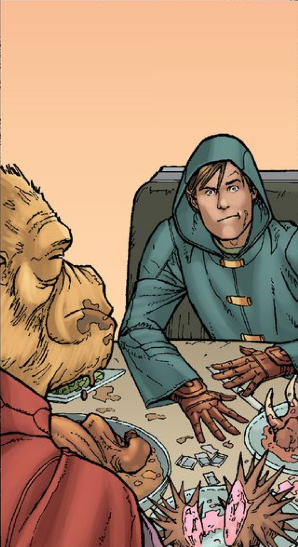
As the popularity of Knights of the Old Republic grew in early 2006, Miller started planning for 2007, creating a large narrative involving numerous characters that could be divided into smaller parts for the series' artists to work on in rotation. This strategy resulted in the creation of four interconnected story arcs: Days of Fear, Nights of Anger, Daze of Hate, and Knights of Suffering. These titles were inspired by Jedi Master Yoda's warning from Star Wars: Episode I The Phantom Menace: "Fear leads to anger; anger leads to hate; hate leads to suffering." The arc names were first formally revealed in the Drawn By The Force section of Star Wars Insider 91, which previewed the upcoming stories. While outlining the arc plots, Miller found it necessary to map out each character's story on a whiteboard to maintain clarity. Drawing inspiration from Roy Thomas's approach of separating the main characters in the Marvel Star Wars comics in Star Wars (1977) 7, Miller chose to split the crew of The Last Resort at the beginning of Knights of the Old Republic 13. The four arc titles were initially referred to as Days/Knights by Miller informally, and later officially, in the publisher's summary for issue #23. Miller later verified that Carrick's gaze into the "camera" in a scene from Weaver's Days of Fear, Part 1 was modeled after the frequent looks given to the camera by Jim, a character from the US version of the TV show The Office.
Also in issue #13, the creative team introduced Zayne Carrick's phrikite vambraces, the character's first unique piece of equipment and an element that had been a part of Brian Ching's design for the character since his inception. Dustin Weaver was responsible for the artwork in issues #13 and #15, while Brian Ching illustrated issue #14, the second part of Days of Fear. Days of Fear also marked the return of the supplemental news sources, with The Admiral's List: Jimas Veltraa Memorial Edition, The Adjudicator Special Report: The Outer Rim, and The Taris Holofeed: Siege Edition accompanying the three issues of the arc, respectively. The character Slyssk was partly inspired by Miller's childhood action figure of the Trandoshan bounty hunter Bossk, which had larger eyes than in The Empire Strikes Back, and the name of the Little Bivoli—a ship designed by Dustin Weaver—is a nod to a food item in the MMORPG Star Wars Galaxies: An Empire Divided. The name of the Reliance shares its origin with that of the Courageous: a ship of the same class as the Courageaux in the British Navy during the Napoleonic era. Miller's grandfather served on a Landing Ship-Tank during World War II, and the LSTs—used for deploying smaller vehicles and machinery onto battlefields—served as inspiration for the scenes on Serroco's surface, especially those concerning the logistics of the Republic Navy. The Deadweight also drew inspiration from the LSTs; the Knights of the Old Republic Campaign Guide identified the ship's original designation as CBX-560, a reference to USS LST-560, the ship on which Miller's grandfather served.
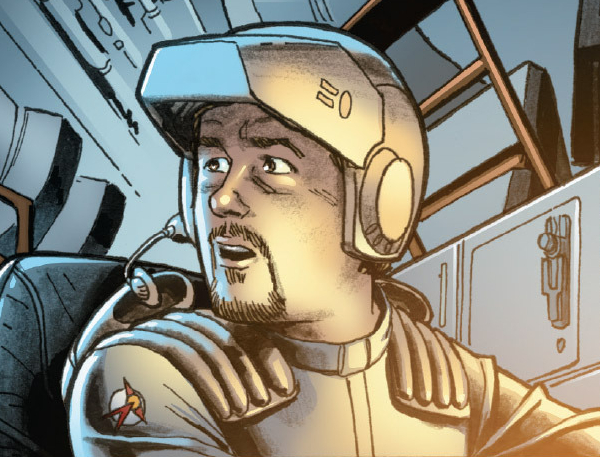
Days of Fear, Part 2 introduces Carth Onasi, a companion character from the original Knights of the Old Republic game, and the creative team put considerable effort into ensuring consistency with his game portrayal while also introducing unexpected elements. Reflecting on the issue, Miller noted that he unintentionally structured the dialogue similarly to the game, with Carrick—like the player character—receiving lengthy expositions from Onasi in response to brief observations and questions. Miller and Ching jointly envisioned Serroco's destruction in a manner closely resembling the final depiction, and in the production notes for the issue, Miller addressed fan inquiries regarding whether a bearded crew member on the Courageous from issue #8 was Onasi. Miller had intended for Onasi to be present at Vanquo on the Courageous, but he did not explicitly instruct Dustin Weaver to draw the character, and Miller initially believed that Weaver had drawn Onasi—only to later discover from Weaver that the crewmember was actually a representation of Miller himself. Zayne Carrick's reaction to the death of the Sterebs in Days of Fear, Part 3 was inspired by Miller's personal response to the events of September 11, 2001. Ching and Atiyeh created the cover artwork for Days of Fear, and the cover for Part 3 was directly suggested by Miller: he mentioned to Brian Ching his admiration for a Daredevil cover by Frank Miller featuring Daredevil cowering against a white background. Ching adapted one of Carrick's poses from the previous issue, adding Mandalore's mask and the flames. An earlier promotional image showed a redder mask, but it was ultimately changed to a brighter gold by the time of release. Issue #15 was delayed by two weeks from its originally scheduled release date of March 28, and was instead published on April 11.
In Knights of the Old Republic 16, Miller particularly appreciated Ching's ability to recreate the panel layout from issues #1 and #2—the depiction of Carrick's discovery of the Padawan Massacre. This sequence also allowed Miller to revisit Raana Tey and provide insight into her motivations, something he had wanted to do for some time. Nights of Anger, Part 1 featured the appearance of Arkania from Tales of the Jedi, and Brian Ching's designs for Camper and Jarael, which deviated from typical Arkanians, allowed Miller to address the theme of segregation. The broad strokes of Arkanian society were inspired by Miller's experiences with student protesters against companies doing business with apartheid-era South Africa, and he incorporated elements of 19th-century Russian communes. Colin Wilson created the cover art for Nights of Anger, and the inclusion of word balloons on the covers was editor Jeremy Barlow's idea: Barlow saw an opportunity to pay tribute to war comics covers by Joe Kubert given the year's military storylines. For the character Zadawi, Miller asked Brian Ching to design someone who would serve as a mirror to Jarael, showing what Jarael's life might have been like had she grown up on Arkania. The Tremendous battle group is another reference to the British Royal Navy, as the Tremendous was a ship of the same class as the Courageaux.
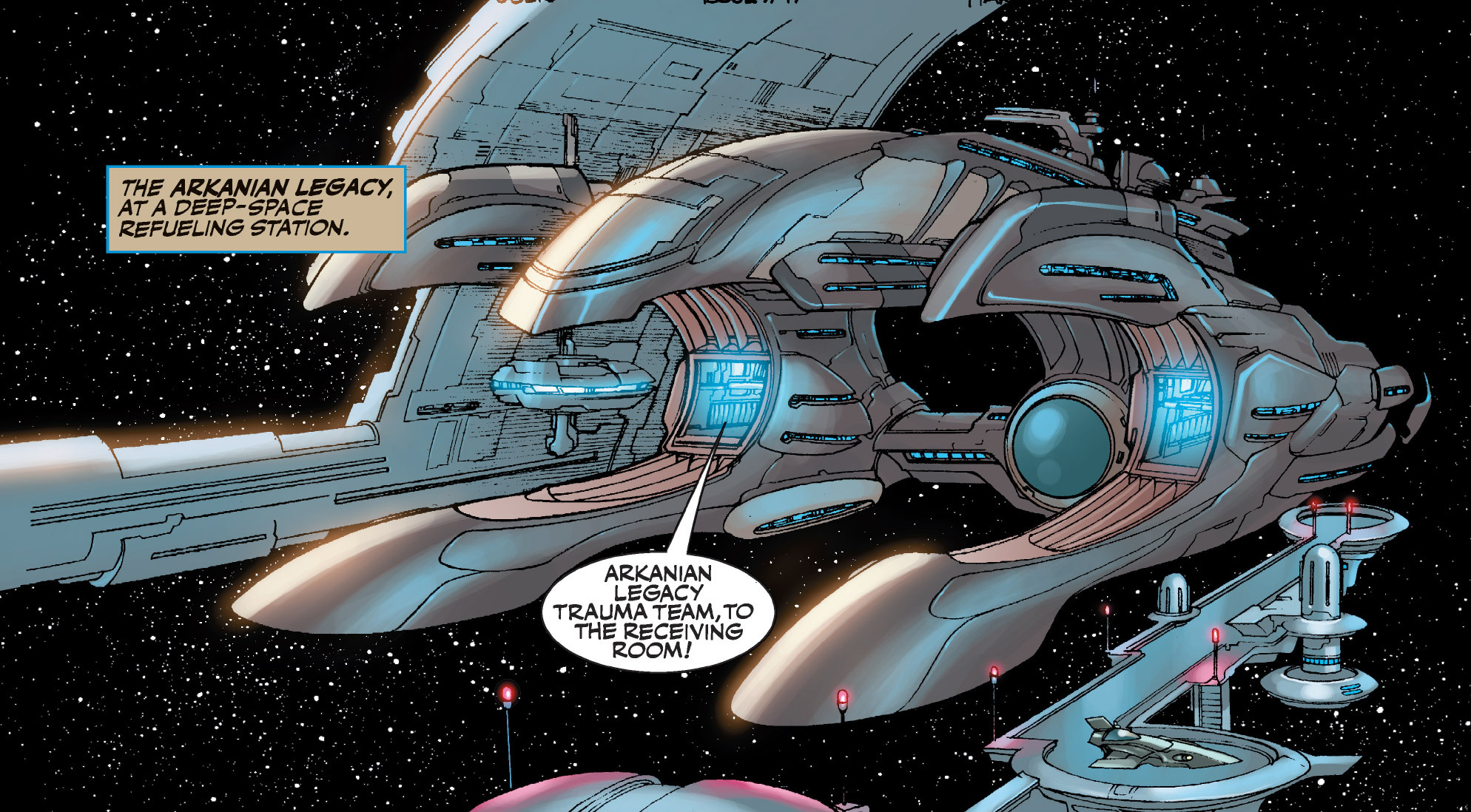
Beginning with Knights of the Old Republic 17, Miller initiated a storyline inspired by Archie Goodwin's work on the Marvel Star Wars comics involving the Wheel space station: a high-stakes political game set in a visually compelling location. Miller also used the issue to explore the corporate aspects of the Republic and its relationship with military and political issues, similar to Goodwin's depiction of the Galactic Empire and the House of Tagge, by connecting Lord Adasca and Adascorp to Camper's past. Miller also took the opportunity to shed light on Jarael's past, using the character Eejee Vamm to further explore themes of class and racial division that were introduced in issue #16. Harvey Tolibao drew issues #17 and #18, and Miller was pleased with how Harvey's art echoed Jim Starlin's work on the comic series Dreadstar, one of Miller's inspirations for writing Knights of the Old Republic. Miller initially wrote Vamm's first line as addressing an "Emergency Station," intending it to be a hospital receiving room aboard the Legacy, but Tolibao interpreted the dialogue as referring to an actual space station and drew the Legacy docked at a large station. Rather than change the artwork, the creative team opted to alter the dialogue: Vamm's comment was changed to "receiving room," and a dialogue box was added referring to the station as a refueling station.
Adasca's mention of "the Offshoot question" was intended by Miller to evoke real-world "questions" surrounding ethnic groups, and Carrick's escape through the back of his cell is a reference to the writer's favorite scene in the movie The Shawshank Redemption. In his production notes for the issue, Miller mentioned that he had not seen any accurate predictions regarding Camper's affliction, noting that the mechanic had not experienced a "spell" before The Last Resort launched in issue #4. The writer was also particularly satisfied with issue #17's backup, the Adascorp Fiscal Period Financial Report and Outlook: Message from the Chief Executive, as he was able to replicate the style of real-life quarterly reports and adapt it to the Star Wars galaxy. The Taris Holofeed edition accompanying issue #18 was inspired by Edward R. Murrow's "This is London" broadcasts from Britain during the blitz in World War II, and the reporter's sense of betrayal regarding the Republic was also inspired by the real-life resentment of the Allies when they failed to protect places in World War II. Issue #16 was also accompanied by a news source: The Admiral's List: Remember Serroco! Edition. Days of Fear and Nights of Anger were compiled in Star Wars: Knights of the Old Republic Volume 3: Days of Fear, Nights of Anger, which was released on January 16, 2008. The Knights of Suffering and Daze of Hate arcs were collected in Star Wars: Knights of the Old Republic Volume 4: Daze of Hate, Knights of Suffering, which was released on August 27, and Miller was pleased that the paperbacks were able to include the names of their component arcs in the titles.
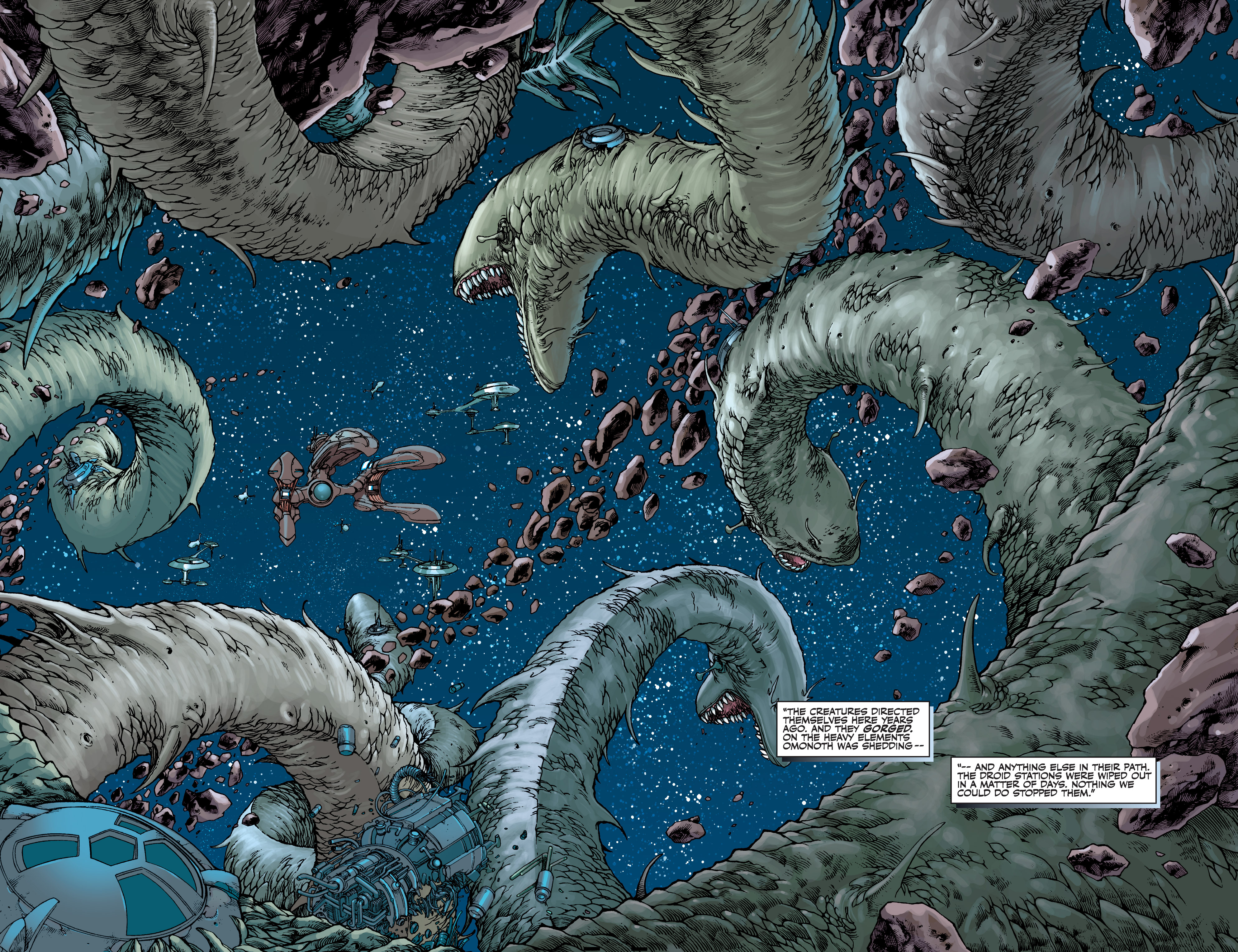
As early as his initial 2005 pitch for the series, Miller intended for the revelation of Camper's secret to be the central focus of the series' second year, outlining the basic design of Camper's creation as something biological, spaceborne, and massive—a departure from a typical superweapon. However, as he approached the Nights of Anger arc, Miller became hesitant to introduce anything radically new to the Star Wars universe, such as the living starship from Michael Golden's Star Wars (1977) 38. It wasn't until he rewatched The Empire Strikes Back that Miller considered the exogorths, finding that very little had been established about them in the Expanded Universe, and what had been written aligned with his plans. He remained hesitant when pitching the idea to Dark Horse, but his editors loved it, and the only challenge—how to depict them—was resolved by Brian Ching concurrently with his design of the Arkanian Legacy. Harvey Tolibao expanded on Ching's initial design to create the nest of stellar sea serpent-like creatures that appear in issue #18. The issue also focused on Adasca and Jarael, using Jarael's presence to further develop Adasca's personality and motivations. The tour of the Arkanian Legacy was also partially inspired by Goodwin's stories about the Wheel and Lando Calrissian's greeting Han Solo on Cloud City in The Empire Strikes Back—a complex game that required Miller to carefully manage the issue's script length.
Knights of the Old Republic 19 saw Miller unite the various characters he had been following over the past year. The writer consulted galactic maps to ensure all characters were logically positioned relative to Adasca's auction, and he developed timelines for nearly a dozen characters to track their locations and knowledge of each other's plans. Miller initially spelled the space slugs' name as "exorgoth," but it was corrected to "exogorth" during the lettering stage, and the change was implemented from that point onward. Miller originally intended for Adasca to make a derogatory remark about Camper's Human-like hands when ordering their removal, but this was ultimately cut due to space constraints. The Daze of Hate arc was drawn by Bong Dazo, an artist from Glass House Graphics, and the cover art was created by Chris Warner with two different colorists: Michael Atiyeh for issues #19 and #21, and Kelsey Shannon for issue #20.

During the initial development of the Arkanian Legacy sequence, Miller did not include Lucien Draay at all: Carrick's prison break would have unfolded differently, and Draay would have simply missed Carrick on Telerath after the Courageous was destroyed. However, he decided to include Draay when he realized the character had been absent for almost a year, conceiving the idea of them working together to escape, mirroring the chained convicts in the movie The Defiant Ones. This addition presented logistical challenges, but Miller ultimately integrated Draay's involvement, reminding readers of Carrick's status as a fugitive wanted by the Covenant. Miller chose to maintain the design of Mandalore the Ultimate's axeblade consistent with Mandalore the Indomitable's mythosaur axe from Tales of the Jedi, and he used the Daze of Hate arc to further depict the Mandalorians' transition from the chaotic, individualistic armors of Tales of the Jedi to the color-coded uniformity of the Neo-Crusaders featured in the Knights of the Old Republic video game. The food tray that splits an HK-24 droid's head during Carrick and Draay's escape was intended as a callback to the Bullseye comics by Frank Miller, where the protagonist utilized various mundane items as projectiles, although the panel evolved from Miller's initial concept of a simple debilitating strike to the eyes.
In Daze of Hate, Part 3, Miller aimed to consolidate the various character introductions into as few scenes as possible. While discussing how to allow Draay and Carrick to observe the events in the Observatory, the creative team decided that Eejee Vamm's "crow's nest" was a better setting than the towers on the Legacy's hull, given Vamm's death in issue #20. When working on Cassus Fett's speech, Miller drew inspiration from the American Southwest: while traveling in the region, a guide directed him to the presidio, or fortified base, in Las Vegas. At the presidio in 1846, General Kearny claimed New Mexico for the United States, and the starkness of Kearny's speech served as the model for Fett's tone. Each Daze of Hate issue was accompanied by a news source: Adascorp Fiscal Period Financial Report and Outlook: Field Report: Project Black Harvest—a reference to the "Blue Harvest" production codename for Star Wars: Episode VI Return of the Jedi—The Adjudicator Special Report: Tools of the Trade, and The Taris Holofeed Special Proclamation.
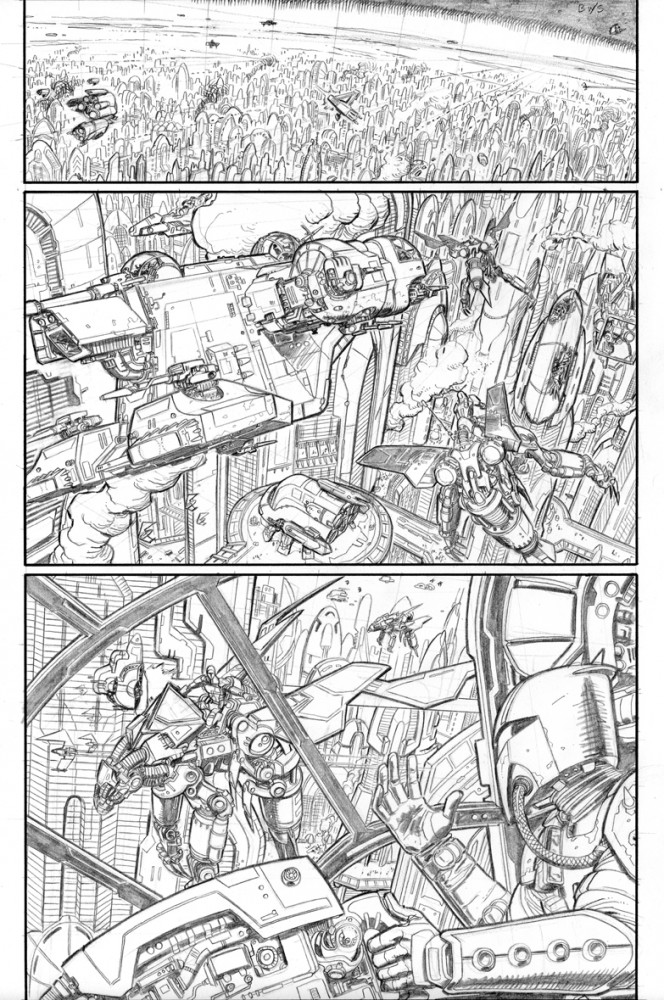
The Knights of Suffering arc, the basic plot of which had been discussed by Miller and Ching as early as March 2006, saw Miller revisit another major element planned from the series' inception: a return to Taris during its siege. Miller used the arc to address the few threads left on Taris in Commencement—Shel Jelavan, Senator Goravvus, and the disappearance of Constable Sowrs' children—and to introduce the Hidden Beks, a swoop gang from the video game. Miller incorporated several characters from the game, such as Gadon Thek, Brejik, and the Vao siblings, aiming to avoid mere cameos and instead bring in characters with significant roles. The four arcs of the Days/Knights cycle were initially planned to be alternated between artists, but various issues disrupted this plan early on; despite this, Dustin Weaver was able to draw Knights of Suffering concurrently with Bong Dazo drawing Daze of Hate, and Dan Parsons provided inks for Weaver's work on the arc. Weaver also included several background characters resembling characters from the Metabarons comic series, one of his favorites, and Carrick's fall from the Moomo Williwaw was inspired by the first issue of the comic series The Incal. Miller had planned from the start to bring back Hierogryph in Knights of Suffering and had also planned out how he and Slyssk escaped from Serroco, but found that the story did not fit well into the pacing of the current story and decided to save the segment for a later issue. The news source The Admiral's List: Karath Home Safely accompanied issue #22, showing the repercussions of Daze of Hate, and Colin Wilson's cover artwork for issue #23 was included in the letters section for issue #22 due to the fact that issue #23 was already completed by that time. Miller initially considered naming Constable Noana Sowrs' children after his own children, but as he began working on Vector and realized that Sowrs would be turned into a rakghoul, he discarded the notion.
Miller suggested the idea of a comic-sized handbook for the series in late 2006, believing there would be enough information for one by the time it was released. Miller found writing the handbook similar to writing the text page for a comic that he would typically send to an artist. The Star Wars: Knights of the Old Republic Handbook was released on November 7, 2007, the same day as Knights of Suffering, Part 1, and covered the events of the series up until that issue while also including a significant amount of new information such as backstory on the Moomo Brothers and Hierogryph. The Handbook's entries were crafted with the forthcoming Vector crossover in mind, and the Handbook included original character and ship designs by Brian Chin, while Miller also suggested including Dustin Weaver's "just for fun" cross-sections of The Last Resort and the Moomo Williwaw. A miscommunication resulted in some confusion over "The Onslaught": some entries in the Handbook refer to the Onslaught as involving Serroco, though that battle occurred several weeks later.
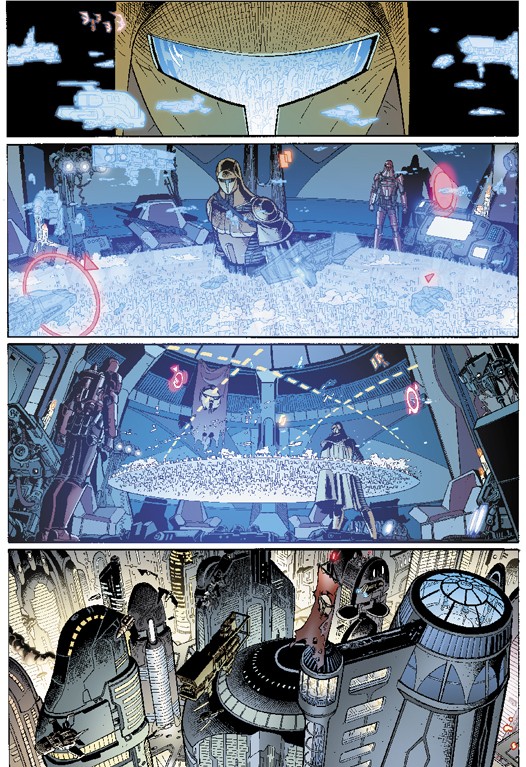
While working on Knights of Suffering, Part 2, Miller encountered pacing issues and was forced to cut certain plot elements, such as Carrick's encounter with Shel Jelavan—an element that was one of Miller's favorites in the issue. Carrick's interaction with Raana Tey was one of Miller's favorite panels in the entire series, although the writer was wary of the Resistance's mission to destroy the Jedi Tower: Miller felt that the destruction of a skyscraper was similar to the events of September 11, 2001, and Carrick's concern for the innocents in the neighborhood around the tower was something that Miller felt was an appropriate reaction to the situation. Miller used Karen Traviss's dictionary of Mando'a to name the Mandalorian ships mentioned by Cassus Fett, and he decided to make the Moomo Brothers more humorous characters by introducing their passion for explosives. The issue's news source, The Adjudicator Special Report: The Colonies, reflects the events of the issue in relation to Lhosan Industries and Hierogryph, and also includes additional charges for Carrick resulting from Admiral Karath's testimony.
Dustin Weaver particularly enjoyed drawing the duel sequence between Raana Tey and Carrick in Knights of the Old Republic 24, marking the first time Carrick has dueled another lightsaber-wielder in the series. Before Miller submitted the final version of the issue, he learned that his editor, Jeremy Barlow, was moving to Dark Horse's Indiana Jones office, and Barlow was succeeded by Randy Stradley, with whom Miller had worked in developing the original pitch for the series. Knights of Suffering, Part 3 was the final issue whose cover was drawn by Chris Wilson, ending the appearance of word balloons on the series' covers. The issue did not continue The Taris Holofeed, instead concluding with Galactic Republic Defense Ministry Daily Brief KD0092, which was intended to read like a real-world governmental "daily brief." Miller had been contemplating the Republic's inner workings in preparation for the Knights of the Old Republic Campaign Guide, and the page draws inspiration from various organizations in different governments. The Volume 4 paperback, which collects the Daze of Hate and Knights of Suffering arcs, divides the Arkanian Legacy events in half; during the arc's development, it was not originally planned that the Nights of Anger and Daze of Hate arcs would be so intricately related. Volume 4 also corrected a visual continuity error in #20, which had Rohlan Dyre given a gold set of Mandalorian armor, when the armor was in fact originally intended to be red, as it appears in Knights of Suffering.
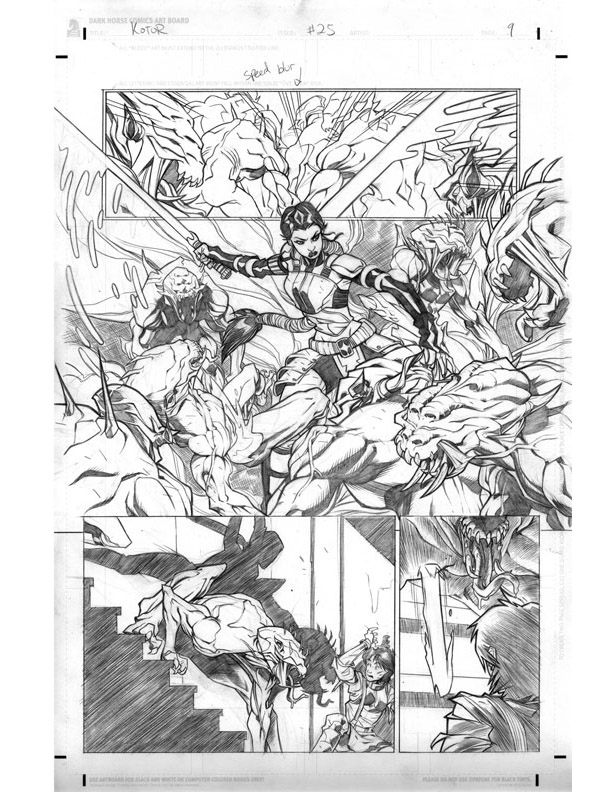
The inception of the Vector crossover can be traced back to 2006. Randy Stradley and Chris Warner were visiting a comic book store when the staff was in the process of unloading the latest deliveries of Marvel Comics' Civil War and DC Comics' 52 crossover events. Shortly after this experience, Stradley reached out to Miller, along with John Ostrander and Jan Duursema, the creative minds behind the Star Wars: Legacy comic book series. Inspired by the Civil War and 52 events, Stradley aimed to create a crossover that would seamlessly connect the four existing Star Wars comic book series: Knights of the Old Republic, Dark Times, Rebellion, and Legacy. Miller readily agreed, and the creative teams of the four series—Miller himself, Randy Stradley (under the pseudonym "Mick Harrison" for Dark Times), Rob Williams for Rebellion, and Ostrander and Duursema for Legacy—engaged in extensive discussions to determine how to bridge the chronological divides between their respective series. The writers quickly decided on a sequential crossover that would weave through each series, and Stradley was the person who initially proposed the name Vector for the event. Miller had already finalized the outlines for the Days/Knights story arc, knowing it would conclude with issue #24, and Vector was slated to begin in 2008 with issue #25. The inclusion of rakghouls was a concept that emerged early in the Vector discussions, with Jan Duursema being the first to suggest their potential involvement. The writers drew inspiration from the flashes of light that accompanied a transformation to introduce a supernatural element to the creatures connected to the Sith. Duursema also played a key role in the initial character designs for Celeste Morne and Karness Muur; however, her original design for Morne depicted her as an Arkanian named Aurora. Upon discovering this, Miller intended to link "Aurora" back to Days/Knights by establishing her as Arkoh Adasca's niece, who had been previously referred to as Aurora by Adasca. This idea was ultimately abandoned, as Vector was intended to welcome new readers to the Star Wars comics without requiring extensive prior knowledge. To address the fact that Aurora had already been mentioned, Miller chose to include information about her in the edition of The Admiral's List that appeared in issue #22.
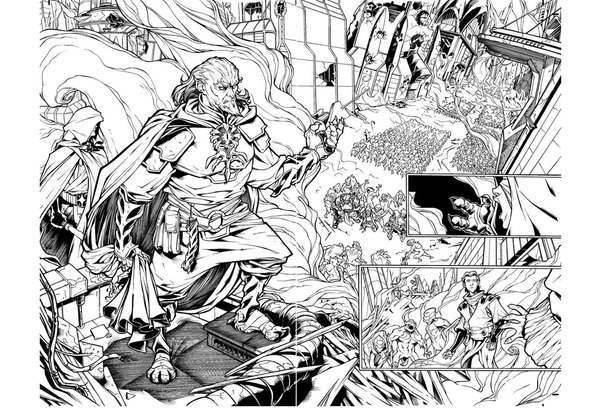
Because Vector was designed to be accessible to readers of all the involved series, Miller was compelled to scale back on the level of detail he had intended to include for several events from the Days/Knights cycle. Some of the events that were cut included the aftermath of the attack on Cassus Fett, the fate of the resistance movement, and the destinies of Jelavan, Thek, and Del Moomo. In each subsequent draft of the crossover, Miller opted to remove more and more characters from the KOTOR segment. Ultimately, the writers decided to only use Hierogryph, Carrick, and Lucien Draay. Miller's solution to this problem was to insert a gap between issues #24 and #25. During a summit in Portland, Oregon, in late summer 2007, the creative team decided to add several weeks between the conclusion of Knights of Suffering and the beginning of Vector. This allowed for the characters to be moved to their appropriate positions and also gave Miller the opportunity to address the status of characters who did not appear in Vector without including too much exposition. Randy Stradley had two primary "missions" for Vector: the event had to be easily accessible to both new and established readers, and it also had to alter the trajectory of each series it impacted. The second goal was easier for Miller to achieve, as he had always planned for 2008 to mark a shift in focus back to the issue of the Covenant. The four issues of Vector were illustrated by Scott Hepburn, with inking support from Joe Pimentel. Travis Charest created the cover for issue #25. Randy Stradley also joined the team as editor, starting with that issue. The in-continuity news outlets were discontinued in 2008 because it was difficult to maintain their correct placement when reprinting them.
Knights of the Old Republic 26 provided Miller with an opportunity to continue developing the evolution of the Mandalorian forces by depicting their operations on Jebble, a planet that had been initially mentioned in the edition of The Taris Holofeed that accompanied issue #0. The character of Celeste Morne mirrored Miller's early concepts for Jarael, whom he had originally intended to have a much more abrasive personality. The creative team also established a specific set of rules for how the rakghoul plague was transmitted. The character of Frazznik, who had first appeared in issue #3, was originally intended to reappear in one of the early Adjudicator columns, but he was cut due to space constraints. The arrival of transports from Taris was inspired by Great Britain's limited availability of landing ships during World War II. Dan Parsons contributed to the inking of issue #26 alongside Pimentel, and he subsequently took over inking duties for the remainder of the arc. Vector, Part 2 marked the beginning of a series of covers that were drawn and colored by Dustin Weaver, who was asked to make some revisions to the cover after its initial completion. In issue #27, Miller used Lucien's description of Xamar's research on the Talisman to explain why the First WatchCircle was stationed so far from the Core Worlds: they were searching for the Talisman. Randy Stradley coined the term "Mando-Raks," which was used instead of Miller's "Mando-Ghouls," and the two collaborated to create the name for Dreypa's Oubliette, drawing inspiration from the card game Magic: The Gathering.
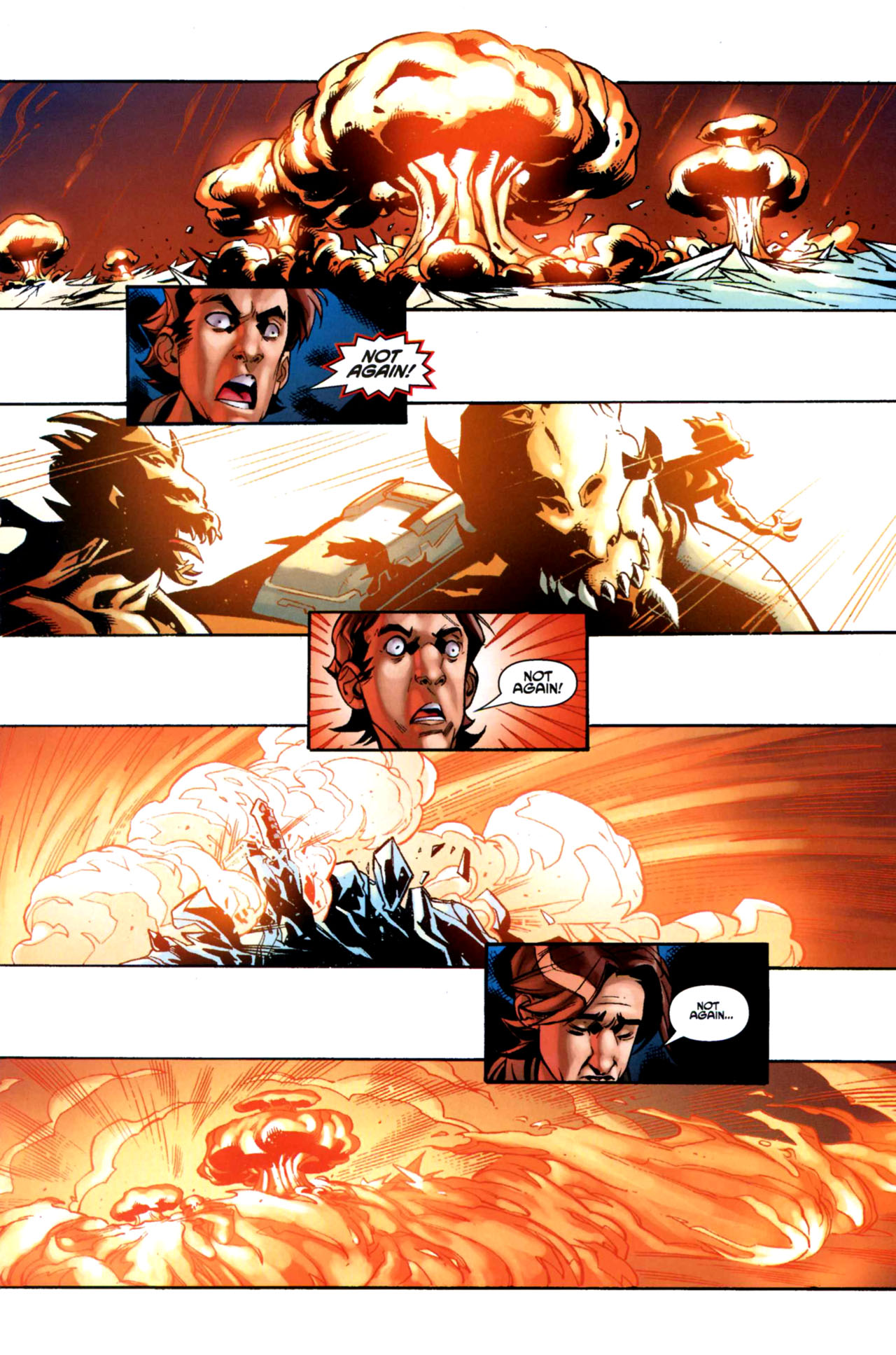
Issue #28, which concluded the Vector arc for the series, underwent minimal changes during the story's development. The writers had already determined the future paths of the characters in Knights of the Old Republic and how Celeste Morne would transition between series. Miller particularly enjoyed the opportunity to provide the rakghouls with a backstory and a reason for their existence. Bong Dazo, who would become the artist for the upcoming Exalted arc, designed Celeste Morne's pendant-key. Miller developed a diagram of suggested panels for the nuclear destruction scene, allowing events on Jebble's surface to progress vertically while Carrick's reaction moved diagonally. When Dark Horse Comics compiled the Vector storyline into a trade paperback, they initially faced uncertainty about how to do so without splitting up Vector. Dark Horse's solution was to combine the first six issues of Vector—Knights of the Old Republic #25-28 and Dark Times #11-12—into a single trade paperback, Star Wars: Vector Volume 1, Chapters 1 & 2. Vector Volume 1 was also labeled as Knights of the Old Republic Volume 5 and Dark Times Volume 3, continuing the trade paperback numbering of both series. The era icons for all four publishing eras involved in Vector were displayed on the spine.
Miller and the series' editors considered Exalted to be a crucial chapter in the series. A primary objective was to showcase the impact of Vector on the storyline to underscore the event's significance in other series. Miller developed the story for the two-part Exalted arc while also writing the adaptation for the movie Indiana Jones and the Kingdom of the Crystal Skull. However, Miller did not intentionally intend to echo the Indiana Jones franchise or create an environmentalist narrative, as some suggested based on the Covenant's experimentation with artifacts on Odryn. Miller created the planet, but he drew upon existing material for the Feeorin species. Dustin Weaver's cover for issue #29—which depicted Jarael disguised as Celeste Morne—allowed the creative team to hint that Morne might remain in the Old Republic era. By the time Miller started writing Star Wars, he had stopped introducing characters whose names were derived from real people. Miller's one instance of "tributing" others in a name in Knights of the Old Republic was the name Feln, which contains an easter egg referencing his sister's four children. By shifting two letters backward in the alphabet, "FELN" becomes DCJL, the initials of Miller's nephews and niece: Daniel, Christopher, Joey, and Laurie, some of whom assisted Miller in playing through the Knights of the Old Republic video games.

In issue #30, Miller expanded on the role of the Exalted to explain how Feln maintained his leadership position even after becoming a Jedi. This aligned with the established idea that Feeorins grew stronger with age. Miller envisioned the Feeorin village as being situated on an incline, allowing Carrick to leap the short distances to the rooftops. However, Bong Dazo perceived the village as being on a steeper incline, which allowed for the inclusion of elements that Miller had suggested, such as a dilapidated rooftop and carts pulled by the beasts of burden known as khadaroks. Bong Dazo also designed the bone knives used by the Feeorins. Dustin Weaver created the cover for issue #30, and Bong Dazo illustrated both issues of Exalted. Knights of the Old Republic 31, with art by guest artist Alan Robinson and a cover by Brian Ching and Michael Atiyeh, fulfilled Miller's desire to create a story in which everyone Carrick had helped would reciprocate and assist him in return. The time jump before Vector provided the necessary time to move the characters into positions where they could do just that. Turnabout was also the first issue in which Miller openly acknowledged that Alek and Darth Malak were the same character; the issue depicts Alek adopting the alias of Malak to evade an arrest warrant. The recording discussed by Vandar Tokare is the same recording that appears in Dark Times 11, which helped bridge the gap between Dark Times and Knights of the Old Republic. Malak's experience with Republic immigration is a direct reference to the character of Vito Andolini Corleone in the novel The Godfather, who was assigned the name of a Sicilian town as his surname during the immigration process. Issue #31 was the first issue after Randy Stradley's departure as editor, with Dave Marshall taking over the role. In his production notes for issue #32, Miller stated that the titular "Turnabout" in issue #31 was intended to represent Xamar's shift from aiding the Covenant to opposing them.
Knights of the Old Republic 32: Vindication, Part 1 was released on August 20, 2008, following the day earlier release of the Knights of the Old Republic Campaign Guide, a supplementary guide to the Wizards of the Coast Star Wars Roleplaying Game. The Campaign Guide, which covers and expands upon the two Knights of the Old Republic games and the comic series, was co-written by Rodney Thompson, Sterling Hershey, Abel G. Peña, and Miller. Miller initially conceived of the guide in early 2007, when he learned from his colleague James Mishler that Wizards of the Coast was relaunching the Star Wars Roleplaying Guide, although he was unsure how to pursue the idea. Later that spring, one of Miller's friends at Celebration IV suggested the same idea and pointed out the Roleplaying Game's head designer, Rodney Thompson. Miller became distracted before he could speak with him, but a LucasFilm representative introduced Miller to Thompson after Miller's panel: Thompson wanted Miller to help create an already-scheduled campaign guide for the Knights of the Old Republic series. Miller was initially only responsible for continuity oversight, but because Miller had some experience with roleplaying games, Thompson asked Miller to write some of the sections. Miller's wife, Meredith, helped him develop much of the stats and information needed for the game, and Miller ended up writing the guide's chapters on Mandalorians and the Republic. He used the guide as an opportunity to advance some of the stories that he had not yet had the chance to do so in the comics, such as Haydel Goravvus. However, when it came to the subject of Squint and Malak—whom the comics' creative team had always intended to eventually connect—Miller suggested that they avoid Malak's previous identity and early years.

This led to a later issue: Alek's "surname" of Squinquargesimus, which was assigned by Republic immigration but not used by Alek, appeared in the Campaign Guide even though Miller had not yet explained in the comics that it was not actually the character's last name. Another mistake occurred when a last-minute addition to the guide included a section on the planet Bespin, the discovery of which Miller intended to use in Knights of the Old Republic 36. Miller was unaware of the addition while working on issue #36, but he discovered the segment on Bespin shortly before issue #36 was completed. As a result, the "Bespin" that appeared in issue #36 was recolored and given a different diameter to distinguish it from Bespin. For Xamar, who is a member of the Khil species, Miller decided early in the series to reflect the Khil's sibilant speech patterns by tripling Xamar's "s" sounds. However, as Xamar had more and more lines, Miller eventually reduced the number of times he did so, as he felt that the verbal tic was becoming distracting. He reworked Xamar's dialogue to include fewer occurrences of the letter s. The Vanjervalis Chain was explained in the Knights of the Old Republic Campaign Guide and the Handbook, but because the creative team wanted to ensure that key story elements were not introduced outside of the comics, they chose to show the Vanjervalis Chain in action in issue #31 so that it would appear in the comics before the Campaign Guide. Brian Ching returned for Vindication, meaning that the creative team was largely the same as the one from Commencement. For the ending of issue #32, the creative team initially considered ending on the cliffhanger of Carrick's ruse being exposed, but they decided to end with the issuing of Vindication instead.
Vindication, Part 2 was illustrated by Bong Dazo and inked by Joe Pimentel, while Brian Ching and Michael Atiyeh created the covers for the first three issues of Vindication. Miller had already developed Haazen's backstory as early as 2006 when he submitted the script for Homecoming, as well as histories for Barrison and Krynda Draay, although Barrison's name was not finalized until issue #12. Miller kept the story in reserve because he was unsure when they would reveal the story beyond around the time of Vindication, and he also did not know whether it would be actually depicted in a flashback or just covered in dialogue and short flashbacks. Following the development of Exalted, the creative team realized that Vindication was only going to be a three-issue arc, so they decided to repeat the Flashpoint/Homecoming method of having a second artist draw a fourth standalone issue, the story of which they would plan in advance. The team's next challenge was determining how much of the setting from Tales of the Jedi to include, and Miller preferred to maintain a balance between the settings of the two series. When looking at settings from the Tales of the Jedi era, they also decided to differentiate the two time periods by highlighting the more formal mindset in Tales of the Jedi and the importance of tradition and old money. The crystal oubliette that Krynda Draay was imprisoned in was originally just a medical stasis casket, but when Dreypa's Oubliette was developed for Vector, the creative team decided to make it a prototype oubliette instead.
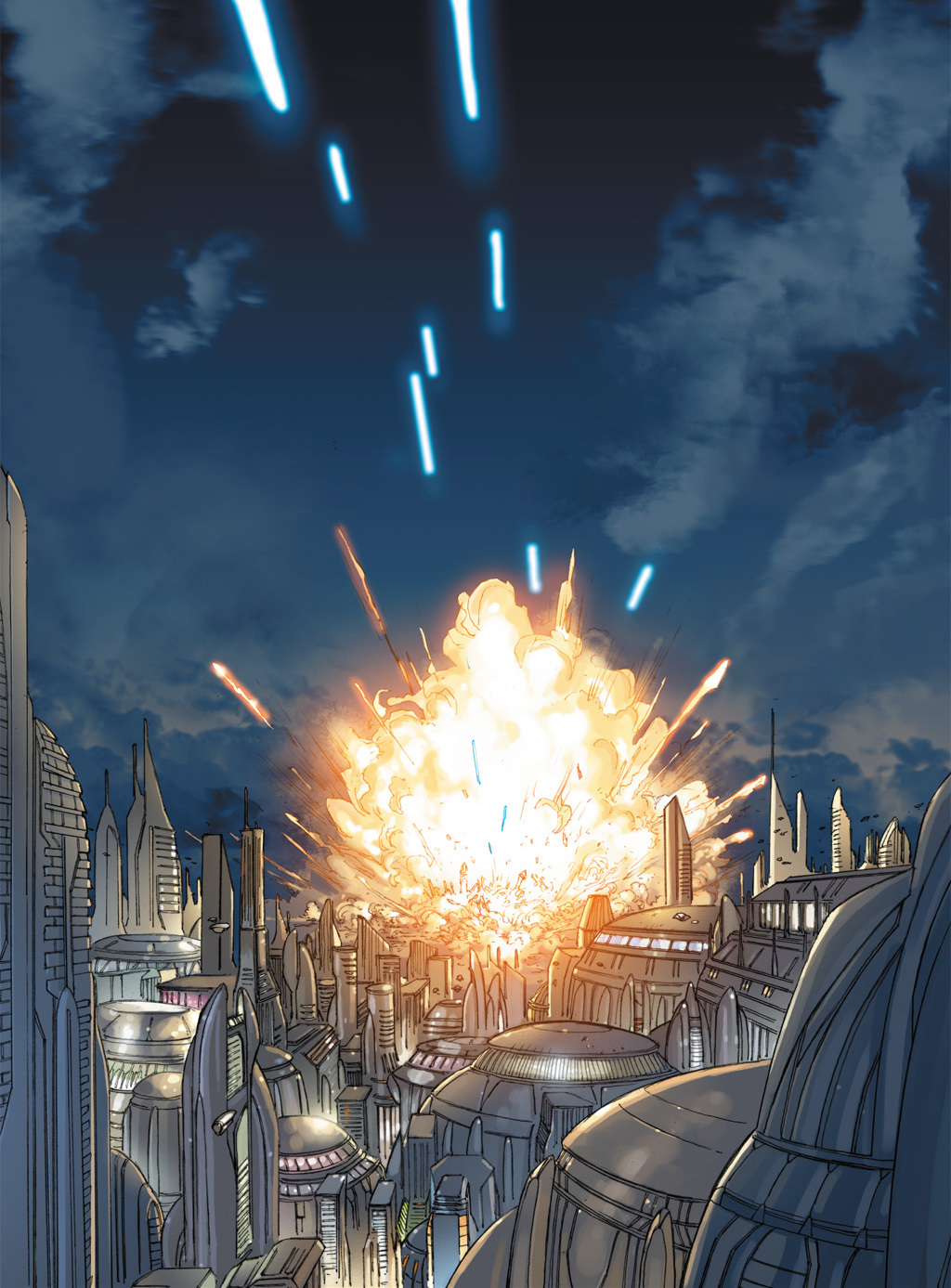
From its very beginning, the Covenant meta-arc was designed with a flexible timeframe, allowing for various other storylines to be inserted between the arc's major plot points. Miller's personal preference for slowly developing certain subplots and having sudden and quick resolutions for them also influenced the planning. He always intended for the major milestones of the Covenant storyline to be unevenly spaced throughout the series, and Vector served as the "big break" that initiated the rapid conclusion of the Covenant storyline. Vector also introduced a brief pause in the advance of the Mandalorians, allowing the creative team to revisit the issue of the Covenant. While planning the resolution to Vindication, the creative team never considered the possibility of Lucien Draay becoming a fugitive like Carrick had been, as it felt inconsistent with Draay's personality. Miller considered depicting the Council meeting in which Carrick declined the Order's offer to rejoin them, but he ultimately decided against it. Brian Ching dedicated significant effort to the scene depicting the destruction of the Draay Estate, and a sound effect was omitted as the team felt it would be distracting. Carrick's line about the Force while in the vat originated from his wife, who used a similar line when she read the scripts for the series, and Miller saved the line for an appropriate moment to use it. Artist Dan Scott created the cover art for Vindication, Part 4. Exalted, Turnabout, and Vindication were later collected in Star Wars: Knights of the Old Republic Volume 6: Vindication on April 29, 2009. The size of the trade paperback was increased from six to seven issues to include the flashback issue #32, and the trade paperback was labeled Volume 6 because Vector Volume 1 already included Volume 5 for the series.
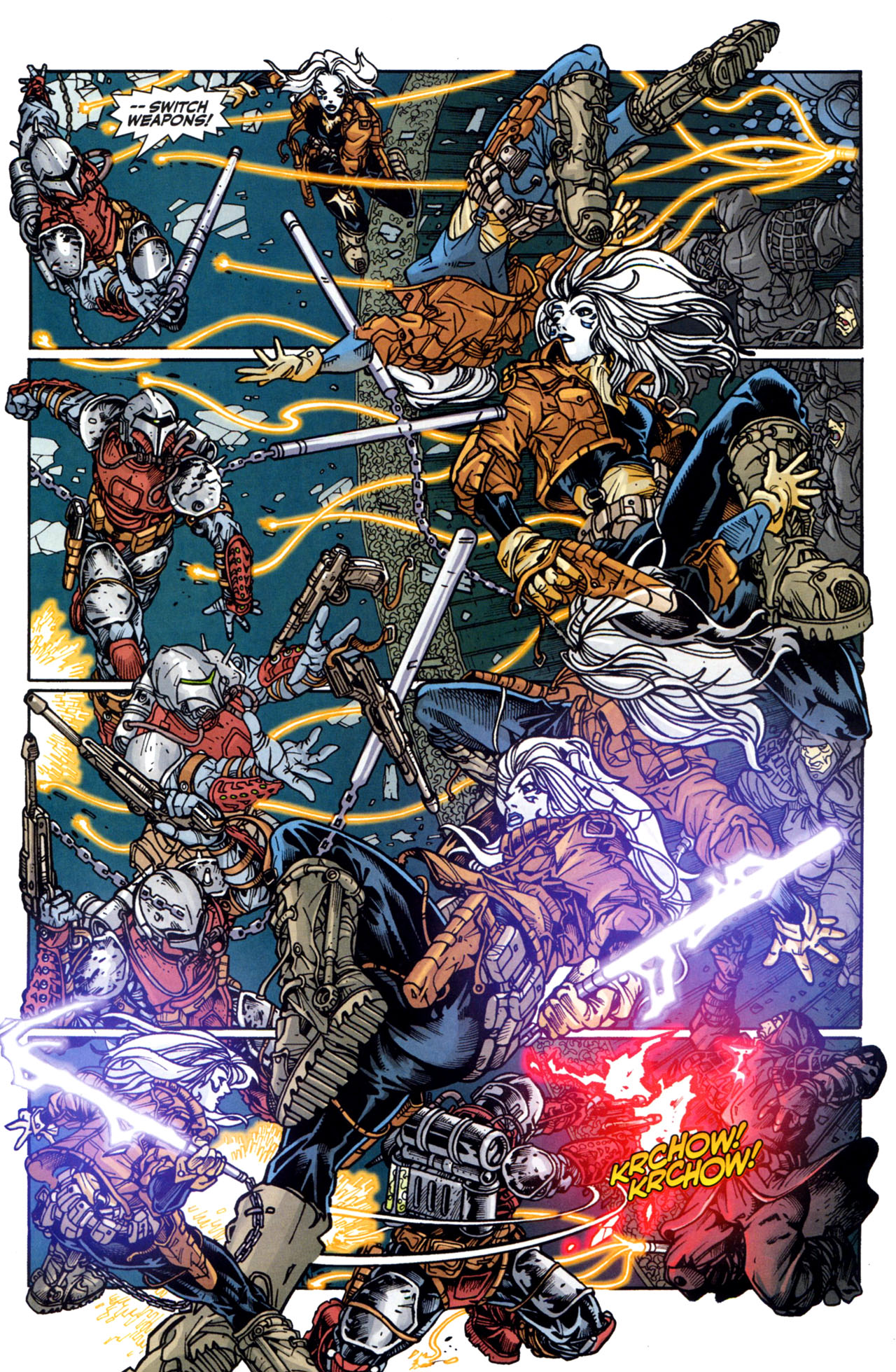
Following Vindication, the creative team aimed to immediately steer the series in a new direction, opting not to dwell on Coruscant dealing with the aftermath of the arc. They utilized the time-jump that had been used before Vector to reunite the main characters in a new adventure. During the early stages of developing the arcs following Vindication, Miller spent time contemplating the subject of slavery in Star Wars. While driving Maggie Thompson—a longtime magazine editor and a key founder of comics fandom—to a convention, the topic of living slaves in a universe with artificial beings arose. When asked why slaves would be necessary, Thompson responded with "Entertainment value." Miller's reflections on the subject eventually evolved into the Dueling Ambitions arc. The planetary auction in issue #36 was inspired by Miller's desire to introduce readers to new locations in the Star Wars universe, as well as his experiences with financial markets. Issue #36 marked the first time that Miller introduced an omniscient narrator to the series, believing that introducing such a narrator in the limited role of a tour guide would be beneficial. The scene in which Dyre and Demagol switch weapons mid-combat was Miller's idea. He envisioned a midair exchange of weapons with acrobatics, and the issue's artist, Bong Dazo, developed a page that depicted the exchange through multiple panels and multiple appearances of both characters in a kind of slow-motion animation. Nunk Plaarvin's line, "Fortunately, I am Nunk. I have the wisdom and the knowledge of the ages," was inspired by Miller's professor in his first newswriting class in college.

Bong Dazo designed the Hot Prospect, although it was Miller's idea to make the exterior of the ship as chaotic as its interior. Miller designed the command deck, which is positioned as a crow's nest above the ship. When Miller began sketching, his son helped model the bridge with LEGO bricks, and the resulting design was a fusion of a command bridge, mess hall, meeting room, and crow's nest. Miller was unable to draw or describe the concept effectively, so he simply sent images of the LEGO model to Dazo. The Hot Prospect was primarily born from Miller's dissatisfaction with the Deadweight, which he felt was too streamlined for a vehicle that was supposed to be ungainly. Like the Deadweight, the Hot Prospect was directly inspired by the real-world LSTs that served in World War II, and its class designation, a Calispan 560, is another reference to the USS LST-560. The departure lounge was designed to have both a suspended flooring and a suspended ceiling, while the observatory presented a more difficult design challenge: the interior of the dome needed to be visible from the exterior, but there also needed to be a beam across it so that Jarael and Dyre could be suspended from it. The final design featured a circular object suspended by three bars, and the creative team imagined that the observatory's original equipment had hung from those bars before it was removed. Dan Scott continued as the cover artist for both issues of the Prophet Motive arc.
Knights of the Old Republic 38 was a story that Miller had been planning for several years. The "Corellian Strangler" had first appeared in several of the backup news organs during 2007, and the frequent mentions of the Strangler as possibly being of various species led to a "haunted ship" concept set aboard a vessel like the real-world Titanic. Michael Golden's art for the living spaceship in Star Wars 38 also played a role in inspiring the story. Although Miller did not intentionally plan it, similar to how Star Wars 38 immediately preceded the Marvel series' adaptation of The Empire Strikes Back, issue #38 of Knights of the Old Republic also served as a stand-alone story preceding the main story of 2009. The story also allowed Miller to revisit the character of Elbee, as well as the subject of droids not understanding the motivations of their masters. Originally, the creative team planned for there to be no gravity on the Fillorean at the beginning and then for there to be a humorous scene where everyone and everything aboard the ship crashed to the floor when gravity was restored. The idea was ultimately discarded because it felt out of place with the seriousness of the issue. Guest artist Dean Zachary illustrated issue #38, while the cover was the last to be drawn by Brian Ching. The character of Toki Tollivar went through a number of species changes, as Miller wanted a diminutive species that was not an Ewok, before the writer ultimately settled on a Bimm.
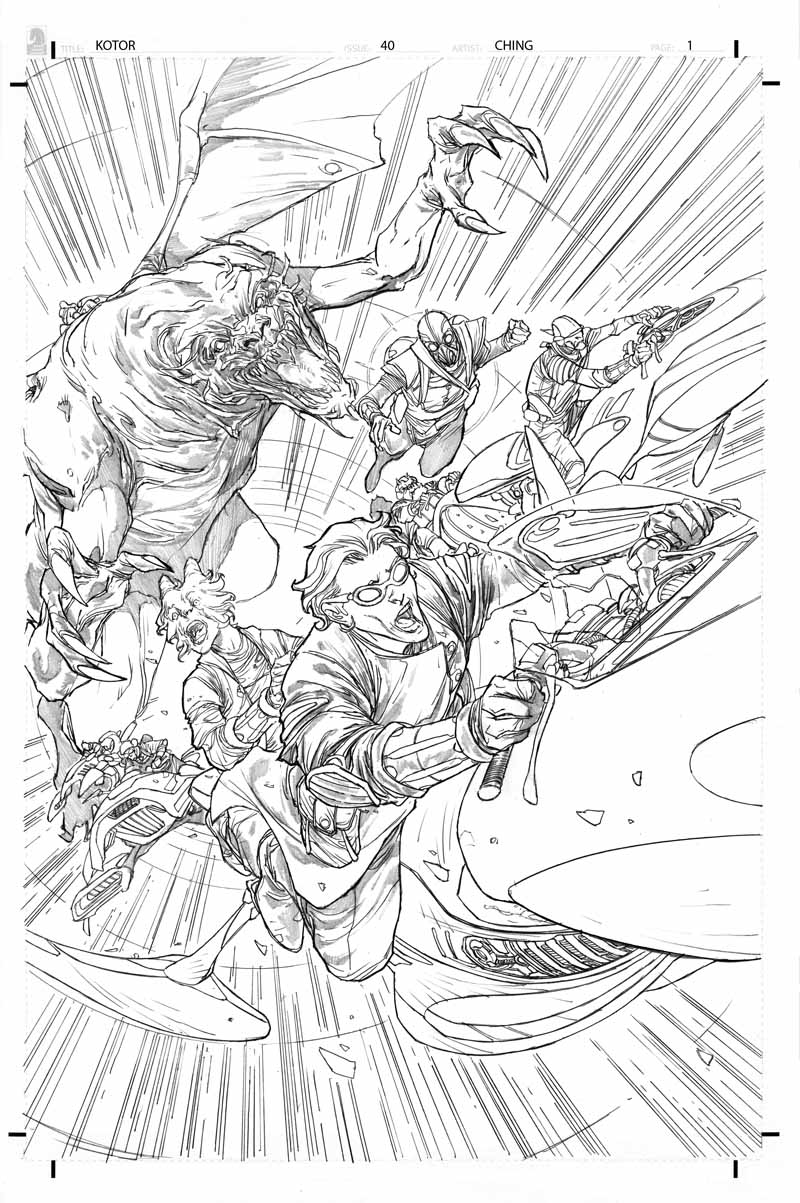
Dueling Ambitions afforded the creative team an opportunity to clear up some confusion regarding the topic of dueling. This confusion arose from the initial video game, Knights of the Old Republic, which asserted that death matches were banned during the Sith's reign on Taris, yet also claimed they were outlawed long before that. The Campaign Guide offered a partial clarification, explaining that the Sith reimposed the Republic's ban, which had been lifted following the Mandalorian invasion years prior. This was done to prevent dueling legends from gaining popularity and diverting attention from the Sith's control over the planet. Consequently, Dueling Ambitions provided a platform for the creative team to address the original Republic ban. The concept behind Jervo's World was to distinguish it from similar Star Wars stations like the Wheel. The team envisioned the station as a sports fan's paradise, akin to Cowboys Stadium in Arlington, Texas in our world. The playing fields were conceived as interconnected arenas linked by tubes. This design replaced Miller's initial idea of an icosahedral structure, which was deemed too challenging to render consistently. The structure of the swoopdueling competition was partly inspired by the bracket system used in the 2009 NCAA men's basketball tournament, which commenced the day after issue #39's release on March 18.
Miller utilized the character of Goethar Kleej to remind readers of Carrick's integration into Taris society, where he developed an interest in local sports and athletes despite being an outsider. Issue #39 specifically highlighted Carrick's typical teenage nature. Goethar Kleej underwent several revisions during the planning of Dueling Ambitions. It was only after Miller learned about Gotals' sensory perception through their cones that the subplot involving Aubin Kleej materialized. Brian Ching resumed his role as the series' artist with issue #39, which also marked the first cover art contribution from Daryl Mandryk. Mandryk also created the cover for issue #40, while Brian Ching continued his artistic work for the remainder of the arc. His involvement aided the team in recreating the Jedi Tower scene from issue #6, where Jarael rescues Carrick. For the sound effect of Jarael crashing through the glass ceiling, Michael Heisler reused the exact sound effect from issue #6. The panel featuring Jarael's reflection in Dyre's facemask is a recreation of a similar panel in issue #10. Hierogryph's line about a "tub of goo" was inspired by David Letterman, the host of the Late Night with David Letterman talk show. In 1985, Letterman repeatedly referred to baseball player Terry Foster as a "fat tub of goo" over several days.
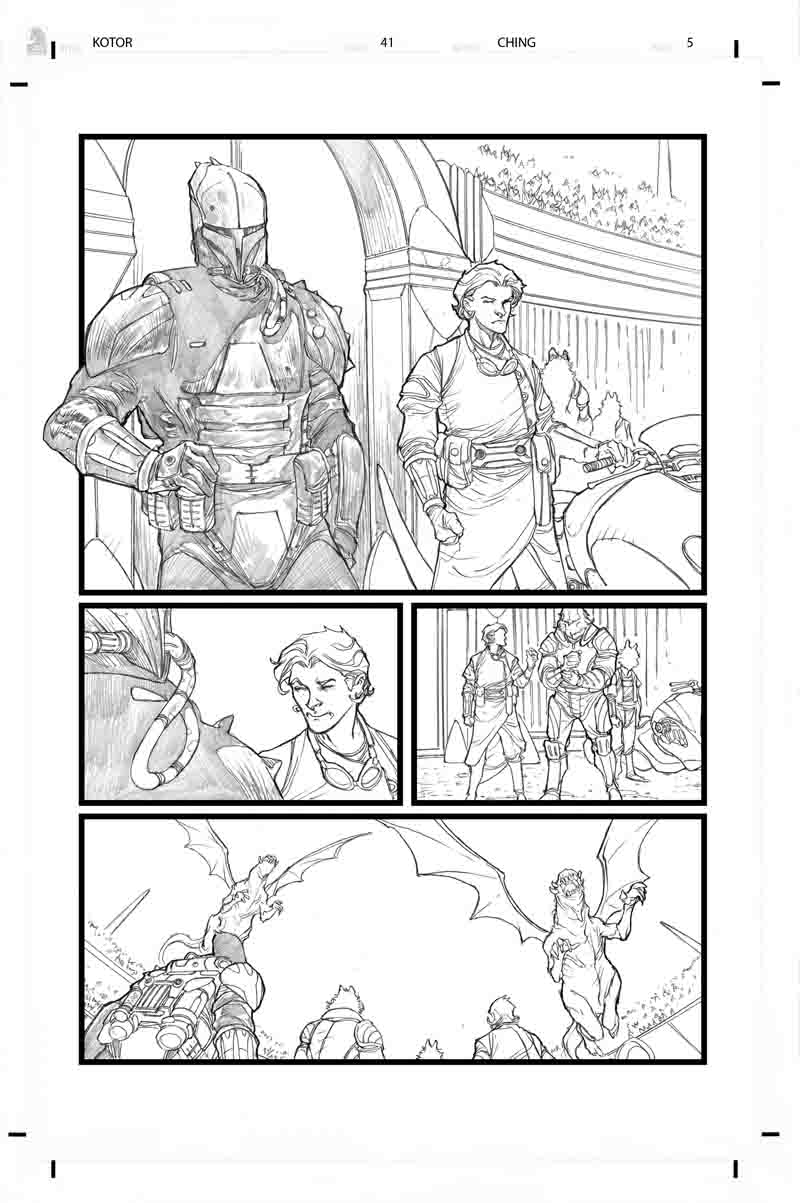
With Knights of the Old Republic 41, Miller finally got to realize a long-held ambition: disrupting a happy ending. The revelation of Jarael's past as a slaver had been in development for most of the series and had been subtly hinted at in various issues. The creative team initially considered revealing her past at the conclusion of Vindication but ultimately decided to postpone it to incorporate other elements. This delay also allowed the team to contrast the operations of Carrick's group with and without the Covenant's pursuit. The team emphasized establishing Jarael's accuser as a sympathetic and believable character, although Miller's initial plans portrayed the accuser as a less formidable, more victim-like figure. The revelations about Chantique and Jarael's past were closely guarded secrets at Dark Horse. Solicitations for subsequent issues intentionally omitted any mention of these elements to preserve the surprise. Issue #41 also served as a partial homage to Archie Goodwin, as the first non-movie adaptation issue of the Marvel series that Miller purchased as a child was Star Wars (1977) 23, the concluding issue of the Wheel arc. The Mandallian Giant on the cover, illustrated by Dan Scott, was one of the more overt references, as a Mandellian Giant was among the alien gladiators on the Wheel. Prophet Motive and Dueling Ambitions were combined into the series' seventh trade paperback, Star Wars: Knights of the Old Republic Volume 7: Dueling Ambitions, which was released on October 21, 2009.
Knights of the Old Republic 42, featuring art by guest artist Ron Chan and a cover by Benjamin Carré, allowed the creative team to portray a crucial moment in the Mandalorian Wars and Revan's history. From the series' inception, the team knew that "Malak" and "Revan" were not the characters' birth names. Issue #31 addressed Malak's transition to that name. Miller felt it was important to demonstrate that the two Sith had adopted names different from their originals when they became Darth Malak and Darth Revan. As the creative team looked ahead after completing Commencement, they decided to use the Revanchists as a counterforce to the Covenant, beyond the Jedi Council's neutrality. These crusaders were also attempting to push the Council into action, but in the opposite direction. Consequently, Revan and Malak appeared in issue #0, and their storylines entered what Miller described as a helix, intersecting with Carrick's story at significant points. The creative team intended for readers familiar with the video games to recognize or learn that Revan and Malak were the Revanchist and Alek. Miller had always planned for the massacre of the Cathar species to be the defining moment that firmly linked Revan and the Revanchist. The video game character Juhani describes the massacre as occurring many years in the past, raising questions about its present-day impact. Miller devised a solution to depict the massacre in a vision of the past relatively early on and chose to wait until the Revanchists were officially working with the Republic to use it. Miller initially suggested ending the issue with Malak standing on the ground, watching Carrick and Jarael depart, but Ron Chan proposed the alternative idea of showing Malak looking down at the Hot Prospect as his ship departed. Issue #42 also marks the first appearance of Captain Telettoh, a character who is a direct reference to Pete Hottelet, the winner of the Penny Arcade Child's Play Charity Auction. Hottelet won the opportunity to appear in a Star Wars comic book, and Telettoh's appearance is based on Hottelet's likeness.

For The Reaping arc, the dust-divers drew inspiration from Miller's high school interest in space exploration, the real-world Halley's Comet, and the film Deep Impact. He utilized the scenario to illustrate a situation where living slaves were considered superior to droids. The arc, initially titled "Cold Harvest" before Miller realized that Dark Times was running a Blue Harvest arc, was illustrated by Bong Dazo and featured covers by Benjamin Carré on both issue #43 and issue #44. Miller initially intended for the deep-space combat sequence in issue #44 to appear in Dueling Ambitions, but it was moved to The Reaping. The Hot Propsect was specifically created for this scene, allowing the creative team to utilize the ship's diverse array of unconventional weapons. The Prospect's centrifuge was inspired by Miller's high school science-fair project on rotational and angular momentum, which was in turn inspired by the films 2001: A Space Odyssey and 2010. The winch attack was inspired by the LST on which Miller's grandfather served. Miler envisioned Dace Golliard as a disheveled and broken figure who had ruined his career but refused to give up, while Bong Dazo created the sky-reaper droids. Several notes to the colorist, Michael Atiyeh, inadvertently appeared on the printed pages of issue #44, and Chantique's tattoos were missing from some panels.
For the Destroyer arc, which marked Brian Ching's return as artist, Miller initially considered a longer story arc depicting the Crucible's capture of Carrick's starfighter and his initial experiences in their custody. However, they quickly decided to cut straight to the action, as Dace Golliard would inform Chantique of what had transpired. The arc was initially planned as three issues, with additional scenes involving the muscle Hierogryph hires to free the Crucible—Valius Ying's former gang—slaves and Jarael's conversations with Malak and Shel Jelavan. Knights of the Old Republic 45 culminated the multiple scenes with agents of the Crucible from previous issues. Chantique and Bar'injar's investigations into Jarael's actions, which had been depicted in earlier issues, led to their recognition of Carrick. Miller chose to make Snout a Caamasi after learning about their memnii, or collective memories.
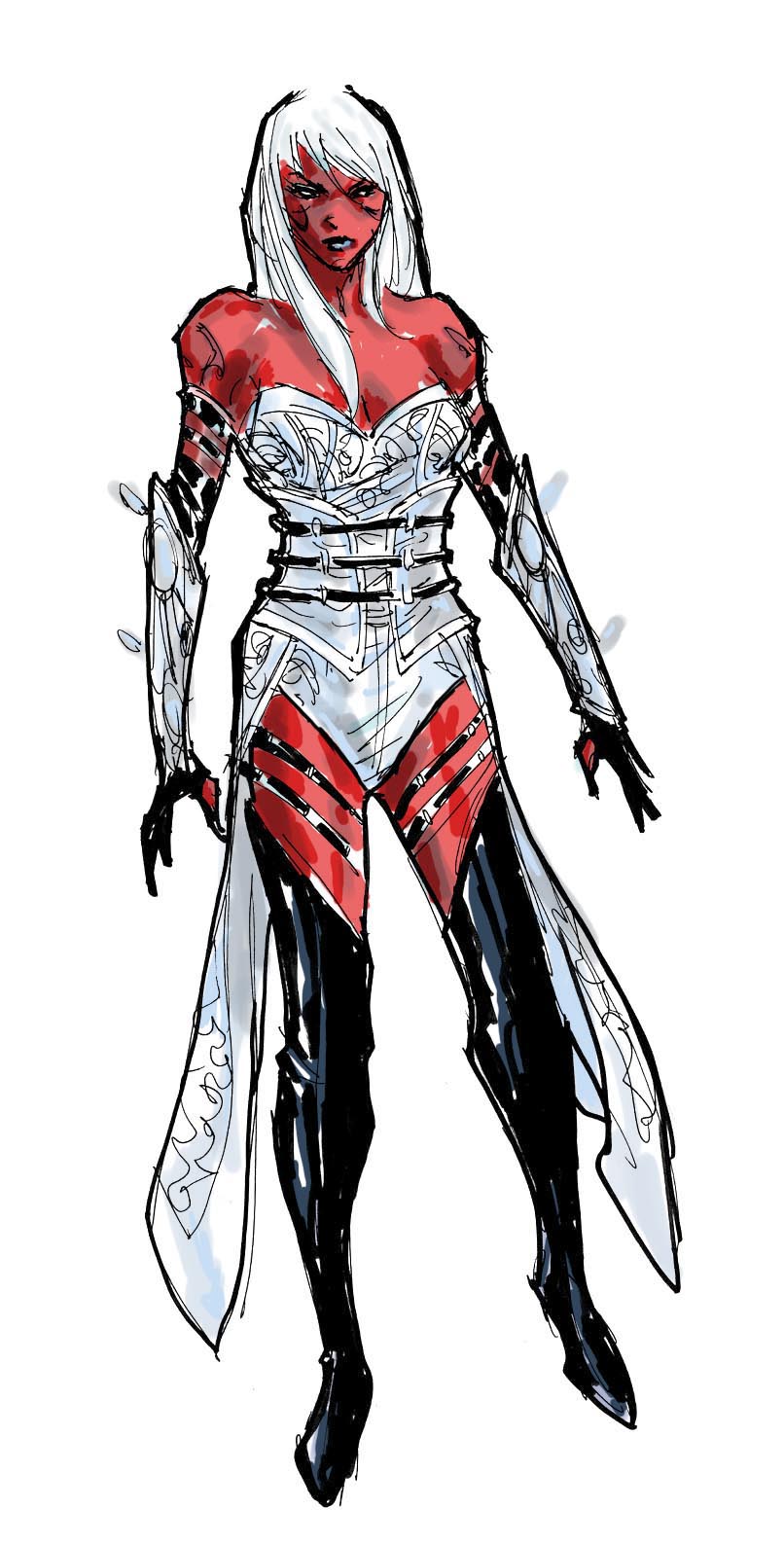
Knights of the Old Republic 46, featuring a cover by Jim Pavelec, was released on October 21. However, at the Baltimore Comic-Con, Dark Horse announced that Knights of the Old Republic would conclude with its 50th issue. By that time, Miller had already submitted the final script, and the creative team had been working to resolve all the loose ends in the series over the remaining arcs. Miller would transition to a new ongoing series, Star Wars: Knight Errant, set during the New Sith Wars. The decision to end the series did not result in significant changes. Miller had already planned for Jarael's storyline to conclude around the same time, and both the Destroyer and Demon arcs were always intended to conclude the Crucible storyline. By reducing Destroyer to two issues, the creative team was able to make Demon a four-part arc. In issue #46, Jarael's age was revealed, which had been planned for some time and highlighted how little Carrick knew about Jarael. In his production notes for the issue, Miller revealed that the name of Bar'injar, the Magister Protector, was intended as a subtle clue to the true meaning of Jarael's name, as it shared the syllable "jar" and the same meaning. Masks, The Reaping, and Destroyer were collected in the trade paperback Star Wars: Knights of the Old Republic Volume 8: Destroyer, which was released on January 13, 2010.
Knights of the Old Republic 47 focuses on three major revelations, all of which had been planned for a considerable time to follow up on various clues in previous issues. The issue, like the rest of the arc, featured a cover by Benjamin Carré and revealed that Rohlan Dyre had been replaced by Demagol. This topic had generated significant discussion among fans, and Miller was relieved to finally reveal it. Issue #47 also allowed Miller to reveal the "Goodvalor affair," a story he had been saving since Knights of Suffering. Miller's initial idea was to depict the meeting with the Defense Ministry early in Daze of Hate, but around that time, Miller left his day job to become a freelancer. During this period, he developed several concepts, including the Handbook. Hierogryph and Slyssk's escape was envisioned as a potentially humorous one-shot, but Miller took on other work and had to shelve the idea. While the story was delayed throughout the series, the creative team made several references to it, and in the short story Interference, Miller included material originally created for the in-universe text pages that never made it into Vector. Miller initially considered Valediction as the title for Demon, in keeping with Commencement, but ultimately chose the title Demon. The scene where "Demagol" is escorted to his trial was intended to mirror the mob scene in issue #6, which was also drawn by Brian Ching. In the initial script for the scene on Wor Tandell, "Rohlan" emerged from the tall weeds near Jarael, stating that he had "concluded his business," but after realizing the unintentional humor of the statement, the script was revised.
In the summer of 2005, while Miller was completing the pitch for Flashpoint, he planned for Rohlan Dyre to sneak aboard The Last Resort and then join the cast in Days of Fear, with Demagol beginning his pursuit of Jarael in custody. Reflecting on the story after noting the stowaway, Miller added the line: "He might be Rohlan; he might be Demagol. Heh, heh, heh…," and the ruse took off from there as it fit well into the story. Knights of the Old Republic 48 was accompanied by an essay in the letter column written by Miller, discussing how they handled the masquerade. In the column, he explained how the scripts for the series included parenthetical art instructions on how to pose the character as a disguised Demagol. While the real Dyre was a brawler, Demagol had a more precise and elegant posture, similar to a martial artist. As Demagol was unsure whether the real Dyre had ever removed his helmet, the character had to remain masked at all times, and the creative team made an effort to present Demagol's dialogue and actions to hint at ulterior motives. Demagol's dialogue was tailored to include intentional slip-ups where Demagol would revert to his meticulous and intellectual manner of speaking, and the creative team even went back into the Flashpoint trade paperback to remove some of the contractions that "Dyre" used.
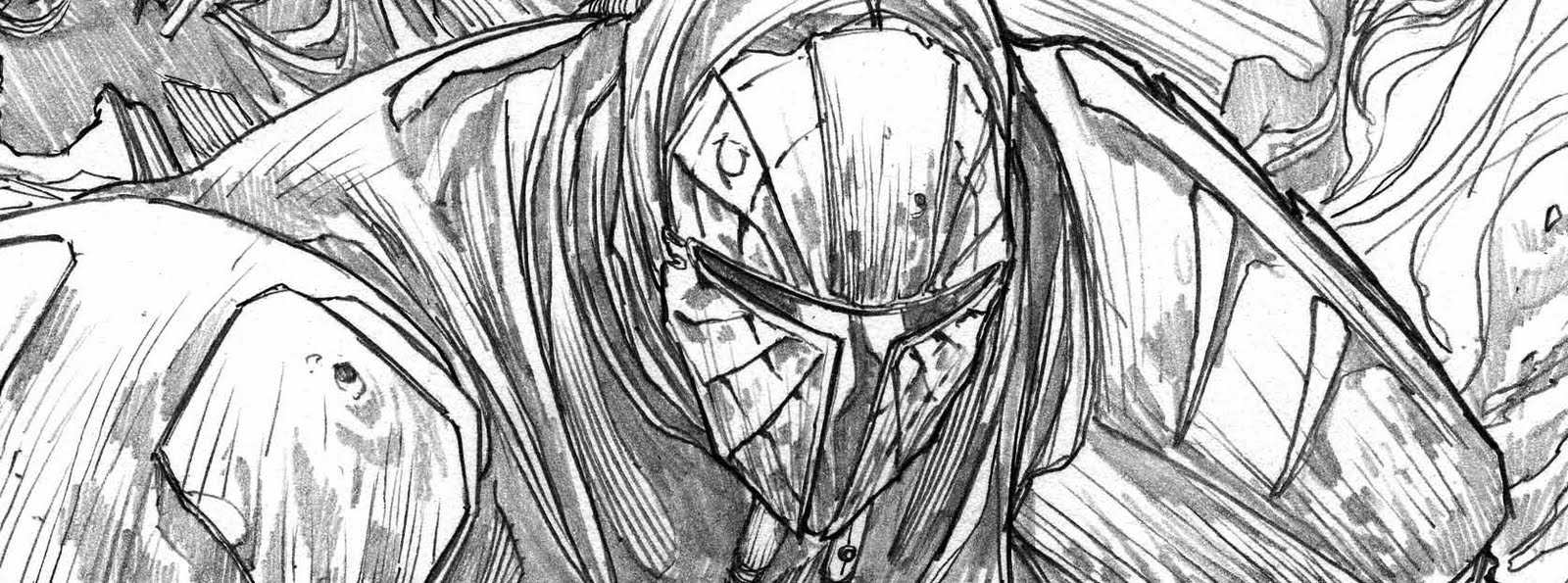
For issue #48, the creative team decided almost immediately to maintain the narrative's focus on the present, as they needed to conserve space. They ultimately abandoned an idea where Demagol's personal history would be intertwined with Rohlan's history of Demagol, as it complicated the issue's flow and would result in Demagol's unreliable account conflicting with visuals. Through issue #48, the creative team linked together elements from virtually every story in the entire series, allowing Miller to reveal that there had been connections to Tales of the Jedi all along—Jarael was genetically related to Arca Jeth. Demagol's appearances throughout the series were specifically designed to primarily showcase his devotion and interest in Jarael and how he ultimately became obsessed with her. Miller discussed Jarael's origin with a geneticist friend, Cathe Smith, to help him understand the biological aspects of the story. The garage where the Rogue Moon Project is headquartered was an extension of what Miller termed an Infinities storyline for the series. If the Covenant had not killed the Padawans and Carrick had not been expelled from the Order, Miller imagined that Carrick would have found work in a garage. This storyline, involving Shel Jelavan, was something Miller had considered from the beginning of the series.
For the space and combat sequences in Knights of the Old Republic 49, Miller initially envisioned the space sequence involving Dace Golliard's capture as lasting a page or so longer, while the combat sequence on Osadia would be shorter. However, Brian Ching developed the space sequence in a way that took up less space, allowing for more action sequences and an interior splash page. Issue #49 finally resolved the issue of Carrick's special relationship with the Force. Miller's experience as a parent led him to consider how children learn and adapt to physics, which in turn led to thoughts on how the Force affects probabilities. Even in his initial proposal, Miller suggested that Carrick existed at a "right angle to the Force" to the point where he couldn't easily manipulate outcomes like other Jedi. His reaching into the Force for a particular result might cause probabilities to waver, creating an unlikely result in an undesirable direction and then further negative or positive effects as the Force re-established equilibrium. Miller's idea was integrated into the series throughout its run. For example, in the first issue, Carrick survives an improbable fall through the Force but lands improbably at the feet of his teachers. This was partially reflected in the Star Wars Miniatures game, where Carrick possessed the abilities of Karmic Luck and Karmic Mettle. For the character of Saul Karath, Miller had always personally considered the dock worker at the Foerost Shipyards who was killed by Ulic Qel-Droma and Mandalore the Ultimate in Tales of the Jedi – The Sith War 1 to be Craddock Karath, Saul's father. He expanded on this theory in issue #49, linking Dace Golliard and Saul Karath by establishing that Golliard's cowardice at Foerost led to Craddock's death. In his production notes for issue #49, Miller finally revealed who he "heard" when writing dialogue for Carrick: the actor Eric Stoltz from around the time of the 1987 film Some Kind of Wonderful.
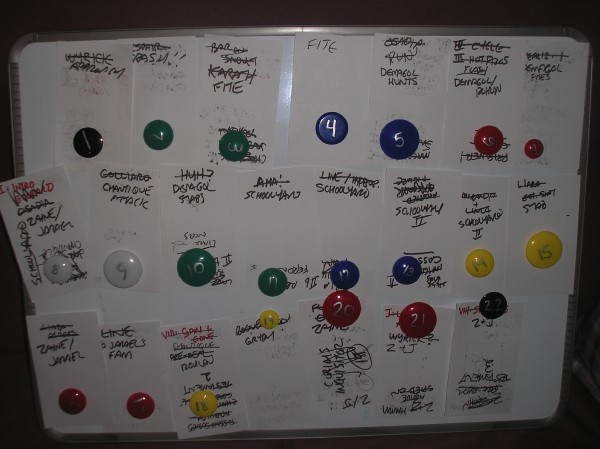
Knights of the Old Republic 50 was released on February 17, 2010 as the series' concluding issue. Prior to its release, Miller ran a "Countdown to KOTOR" series on his blog, answering questions from fans and providing further information on the series' production and development. For issue #50, Miller used a magnetic storyboard to track the events, utilizing magnets created by his son. The magnets helped Miller remember the content of each page and allowed him to rearrange the page cards to connect events. Miller used this method for particularly eventful issues. Miller was uncertain about the final twist of Demagol being Force-sensitive and Jarael lacking Force-sensitivity. This uncertainty led to every scene involving Jarael's "capabilities" being left open-ended regarding whether she possessed powers. The Campaign Guide listed Jarael as "Strong in the Force" because Miller decided to include a mention of the possibility, as Jarael's "powers" would be mentioned in Prophet Motive. While she is not exceptionally strong in the Force, the character does possess some ability. When considering the relationship between Carrick and Jarael, the creative team always felt that Carrick believed a relationship between them was impossible due to their backgrounds. Even before Jarael's age was established, Miller realized that Carrick was too young for her in terms of both age and life experiences. Consequently, the post-Vindication issues, designed around the concept that Carrick would be seeking trouble, addressed this gap. Carrick investigates Jarael's past troubles and attempts to prove himself, failing multiple times, but he earns Jarael's trust in the process. His apology before reuniting her with her parents was seen as an important example of their relationship's evolution.
In his production notes for issue #50, Miller revealed that the source of Carrick's name was North Carrick Hall, his dormitory during his undergraduate years at the University of Tennessee at Knoxville. The sound effect of Carrick's impact when he crashes into the Osadia School is identical to the effect used when Jarael crashed through the skylight of the Jedi Tower, a callback to that scene that had appeared several times in the series. For the final scene with Chantique and Demagol, Brian Ching carefully established the location of Carrick and Kun's lightsabers on the ground. The entire page, depicting Demagol's first active attempt at telekinesis, took less than a second in terms of the story. The ending for Rohlan Dyre, where the Mandalorian resumes his quest for answers, was one that Miller had always envisioned for the character. Hierogryph was one of Miller's favorite characters to write in the entire series, and the writer also managed to include closing moments with some of the series' main characters, such as Elbee and Slyssk. Demon was collected in the ninth and final trade paperback of the original series, Star Wars: Knights of the Old Republic Volume 9: Demon, on October 21, 2009. Miller always intended to follow up the first two overarching arcs of the series—the "Fugitive" and "Freelancer" story arcs—with a "Footsoldier" arc, but the series ended before he could continue. The writer would continue the planned storyline in the miniseries Star Wars: Knights of the Old Republic: War, which picked up some of the story elements and characters from the original series that Miller had intended to expand on in future storylines, such as Dallan Morvis.

The planet Taris serves as a key setting within the Knights of the Old Republic comic series, offering expanded lore on the world initially presented in the Knights of the Old Republic game. The rakghouls and Gamorreans encountered by the Covenant within the Undercity directly reference the Knights of the Old Republic game, where they appear as enemies in the same location. The Hidden Beks and Black Vulkars, prominent swoop gangs featured in the comics, originated in the video game. Several characters associated with these groups, including Gadon Thek, Zaerdra, Mission and Griff Vao, and Brejik, reappear within the comics, set several in-universe years prior to their game appearances. Kebla Yurt's Equipment Emporium, a shop accessible to players within the game, receives mention in The Taris Holofeed: Invasion Edition. Additionally, in issue #25, Hierogryph and Carrick explain to Celeste Morne their expulsion from the Outcasts, the primary inhabitants of the Undercity in the game.
The design of the Jedi Enclave on Dantooine, along with the composition of both the Dantooine Jedi Council and the Jedi High Council, are directly adapted from the Knights of the Old Republic games. Characters such as Vandar Tokare, Zhar Lestin, Atris, Vrook Lamar, and Zez-Kai Ell make appearances across various issues, originating from the video game. The sole exception is Master Dorak, who does not appear in the series due to his absence from the Dantooine Council at this time; his seat is occupied by Bala Nisi, a character who debuted in Shadows and Light in Star Wars Tales 23. Another character from Shadows and Light, the Jedi Cale Berkona, appears in several issues as a member of the Revanchists. Cassus Fett, first mentioned in the initial game, receives significant development as a recurring character throughout the series. The naming of the droid T1-LB is intended as a reference to the T3-series of droids from the video games, with numerous T3-series droids appearing throughout the comic series. The Handbook establishes a connection between the names, stating that Duwani Mechanical Products acquired the T1 trademark and repurposed it for their T1-series utility droid.
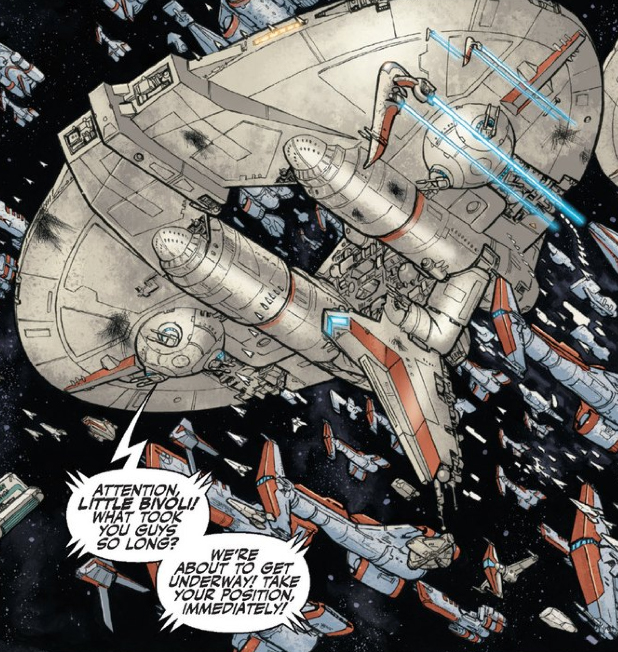
The Hammerhead-class cruiser of the Republic and the Ministry-class orbital shuttles, both seen in various issues, were initially introduced in video games, as was the S-250 Chela-class starfighter featured in Days of Fear. Notably, the Days of Fear story arc referenced many aspects of prior continuity. The HK-24 assassin droids used by Adasca represent early iterations of the HK-series, the same droid line as the companion HK-47 from the original KotOR game, and their manner of speaking mirrors that of HK-47. Carth Onasi, a companion from Knights of the Old Republic, is known for his lengthy answers to simple questions, a trait echoed in Days of Fear. The Battle of Serroco, initially mentioned in The Sith Lords, was further explored and depicted in Days of Fear, Part 3. In chronological order, the first mention of the Interdictor-class cruiser appeared in The Admiral's List: Jimas Veltraa Memorial Edition, though the Leviathan in the first Knights of the Old Republic game was its first appearance overall.
Fans often speculated that the characters Squint and the Revanchist would become Darth Malak and Revan, two significant characters from the Knights of the Old Republic game. This connection, however, remained unconfirmed until the release of Jedi vs. Sith: The Essential Guide to the Force, a reference book released on November 27, 2007. The comic series directly acknowledged Malak's connection to Squint in issue #31, and issue #42 showed the Revanchist taking on the name "Revan" and acquiring his signature mask. Speculation also arose among fans that Lucien Draay would become Darth Sion, a major antagonist from The Sith Lords, but Miller never intended them to be the same. In Vindication, Haazen suggests Lucien adopt a Darth name such as Darth Luzion or Darth Sion. In issue #35, Draay admits he would have become the Lord of Pain had he embraced the dark side. However, the Knights of the Old Republic Campaign Guide clarified that Darth Sion and Lucien Draay were distinct individuals, noting that Darth Sion participated in the Sith War.
Several Mandalorian ships that were seen in Tales of the Jedi reappear within Knights of the Old Republic. Like the Mandalorians themselves, their designs have evolved over the decades following the Great Sith War. The Shaadlar-type troopship and Kyramud-type battleship both debuted in Tales of the Jedi: The Sith War 1: Edge of the Whirlwind, and they are also present, with slight modifications, in several scenes depicting the Mandalorian Wars. The Basilisk war droid, another Mandalorian vehicle from Tales of the Jedi, is a common sight in Knights of the Old Republic. Similarly, the Crucible's Gladiator uses a ship design taken from the background of the Foerost Shipyards in Edge of the Whirlwind. Issue #33 includes an extensive flashback to various points in Haazen's life, covering elements and characters introduced in Tales of the Jedi and West End Games' Tales of the Jedi Companion. Although the creative team opted not to show the Sunrider family, who were intended to be the focus of the then-forthcoming novel Mandorla, they connected the two comic series by featuring Arca Jeth and the Sith War. Krynda Draay's Miraluka father is revealed to be Noab Hulis, the Jedi who rehabilitated the fallen Jedi Chamma. Chamma is the eventual teacher of Andur Sunrider, and Noab Hulis was first mentioned in the Tales of the Jedi Companion.
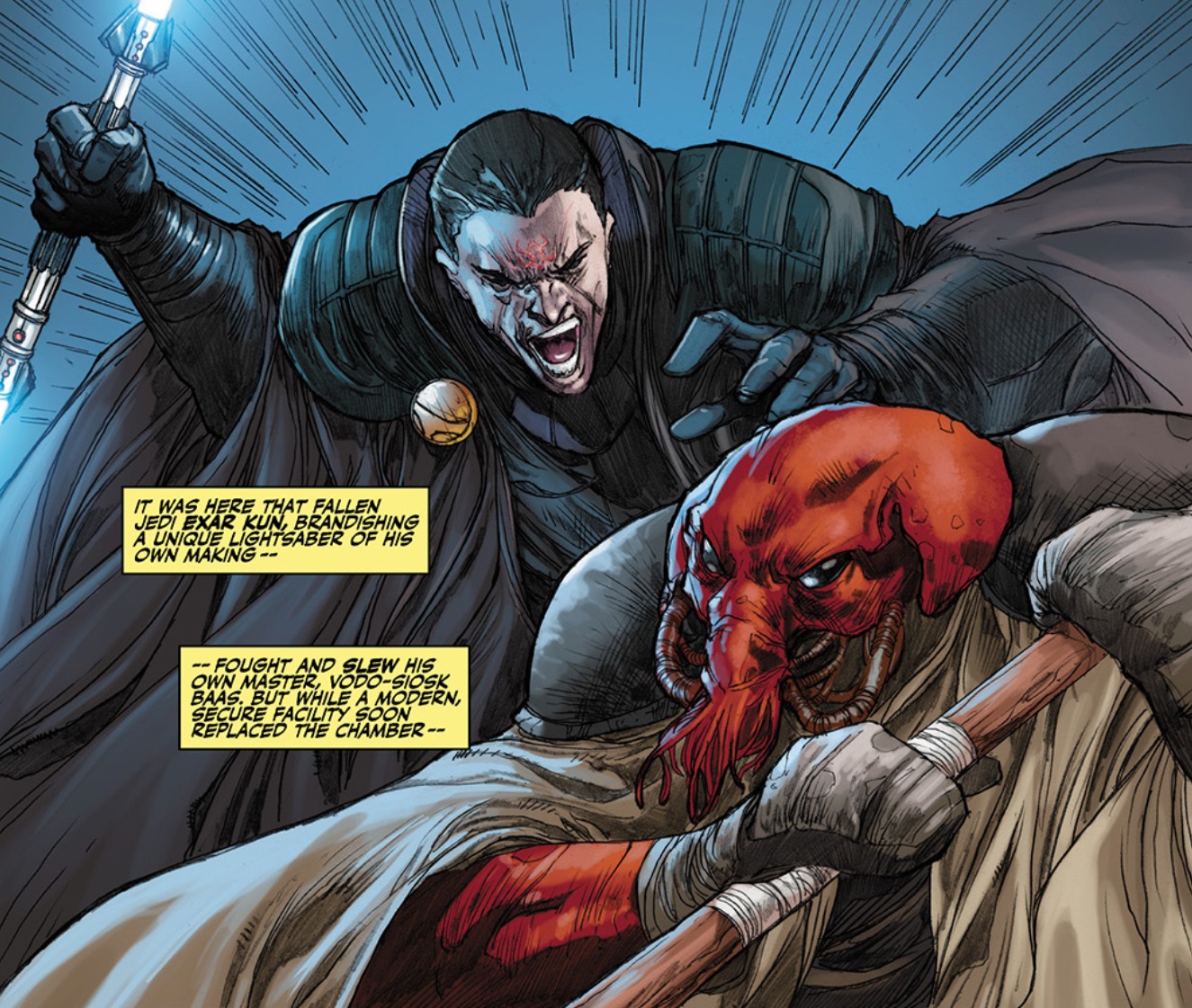
The Krevaaki Vodo-Siosk Baas is represented by a statue in issue #32, having been established earlier in issue #9 as Krynda Draay's teacher. Issue #47 features a flashback to the duel between Exar Kun and Baas from Tales of the Jedi – The Sith War 3. Issue #48 also contains flashbacks to events of the Great Sith War, such as Ulic Qel-Droma's battle with Mandalore the Indomitable. Exar Kun's double-bladed lightsaber plays a significant role in the Demon arc as a Sith artifact, and it ultimately causes the deaths of Demagol and his daughter Chantique when Demagol summons the wrong lightsaber, impaling both himself and Chantique. The Covenant's term for the failsafe method of destroying the Sanctum of the Exalted, Option Ossus, is a reference to the Cron Cluster, the star cluster containing Ossus, which was devastated by the Cron Supernova during the Sith War.
The Vector and Vindication arcs introduce a number of artifacts whose names and original owners reference characters from Tales of the Jedi: the Eye of Horak-mul, Jori Daragon's amulet, the Epistle of Marka Ragnos, the Helm of Dathka Graush, and the Gauntlet of Kressh the Younger. The Helm of Dathka Graush is nearly identical to a helmet worn by a Sith during a flashback in Tales of the Jedi – The Golden Age of the Sith 2. However, the 2012 reference guide Book of Sith: Secrets from the Dark Side identified the character in that image as Hakagram Graush, the last Sith king of Korriban before the arrival of the Exiles. Despite sharing the same last name, no official connection has been established between Hakagram and Dathka, or between the Helm of Dathka Graush and Hakagram's helmet.
The Knights of the Old Republic series depicts the Mandalorians in a state of transition between the diverse armor styles seen in Tales of the Jedi and the uniform, color-coded Neo-Crusader armor from the video games. John Jackson Miller intentionally evolved the appearance of Mandalorian armor throughout the series, providing an in-universe explanation: Mandalore the Ultimate sought to create a more regimented fighting force as his ranks swelled with recruits from various backgrounds. The passenger liner Chancellor Fillorean is named after Fillorean, a Supreme Chancellor first mentioned in the 2003 Coruscant and the Core Worlds sourcebook by Wizards of the Coast. The Resol'nare, or Six Actions, of Mandalorian culture, featured in issue #26, were originally created by Karin Traviss for her work on Mandalorian culture, and Mando'a—the language developed by Traviss—appears in numerous issues of the comic series.
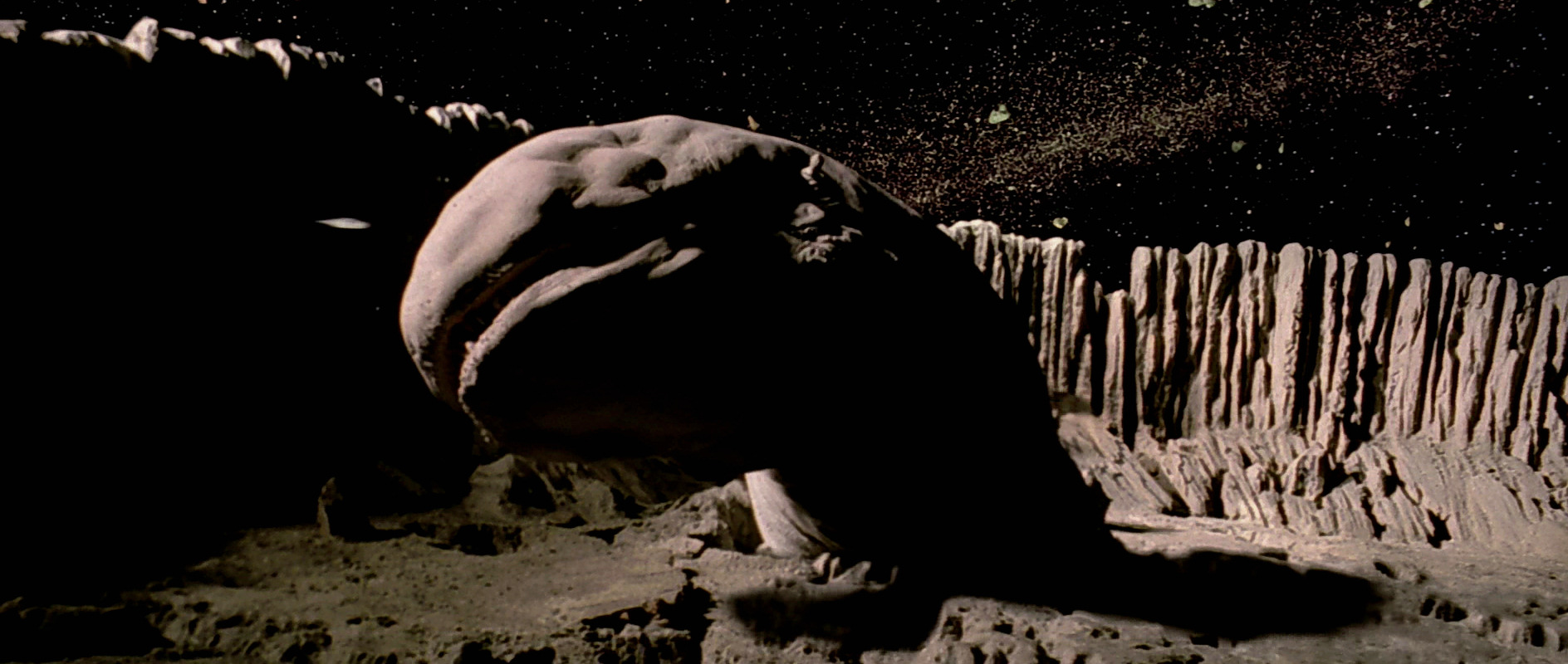
The creative team conceived the debris field in the Taris system and the Rogue Moon, while other unique locales introduced in the series include Vanquo, Flashpoint, the banking planet Telerath, the Feeorin homeworld Odryn, Osadia, Metellos 3, Omonoth, and Volgax. The magnetic suction tubes used in issue #5 were first seen on the Jawa sandcrawler in A New Hope. The Last Resort's maneuver of leaving an asteroid field to make a clear transmission was a nod to the asteroid scene in The Empire Strikes Back. The exogorths, or space slugs, which first appeared in The Empire Strikes Back, have their scientific name revealed for the first time in issue #18 of Knights of the Old Republic. Knights of the Old Republic also featured members of several lesser-known species, including Hamadryas, Skrillings, Ho'Din, Nagai, Besalisks, Khil, Ishi Tib, Drovians, Arkanians, Dashade, Sanyassans, Caamasi, and Zeltrons. Many of these species originated in the early Marvel comics or as patrons of Chalmun's Spaceport Cantina in A New Hope, and have made only occasional appearances since their initial introductions.
The concept of a Jedi Shadow originated in the roleplaying games created by West End Games, as did many other elements within the series. The planet Wor Tandell was first mentioned in the first edition of the Galaxy Guide 3: The Empire Strikes Back, and the Iskalloni species that raised Antos Wyrick were introduced in the West End story The Iskallon Factor. Miller used West End's Player's Guide to Tapani to develop the backstory of the Moomo Williwaw, and the name of the Hot Prospect's ship class, a Calipsan 560 mining ship, is derived from the planet Calipsa, another creation of West End. The Krish species' obsession with gaming was established in previous West End sources, and the name of the Little Bivoli comes from Bivoli Tempari, a food item found in Star Wars Galaxies that originated in the 1989 roleplaying game book Riders of the Maelstrom by West End.
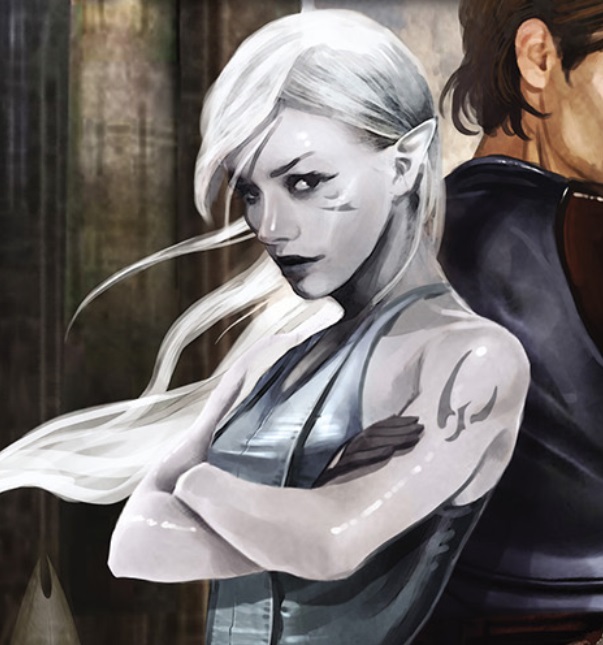
The Knights of the Old Republic comic series has maintained a relatively consistent continuity with previous works. In Commencement, Part 3, Marn Hierogryph mentions the substance bacta, which, according to established lore, did not exist during the series' timeframe, as kolto served as its equivalent. This error remained uncorrected in the Commencement trade paperback, and Miller suggested several possible solutions. However, the 2009 reference guide The Essential Atlas retroactively changed the date of bacta's initial availability in the galaxy to around 4100 BBY. The introduction of Jarael and Camper led to some fan confusion regarding their pupils, five-fingered hands, and white skin. Previous depictions of Arkanians showed them with golden skin, three-fingered clawed hands, and no pupils. These discrepancies were later explained as a plot point, revealing them to be Arkanian Offshoots, a genetically modified subspecies of Arkanians. Jarael's pointed ears were revealed in issue #50 to be a result of her Sephi heritage from Jeth's genetic material.
Knights of the Old Republic achieved an average sale of 21,043 copies per issue in comic book shops worldwide. Specifically, 2006 saw an average of 23,256 copies sold, while 2007 had an average of 22,603 copies. In 2008, the average sale was 22,080 copies, and the remaining issues averaged 16,968 copies. The series' sales and rankings, compared to other comics, decreased over time, mirroring the overall decline in the comics industry. Starting around 24,000 copies and ending around 16,000 copies, the series experienced a notable drop following the Vector arc. The four issues of Vector performed particularly well, averaging 24,565 copies sold, while the issues immediately preceding and following the arc sold only 20,383 and 22,036 copies, respectively. Knights of the Old Republic holds an average rank of 107 in terms of monthly comic sales, and it stood as Dark Horse's fifth-highest selling series on average during its run. Early in its run, it was typically Dark Horse's third or fourth series, but the debuts of Star Wars: Legacy and Buffy the Vampire Slayer pushed Knights of the Old Republic down in the rankings. Conan also consistently outsold Knights throughout most of its run, becoming Dark Horse's top-selling series in 2006 before the arrival of Buffy and Legacy. Up until the Vector arc's conclusion, Knights of the Old Republic ranked between 80 and 120 in monthly sales. However, as the series progressed into 2008 and 2009, its ranking declined, ranging from 100 to 130.
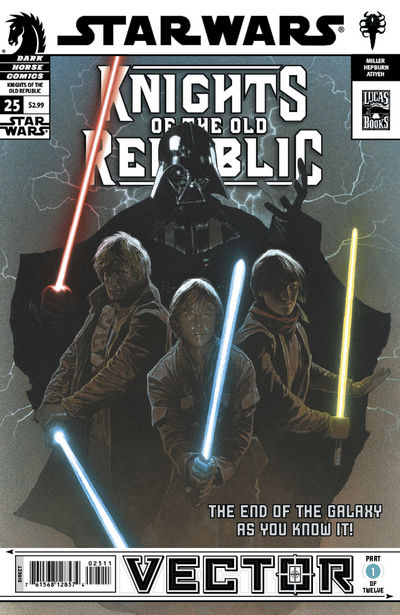
Knights of the Old Republic 25: Vector, Part 1 and Knights of the Old Republic 28: Vector, Part 4 achieved the highest sales figures for the series, with 25,015 and 25,101 copies sold upon their release. The Flashpoint, Reunion, and Days of Fear arcs also performed well, with sales ranging from 23,000 to 25,000 copies. The Knights of Suffering arc had the lowest sales prior to Vector, while Knights of the Old Republic 40: Dueling Ambitions, Part 2 and Knights of the Old Republic 49: Demon, Part 3 were among the lowest-ranked issues in terms of sales for the remainder of the series.
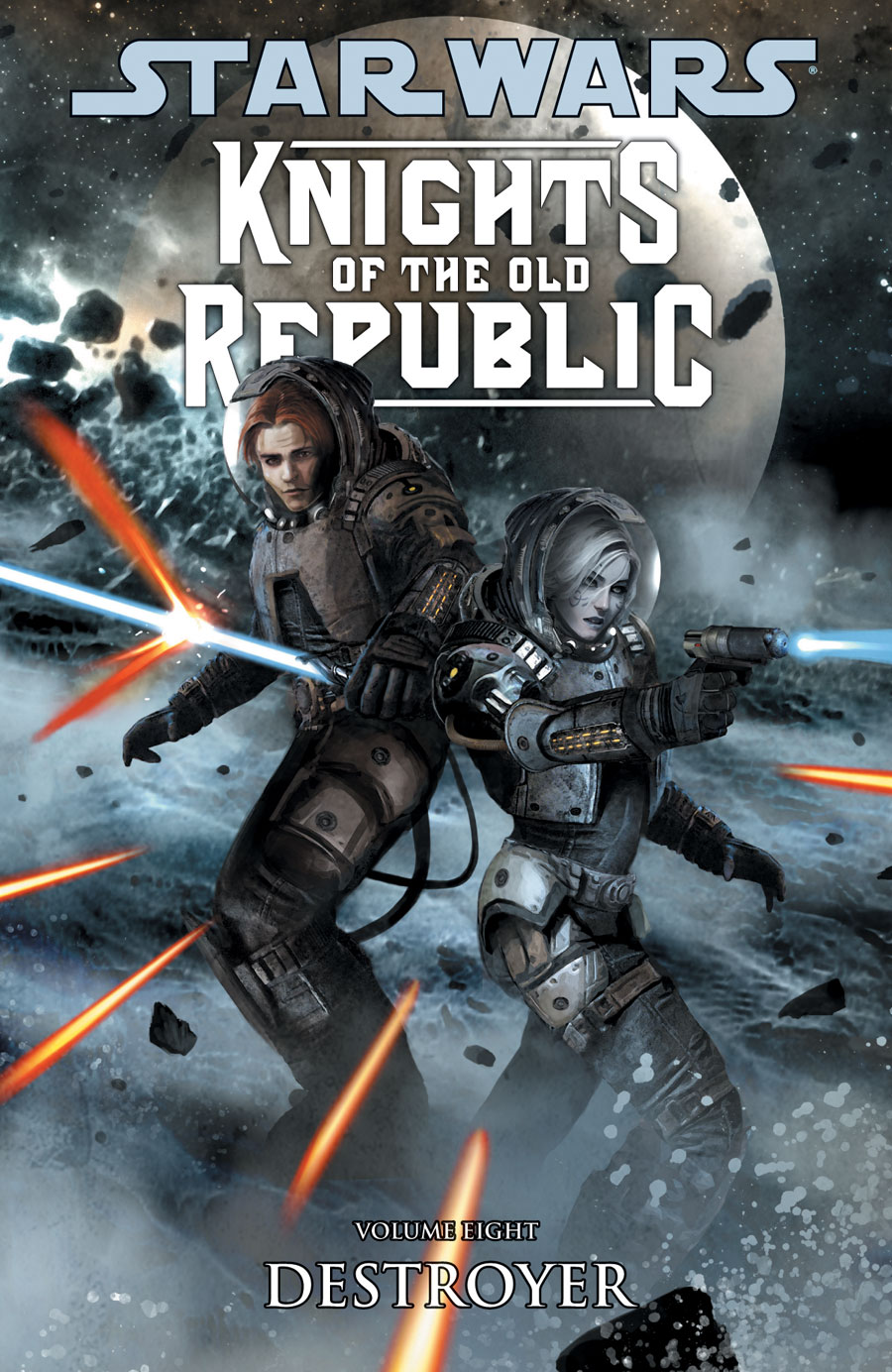
Regarding trade paperback sales, Knights of the Old Republic averaged 3,248 copies sold for its nine trade paperbacks, excluding the tenth volume that collected the War miniseries. The paperbacks ranked 18th on average in their respective months, and they were Dark Horse's first, second, or third highest-selling paperbacks in their respective months, with the exception of Volume 3. Volume 3 was released in January 2008, a month in which Dark Horse released nearly a dozen trade paperbacks. Similar to the individual issue sales, the Vector arc was the best-selling paperback for the series, selling just under 4,000 copies when it was released in January 2009.
Knights of the Old Republic was highlighted in several issues of Star Wars Insider magazine during its run. Departments such as Jawa's Corner and Blaster occasionally featured segments discussing upcoming issues and arcs within their coverage of future Star Wars products.
As part of the Knights of the Old Republic metaseries, the Knights of the Old Republic comic series has also generated its own related content, including three short stories, a sequel miniseries, a handbook, and a role-playing campaign guide. The Star Wars: Knights of the Old Republic Handbook was a one-shot handbook, similar to Dark Horse's earlier Star Wars Handbook 1: X-Wing Rogue Squadron and Star Wars: Legacy's preview issue #0. Released on November 7, 2007, coinciding with issue #22 of Knights of the Old Republic, the Handbook summarized and expanded upon information regarding the characters, locations, and ships featured in the comic series. It included art from the series and additional artwork by the series' artists, as well as backstories that John Jackson Miller had been unable to incorporate into the main series at that time, and details about upcoming arcs, such as the Muur Talisman from Vector and Nunk Plaarvin from Prophet Motive. The Knights of the Old Republic Campaign Guide serves as a supplementary reference book for Wizards of the Coast's Star Wars Roleplaying Game, incorporating elements from the video games, the comic series, and even Tales of the Jedi. John Jackson Miller contributed to the guide, which features several of the main characters from the comics. The Campaign Guide also provides names for various ship classes that had appeared in the comics but had not been officially named. In August 2008, Wizards of the Coast released a Knights of the Old Republic expansion for their Star Wars Miniatures game, featuring characters from both the video games and the comic series.
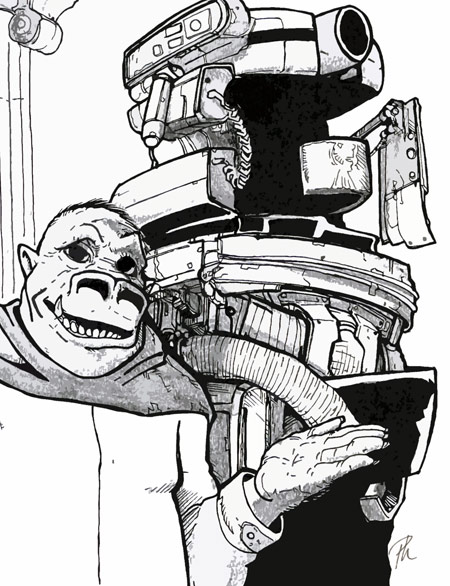
"Labor Pains" is a short story authored by John Jackson Miller, set between issues #12 and #13 of the comics, and was initially released exclusively to the Hyperspace fan club on April 9, 2008. Originally envisioned as a promotional short story for Star Wars Insider, Miller completed the story upon learning that StarWars.com planned to present original fiction in 2007. "Labor Pains" is narrated in first-person from Marn Hierogryph's perspective, focusing on his and Carrick's attempt to defraud an art gallery on Ralltiir. Miller's second Knights of the Old Republic short story, "Interference," was also published on Hyperspace on September 29, 2008, allowing him to expand on an idea initially intended for the in-universe text pages of the series: a propaganda broadcast by Captain Goodvalor. "Interference" follows a series of broadcasts by Captain Goodvalor, a Republic propaganda figure, and the reactions of Mandalorian Koblus Sornell to these broadcasts, set between the Daze of Hate/Knights of Suffering arcs and the Vector arc. Sornell later appeared as a main character in the War miniseries, and the backstory of the Goodvalor character was finally revealed in issue #47. The Secret Journal of Doctor Demagol, released on April 29, 2010, was initially conceived by Miller as a means to illustrate Demagol's thoughts throughout the entire comic series. Miller approached StarWars.com's editor Pablo Hidalgo about the story, which was subsequently published on Hyperspace. The story follows Demagol throughout the Knights of the Old Republic series, from Commencement to Demon, and allowed Miller to further develop Demagol's plans for Jarael and his relationship with Chantique's mother.
On October 13, 2011, Dark Horse announced a sequel miniseries to Knights of the Old Republic: Knights of the Old Republic: War, also styled Knights of the Old Republic—War. Written by John Jackson Miller, who suggested the return to the Old Republic era in 2011, the miniseries was illustrated by Andrea Mutti. The series' title was inspired by the similarly titled Star Wars: Legacy—War miniseries, a sequel to Star Wars: Legacy. Essentially a continuation of the original series, War incorporates numerous references and elements from the previous series, and utilizes Miller's original plans for future storylines in Knights of the Old Republic. Set in 3962 BBY, the year following the original series, War primarily focuses on Zayne Carrick as he is drafted by his homeworld Phaeda to serve in the Mandalorian Wars. War represents the realization of Miller's plan for a "Footsoldier" arc in the original series, and addresses several unresolved elements and plot points from the original series' cancellation, such as the characters of Dallan Morvis, whom Miller developed over the course of the original series for his role, and Koblus Sornell, who appeared in Interference. War was collected in a trade paperback titled Star Wars: Knights of the Old Republic Volume 10: War, continuing the numbering from the original series' paperbacks. The series' entire 51 issues were later compiled into three Star Wars Omnibus volumes, released in August 2013, December 2013, and April 2014, respectively. Star Wars Omnibus: Knights of the Old Republic Volume 1 was reprinted as Star Wars Legends Epic Collection: The Old Republic Vol. 1 by Marvel Comics in June 2015.
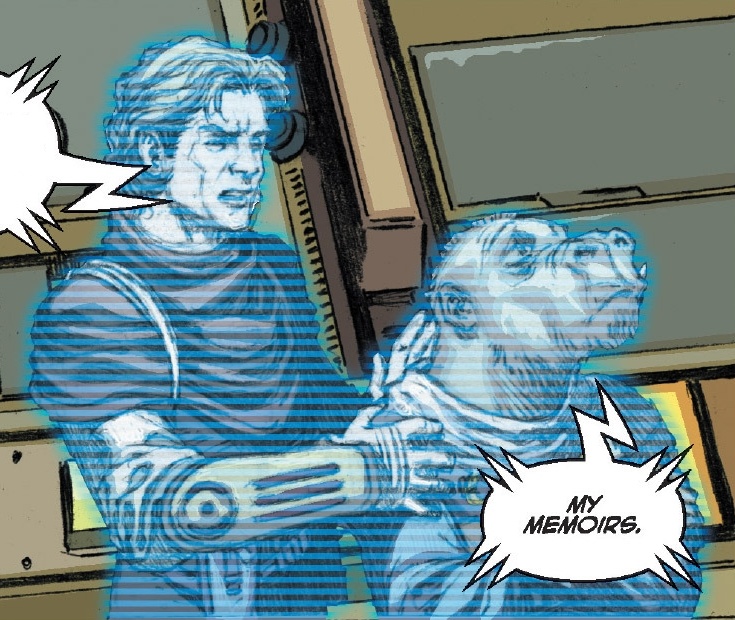
John Jackson Miller also penned Star Wars: Knight Errant and Star Wars: Lost Tribe of the Sith—Spiral, both comic series that have made references to and further developed concepts Miller originated in Knights of the Old Republic. The Helm of Ieldis, an artifact crafted by Ieldis, takes center stage in the Knight Errant storyline called Escape. Remulus Dreypa, who sealed Celeste Morne in the oubliette at the conclusion of Vector, Part 4, is the main villain in the Lost Tribe series. As a direct continuation of Miller's series of short stories, Lost Tribe of the Sith, Spiral includes more references to Knights of the Old Republic: Jelph Marrian, a Jedi Shadow, was initially mentioned in issue #25, and Miller utilized Marrian to explore the reactions of other Covenant members following the events of Vindication. The character Seelah Korsin, who was responsible for the care of Ludo Kressh's feet, also makes a reference to Ludo Kressh's pedicure set, which debuted in issue #29. Knights of the Old Republic elements crossed over into other series during the Vector event: Hierogryph appears in a holorecording with Carrick in Dark Times 11: Vector, Part 1, and while Rebellion 16 only mentions Carrick, he is featured in a flashback and a vision experienced by Celeste Morne in Legacy (2006) 28 and Legacy (2006) 31. Celeste Morne, Karness Muur, and the Muur Talisman, considered the "main characters" of the Vector crossover, are present in all twelve issues of the event and are referenced in several subsequent issues of Legacy.
Referencing elements from the Knights of the Old Republic comic series, Miller's novelization of the comic series, Knight Errant, mentions Dallan Morvis, Ieldis, Telettoh, and Jimas Veltraa. The novel also identifies the Adasca affair as the "First Battle of Omonoth." The Sword of Ieldis is the name of a ship commanded by the Sith Lord Odion, while the Sith Arkadia Calimondra commands the New Crucible; both names were intentionally included as in-universe references to elements from the comic series. Similarly, the cannon "Bitsy" is mentioned as having been recovered from a derelict ship, and Miller confirmed in his production notes for the novel that "Bitsy" was the cannon from the Moomo Williwaw, although the novel does not explicitly identify the derelict as the Williwaw. Knight Errant introduces Telettoh's Maxim—"Never let Malak aboard"—as a cautionary tale regarding Sith Lords on vessels. The book also provides the name of the sixth and final ship of the Inexpugnable-class: the Diligence. The Kedorzhan species, which was first introduced in issue #2, has appeared in multiple issues of Knights of the Old Republic, as well as in other works by Miller, such as the Knights of the Old Republic Campaign Guide and the short story Incognito. Telerath served as the primary setting for Blue Harvest, the Dark Times story arc that directly followed Vector.
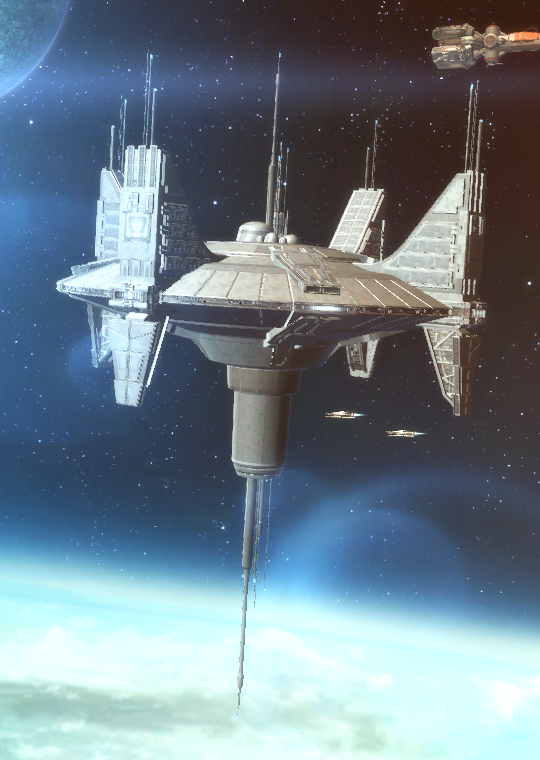
Set three centuries after the events of the Knights of the Old Republic games and comics, the 2011 video game Star Wars: The Old Republic is replete with references to the games, comic series, and Tales of the Jedi. The game's Codex features a series of entries in the Galactic History section that summarize the Mandalorian Wars and the key events of the comic series, with particular emphasis on Commencement, Vector, and Vindication. Upon its release, forty-seven of The Old Republic's servers were named after elements from the comics. Server names were derived from all of the main characters in the comic series, with the exception of Shel Jelavan, as well as from nearly twenty items and locations, including "Jebble War Forge" and "Vanjervalis Chain." Even some minor characters, such as Dace Golliard, Lord Ieldis, Karness Muur, Senator Goravvus, and Goethar Kleej, served as the basis for server names, as did the eight primary ships featured in the series: the Courageous, Deadweight, Chancellor Fillorean, Arkanian Legacy, Swiftsure, The Last Resort, Hot Prospect, and the Moomo Williwaw. Carrick Station, the Republic hub in The Old Republic, is named in honor of Zayne Carrick. Two of the Republic bases on Taris, Waypoint Station Draay and Waypoint Station Morne, are also named after characters from the comics. The game's crewskill system contains several missions that allude to the comics; for example, the mission "The Butcher's Lab" centers around one of Demagol's laboratories. Other crewskill missions involve the Rogue Moon, Odyrn, the bombardment of Serroco and its underground shelters, exogorths, and Remulus Dreypa.
Gorman Vandrayk is also mentioned multiple times—conversations with the Jedi Consular companion Tharan Cedrax revolve around Cedrax's efforts to construct a Vandrayk Generator, a device theorized by Vandrayk to operate on a nonexistent form of energy. During the Grand Acquisitions Race World Event, players were tasked with finding a Vandrayk's Tuning Apparatus. Adascorp plays a significant role in the Bounty Hunter class storyline on Quesh, a storyline that also reveals Adascorp's partnership with the Draay Trust. Brassk's Trandoshani Flatcakes, a company that sponsors the sport of Huttball and claims to be the only provider of authentic fruit from Kashyyyk, sells Trandoshani flatcakes with fruit, a dish discovered by Slyssk in issue #15. A Codex entry detailing the history of Makeb in The Old Republic's Digital Expansion Rise of the Hutt Cartel mentions Semako Thalien, a business tycoon during the Mandalorian Wars; while he shares a surname with Jervo Thalien, the Skrilling who appeared in the comics, no connection between them has been established. Rise of the Hutt Cartel features a sarcophagus created by Karness Muur, which contains the rakghoul known as Patient Zero. On Taris, a Republic mission focuses on the ruins of the Jedi Tower, and a Jedi Knight class mission involves disrupting the sale of scavenged Jedi Covenant artifacts by a pirate.
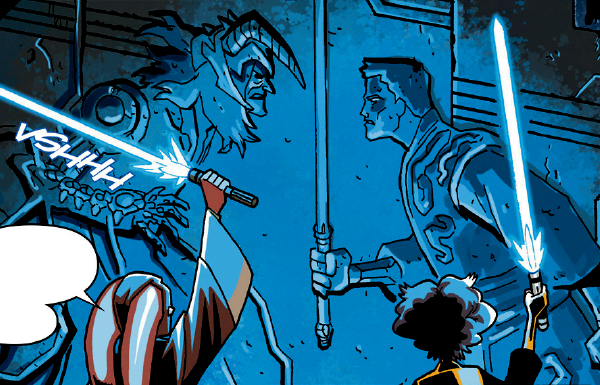
Serving as a "sequel" to the conclusion of Vindication, the 2013 comic The Clone Wars: Defenders of the Lost Temple revisits Lucien Draay's fate nearly four millennia after the events of Knights of the Old Republic. Taking place during the Clone Wars between the Republic and the Confederacy of Independent Systems, Defenders of the Lost Temple is set on Draay 2, the moon where Lucien Draay established his "true Covenant" ages ago. The story centers around a mission led by Jedi Master B'ink Utrila to recover the Gauntlet of Kressh the Younger. Inside the temple, a towering statue of Lucien Draay holding Haazen's severed arm is revealed to be a guard droid. A carving on the temple walls depicts the battle between Haazen and Draay, and the Gauntlet is concealed within the structure. However, when Utrila touches the Gauntlet, she is overwhelmed by its dark side power and retreats. Later, the temple is attacked by the Mandalorian Death Watch, and a clone trooper seemingly sacrifices himself to destroy the entire temple. Unbeknownst to the other clone troopers and the Mandalorians, the trooper survives due to the Gauntlet, which he subsequently throws into a nearby river. The comic never explicitly names Haazen, Lucien Draay, or Vindication.
Single-page in-universe news organs were included with various issues of Star Wars: Knights of the Old Republic. This feature, which debuted in issue #0 and continued throughout the Days/Knights cycle, was discontinued in 2008. These included:
- The first of the in-universe news organs to accompany Knights of the Old Republic, The Taris Holofeed represented an in-universe version of the Taris Holofeed news outlet. The Taris Holofeed: Prime Edition , which accompanied issue #0, mentioned the planet Suurja—where the Revanchists would be captured in issue #6—as well as Zovius Mendu, a character mentioned in issue #3, and identified each of the Taris Padawans along with their species. The Prime Edition also contained an article on "Baron Hieromarn," another alias used by Hierogryph. [28] The Taris Holofeed: Siege Edition , which accompanied issue #15, foreshadowed the upcoming Knights of Suffering arc set on occupied Taris and expanded on characters such as Senator Goravvus and his relationship with Lhosan Industries—a plot point in the Knights of Suffering arc. [206] The Taris Holofeed: Invasion Edition , which accompanied issue #18, depicted the early stages of the Mandalorian invasion and referenced Kebla Yurt's Equipment Emporium, a location from the Knights of the Old Republic video game. [159] The Taris Holofeed Special Proclamation , the fourth and final edition of the Holofeed, accompanied issue #21 and took the form of a speech delivered by Cassus Fett to the people of Taris. Fett declared Taris free from all allegiances to the Republic and deactivated the Taris Holofeed at the conclusion of his speech. [207]
- The Admiral's List was a Republic Navy news source that provided updates on recent events, promotions, and interviews with Navy personnel. The Admiral's List: Jimas Veltraa Memorial Edition , which accompanied issue #13, commemorated Admiral Jimas Veltraa—a character first mentioned during the Battle of Vanquo in issue #8. The article also introduced the Interdictor -class of capital ship, the same class that would later appear as Karath's Leviathan in the Knights of the Old Republic game, and mentioned Carth Onasi's promotion to Lieutenant. [162] The Admiral's List: Remember Serroco! Edition , which accompanied issue #16, served as a direct follow-up to the bombing of Serroco depicted in that issue. The Little Bivoli was listed among the confirmed casualties from the battle. [208] The Admiral's List: Karath Home Safely , which accompanied issue #22, followed up on the events of the Daze of Hate arc. It featured a memorial for Lord Adasca that also mentioned an attempt by the Draay Trust to acquire Adascorp, and documented Admiral Karath's return to Coruscant after the Adasca affair. [209]
- The Adjudicator served as an in-universe news source for bounty hunters, providing information on major bounties, new equipment, and events relevant to the bounty hunting profession. The Adjudicator Special Report: The Outer Rim , which accompanied issue #14, listed bounties for Hierogryph, Carrick, the Corellian Strangler "Kelven Garnatrope," and Baron Hyro Margryph. The Corellian Strangler would be further developed in issue #38, and the bounty on "Hyro Margryph"—the alias used by Camper to access Hierogryph's accounts on Telerath in issue #11—followed up on Adascorp's identification of Margryph as Gorman Vandrayk and their desire to capture him. [210] The Adjudicator Special Report: Tools of the Trade , which accompanied issue #20, discussed the HK-24 droids used by Adascorp and featured bounties for Hierogryph and the Corellian Strangler, although Carrick's bounty had been removed following his apparent death on the Courageous . The article also mentioned the cancellation of the bounty on Baron Margryph. [211] The Adjudicator Special Report: The Colonies , which accompanied issue #23, listed bounties for the Corellian Strangler, Hierogryph, Carrick, and Slyssk. The article also revealed that Adascorp had issued the bounty on Margryph and had purchased the entire HK-24 production line to ensure its success. Lhosan Industries had also increased Hierogryph's bounty following the failure of Jervo Thalien's attempt to use the Snivvian to assassinate Senator Goravvus. [212]
- Adascorp Fiscal Period Financial Report and Outlook was an in-universe corporate document from Adascorp, a major faction in the Days/Knights cycle. Adascorp Fiscal Period Financial Report and Outlook: Message from the Chief Executive , which accompanied issue #17, mentioned previous elements from the comics, such as the fall of Vanquo and the Draay Trust. The news organ also revealed Lord Adasca's first name as Arkoh. [213] Adascorp Fiscal Period Financial Report and Outlook: Field Report: Project Black Harvest , which accompanied issue #19, presented a field report on Gorman Vandrayk's work weaponizing exogorths thirty-three years before the events of the comic series. The report, whose name alludes to Episode VI's production title "Blue Harvest," provided insight into the reasons why Vandrayk abandoned his work at Adascorp. [214]
- Galactic Republic Defense Ministry Daily Brief KD0092 was the final news organ of the series and accompanied issue #24, the last issue in the Days/Knights cycle. The news organs were discontinued after the cycle's conclusion. The article, presented as an official Republic governmental document, discussed various elements and events that occurred throughout the Days/Knights cycle. [215]
-
Star Wars: Knights of the Old Republic (comics) on Wikipedia
-
Star Wars: Knights of the Old Republic on Dark Horse Comics' official website (backup link)
-
Star Wars: Knights of the Old Republic on Faraway Press: The Online Home of John Jackson Miller (backup link)
-
Related categories: